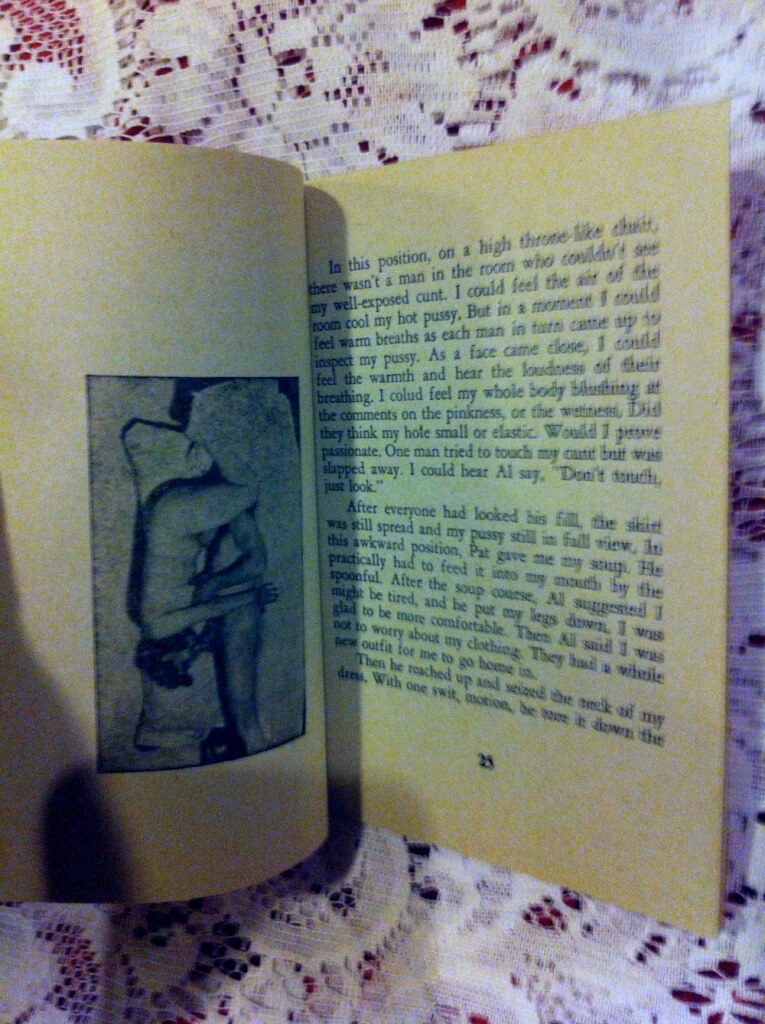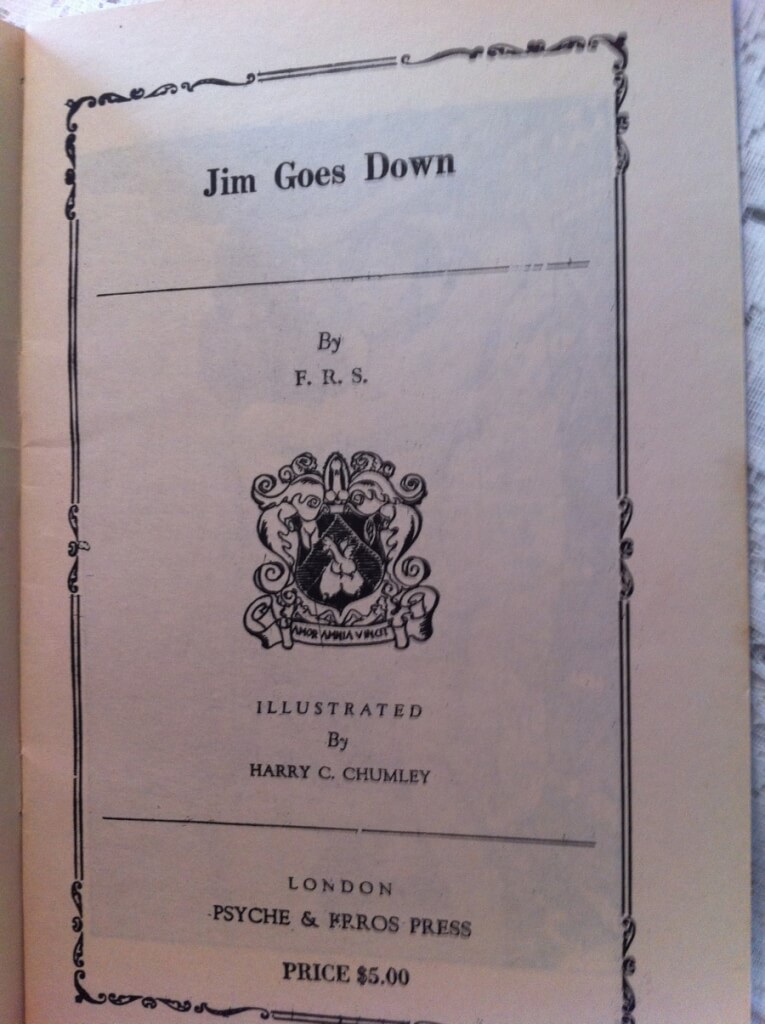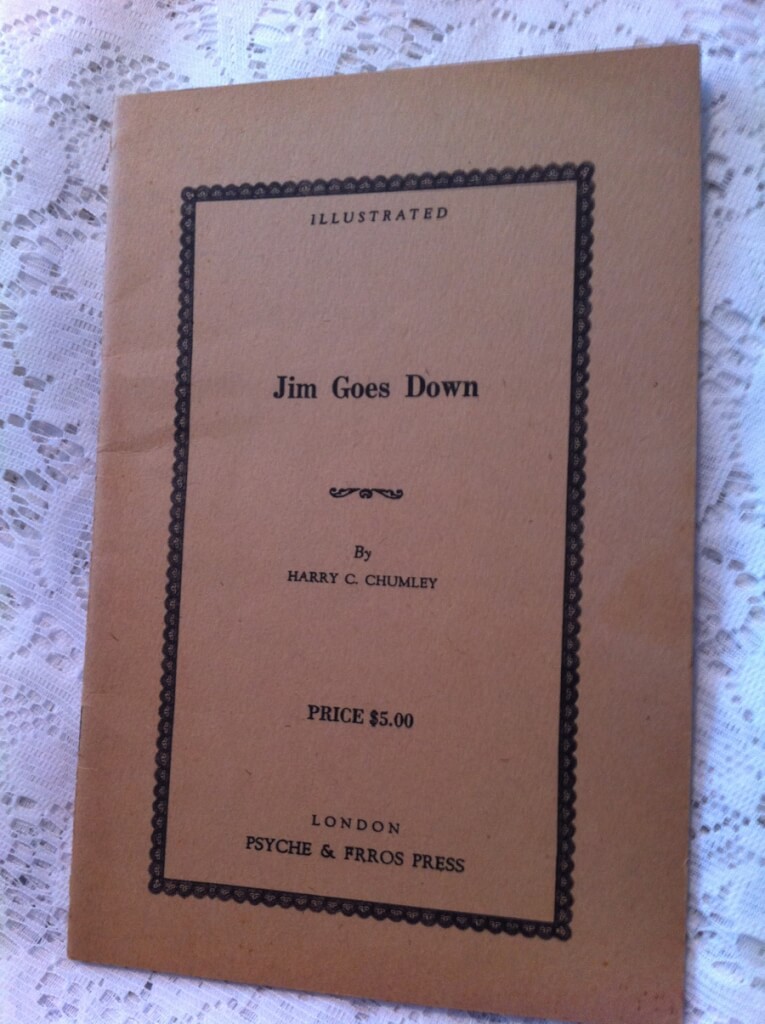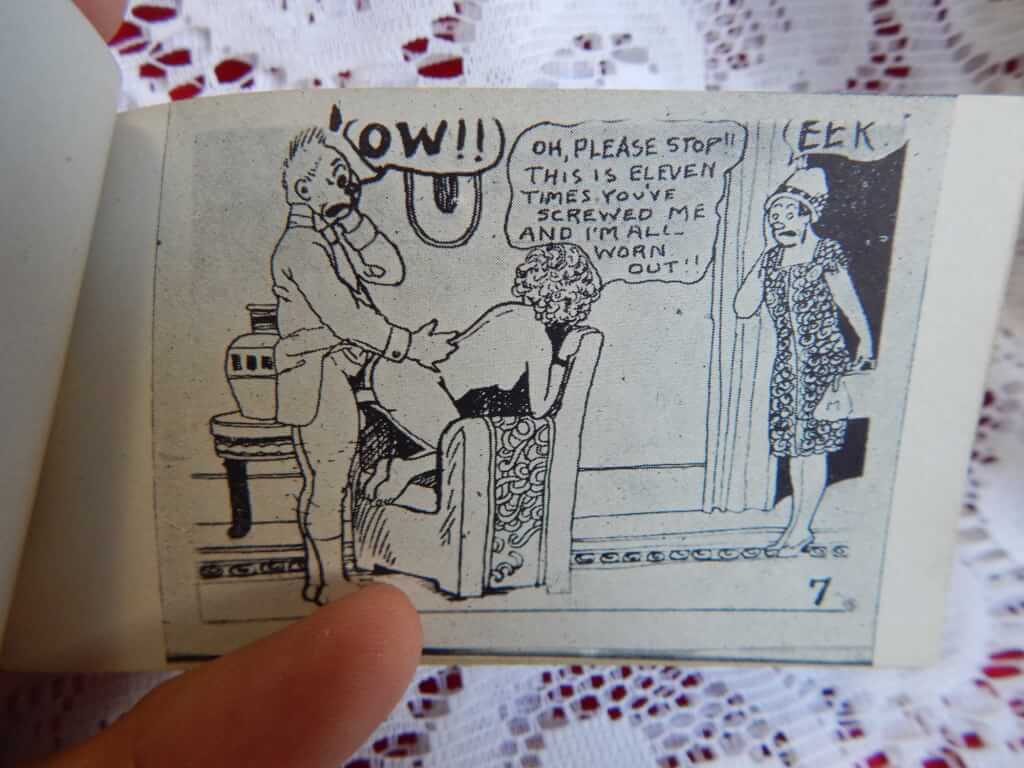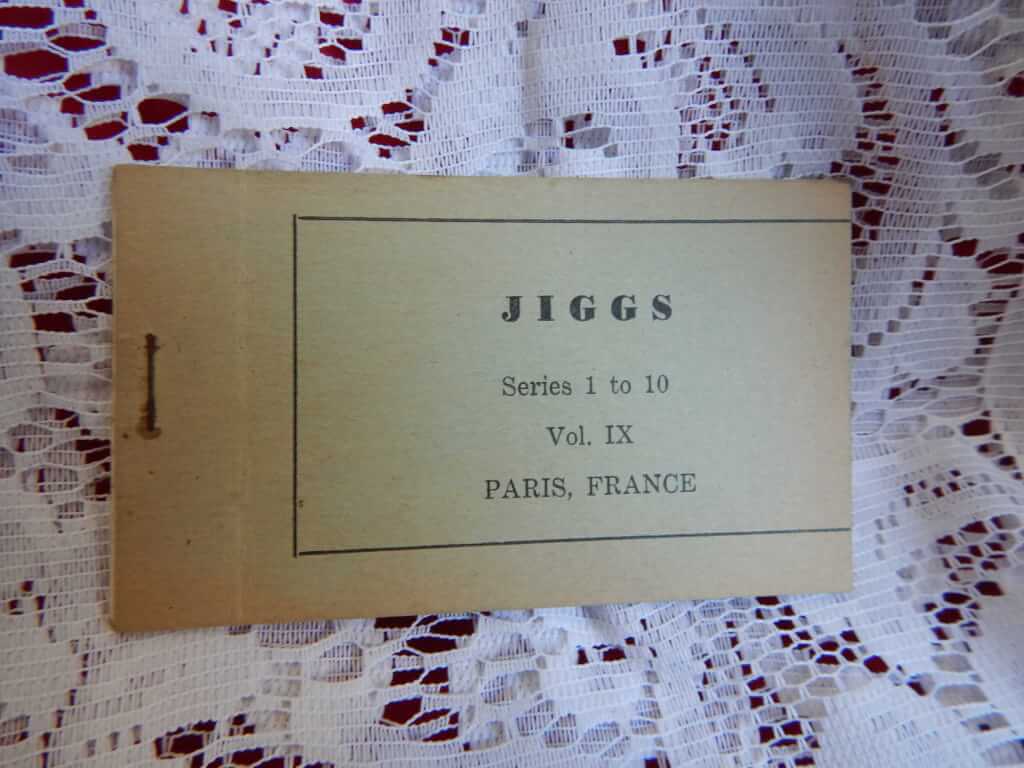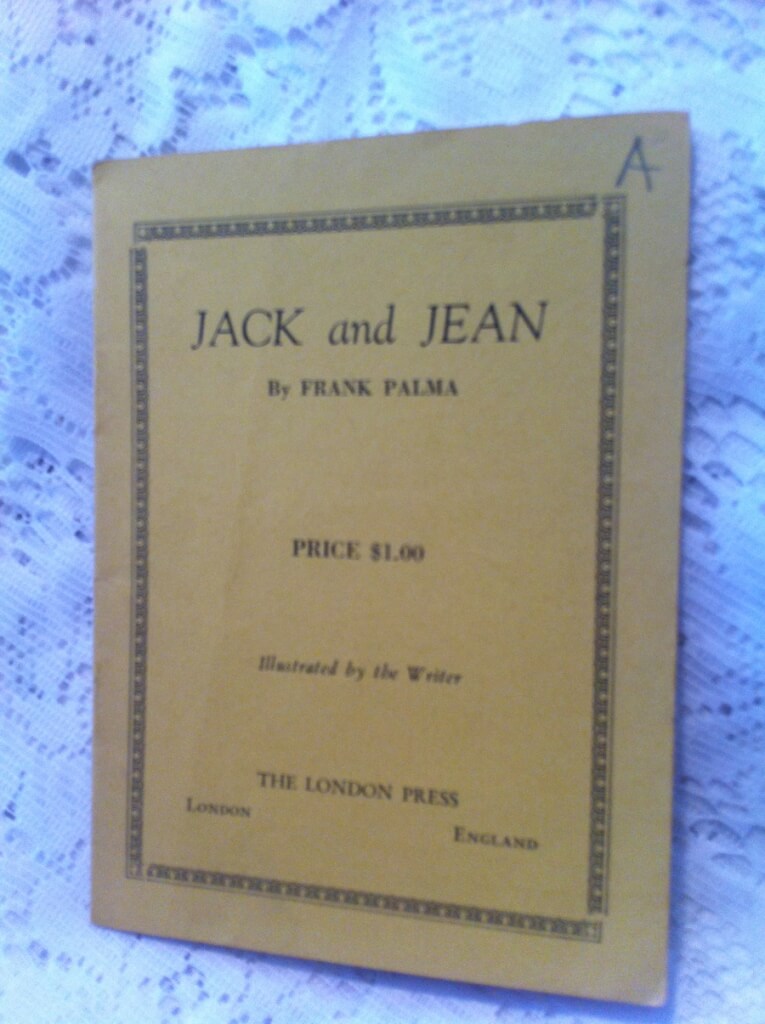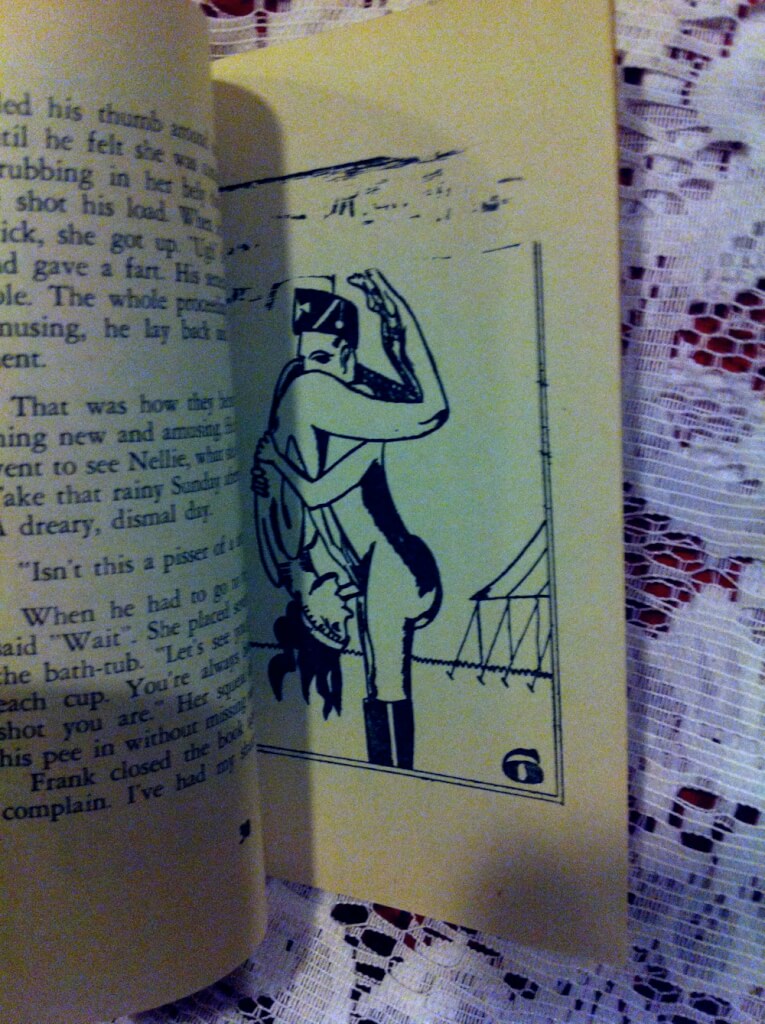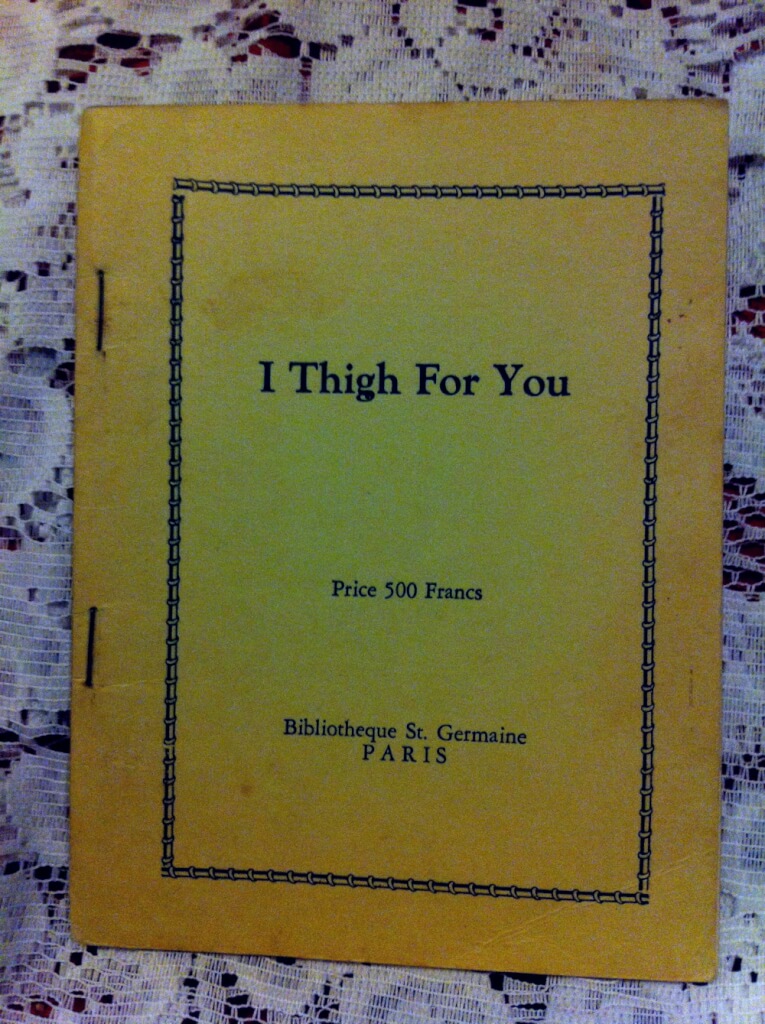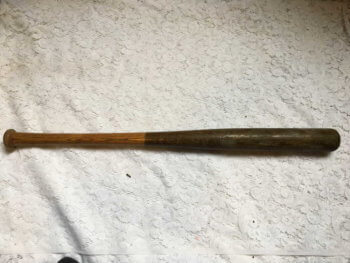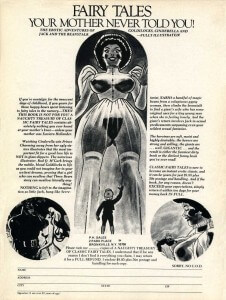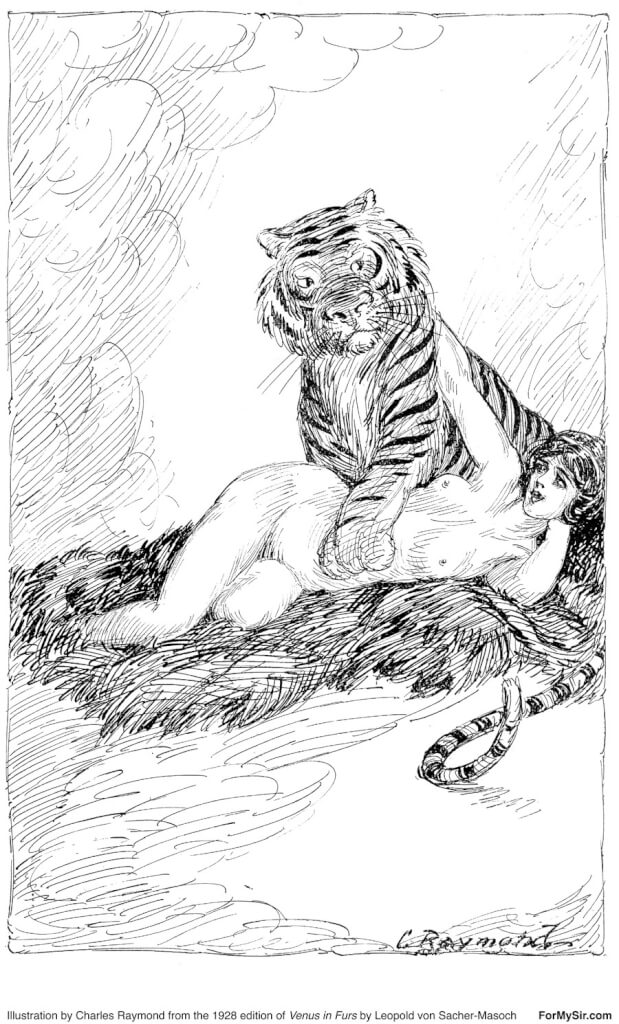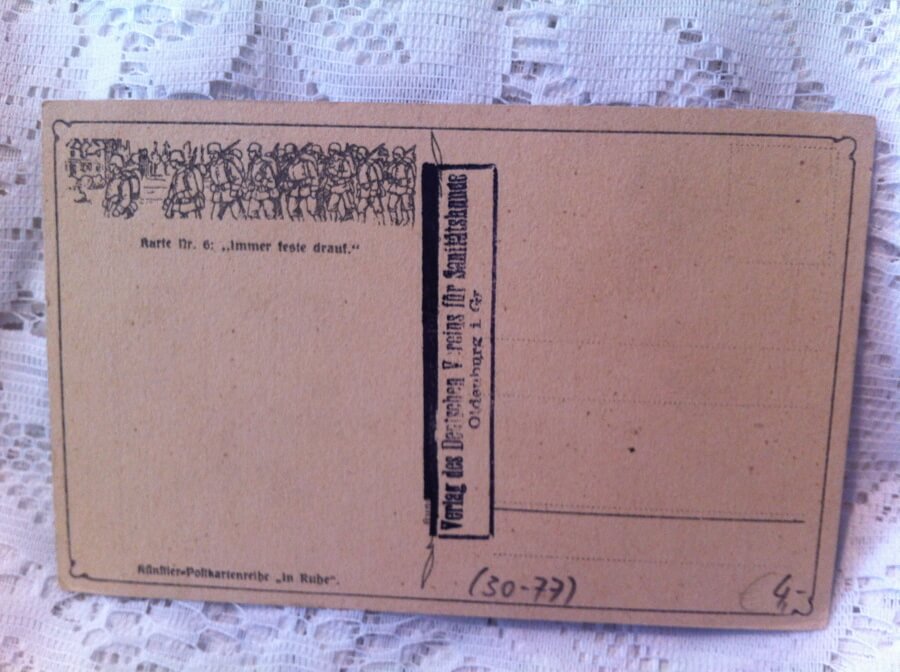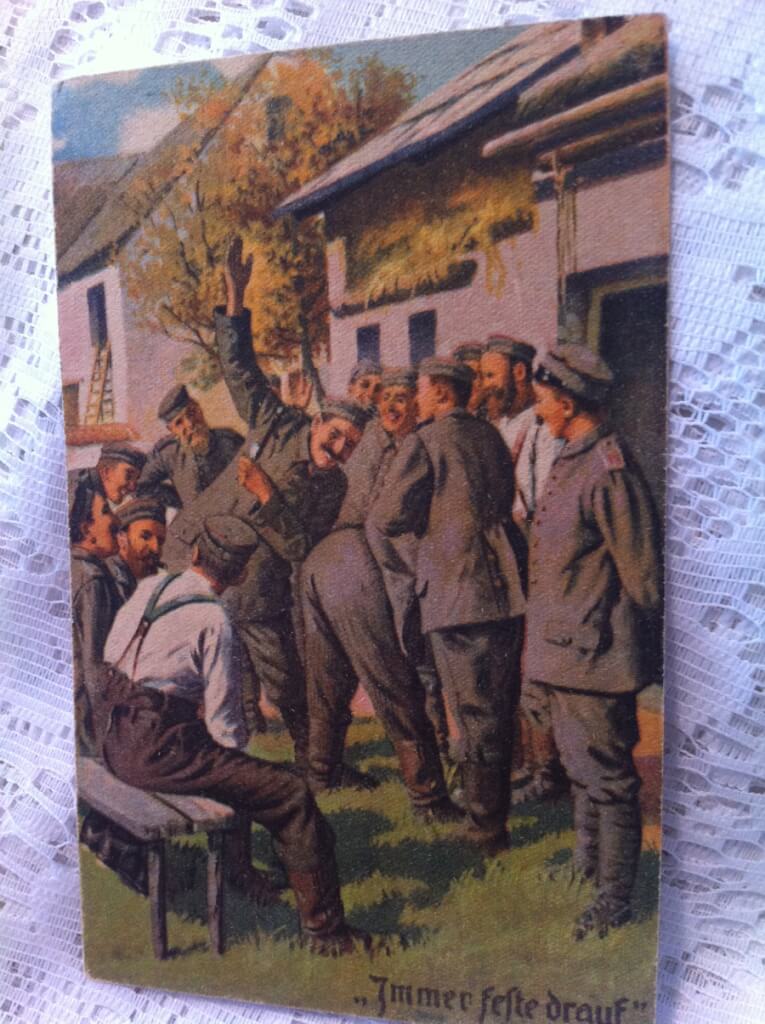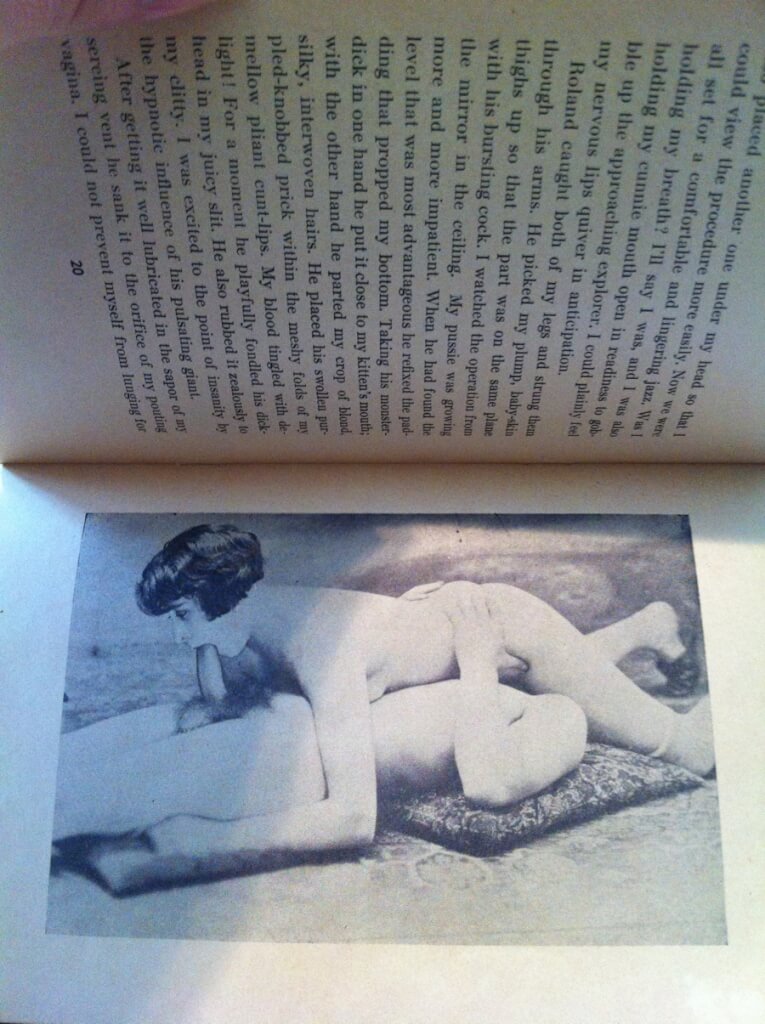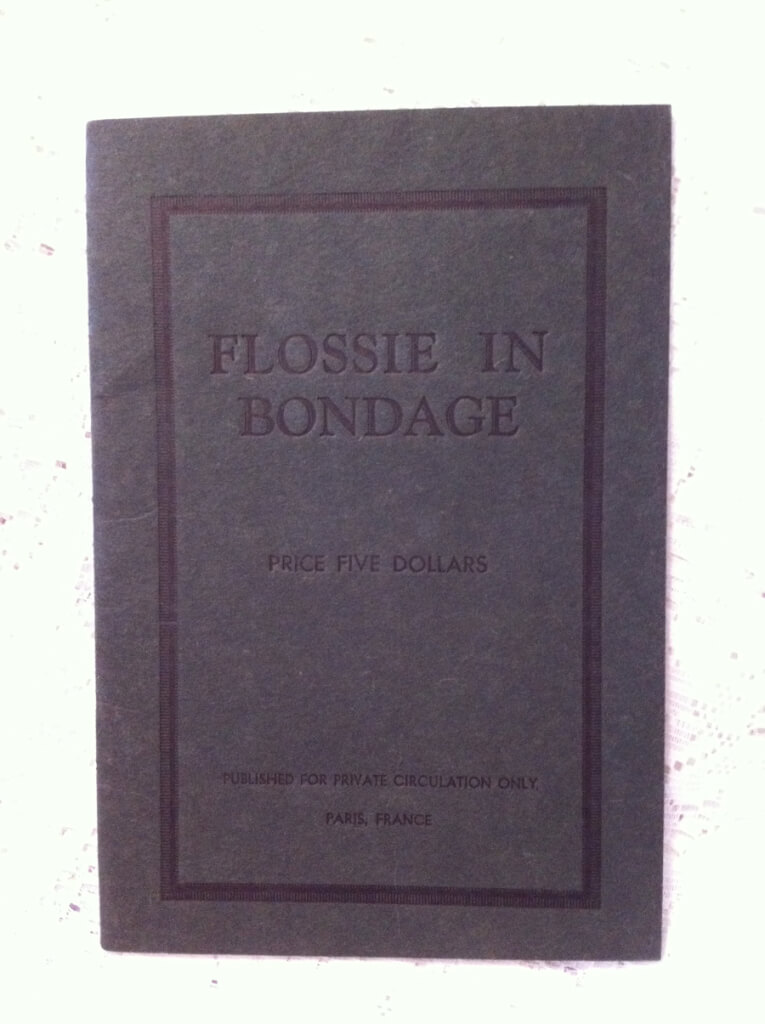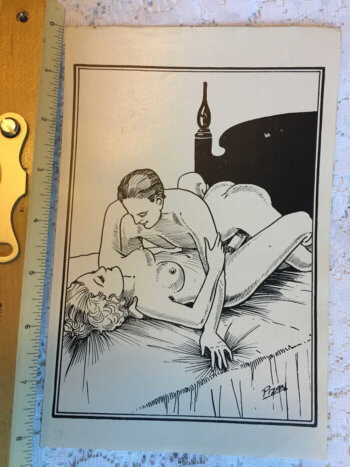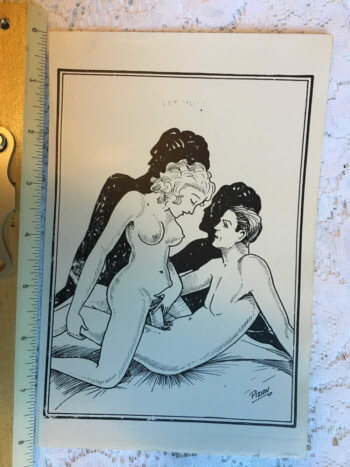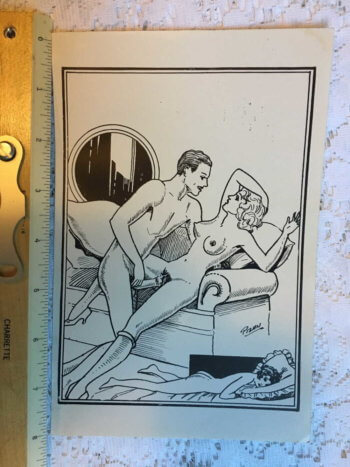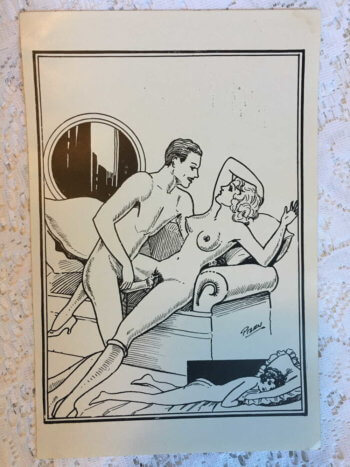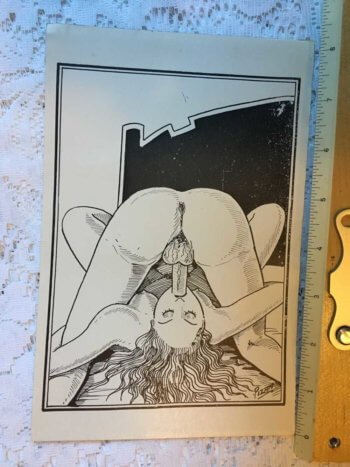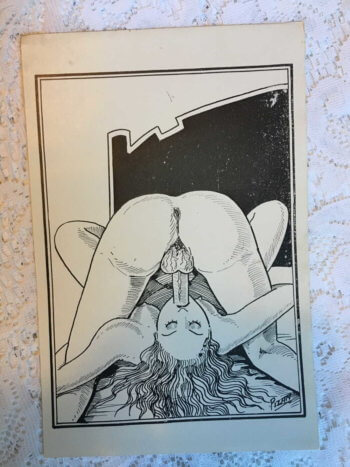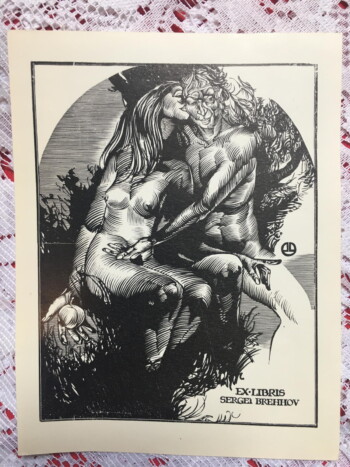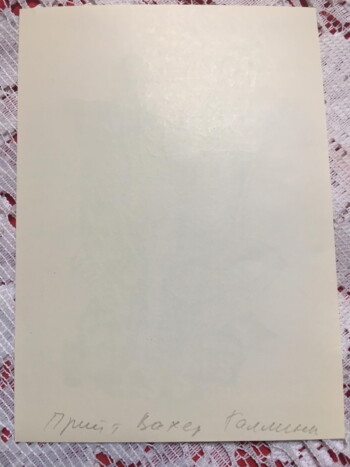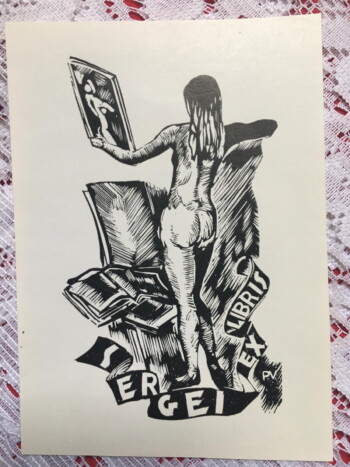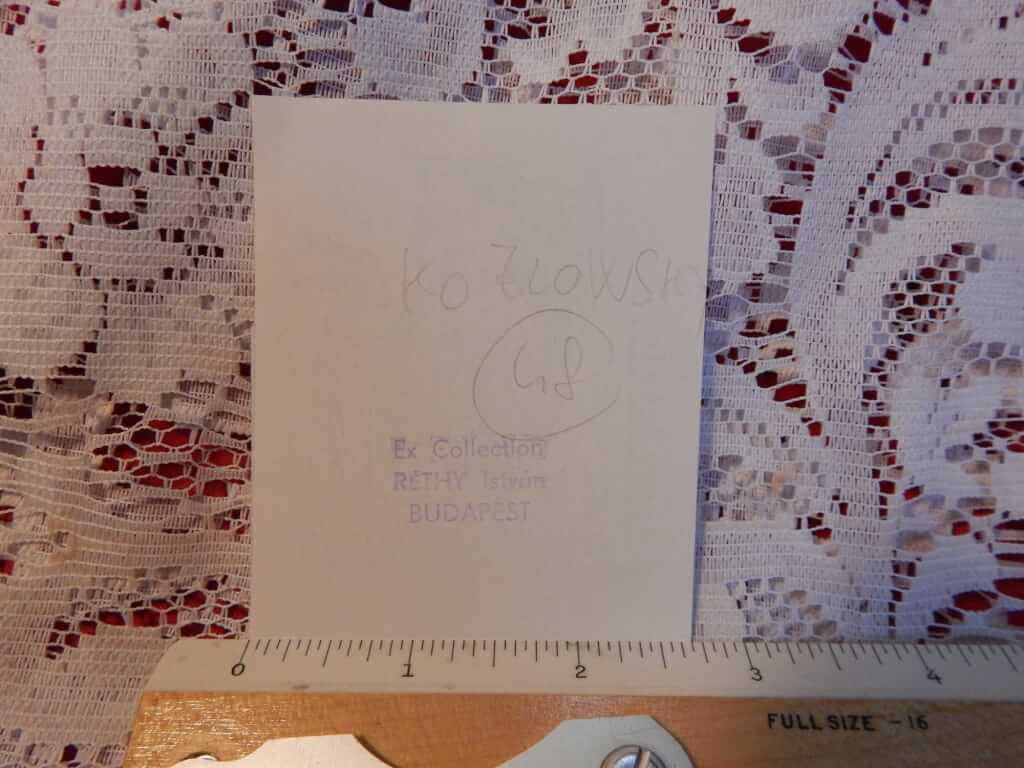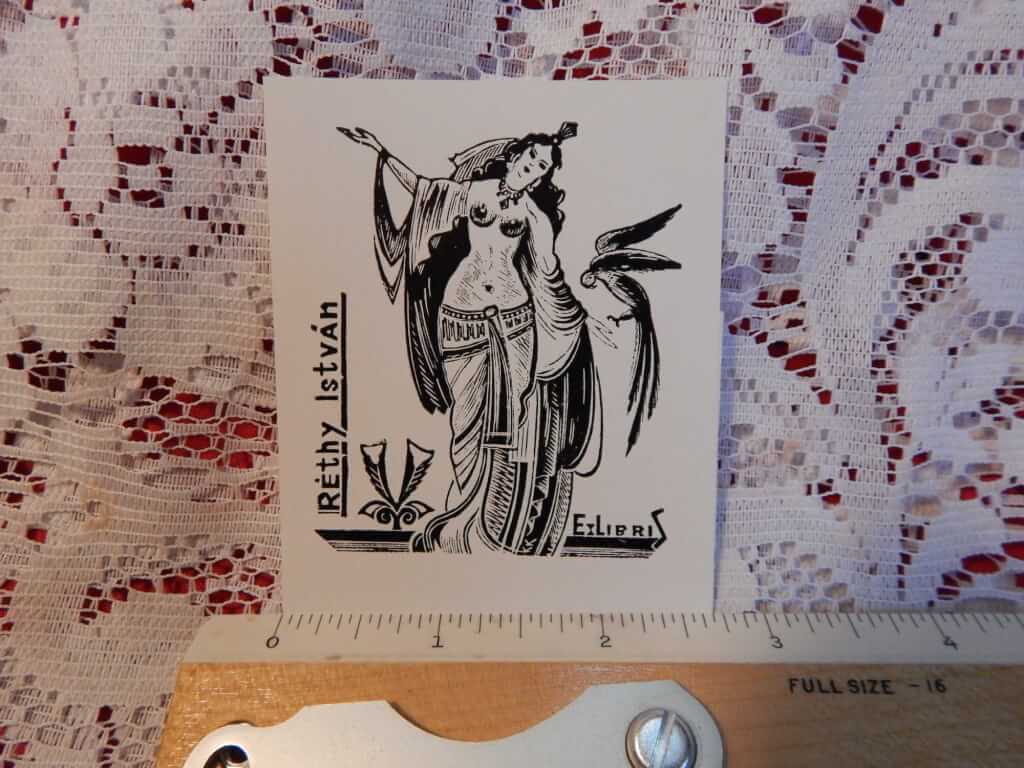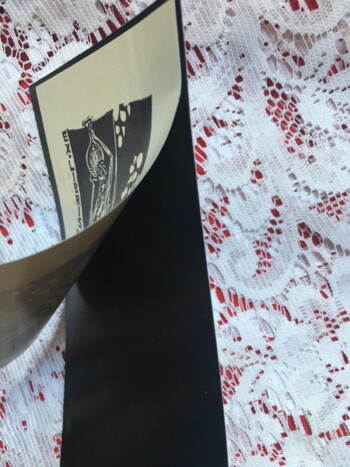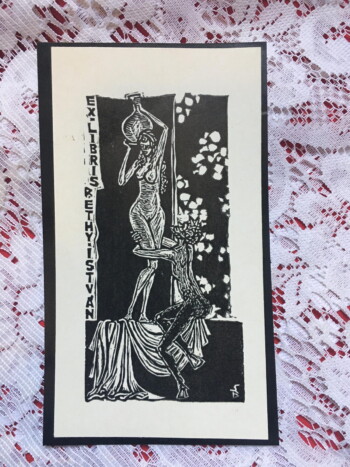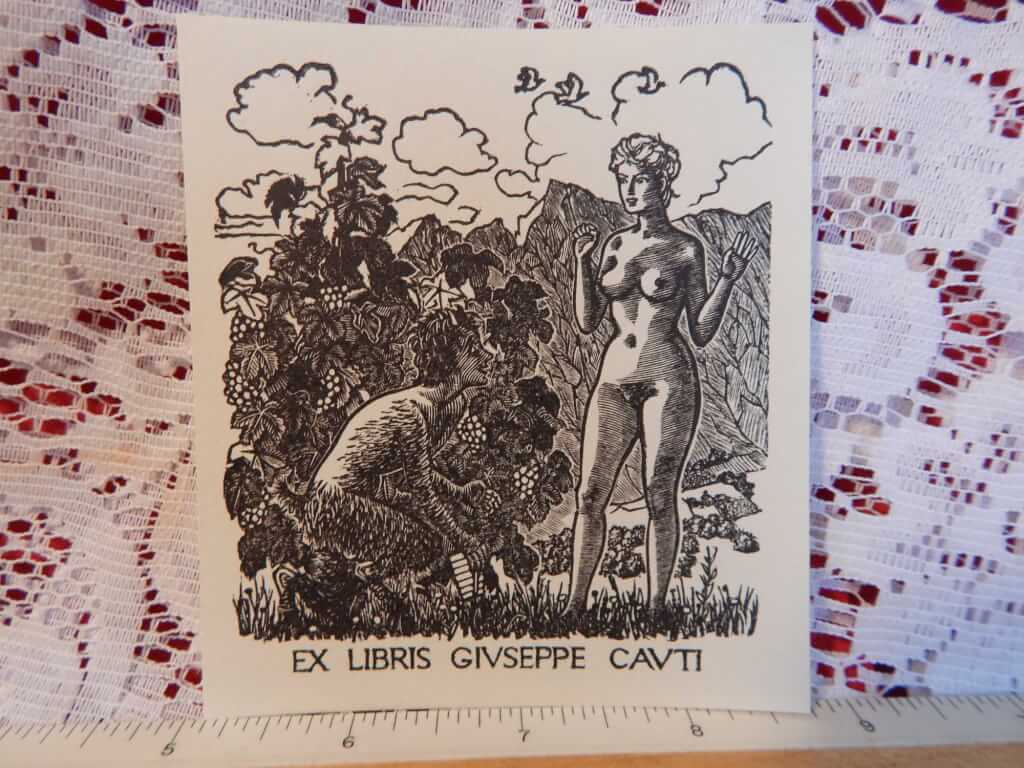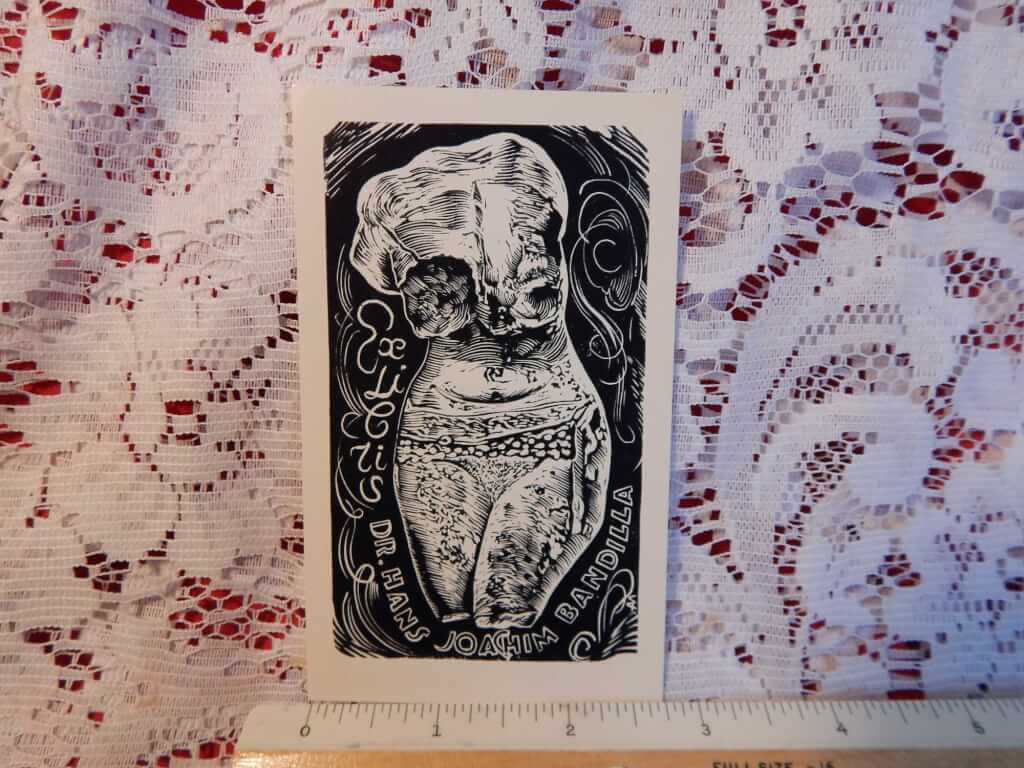-
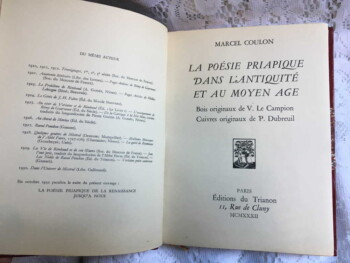
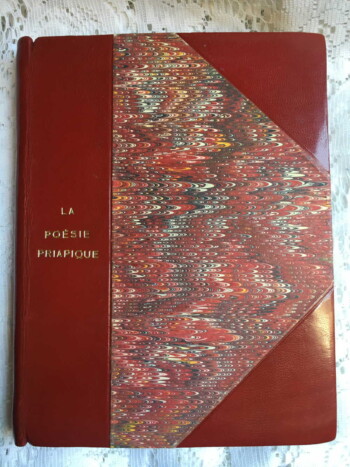 La poésie priapique dans l'antiquité et au moyen age [Priapic poetry in antiquity and the middle ages], ed. Marcel Coulon, 1 original wood engraving by V. Le Campion, 2 original brass engravings by P. Dubreuil (Éditions du Trianon, Paris, 1932, printed by Les Presses de Massoul, #119 of 750) 7.75"x6.25", 166pp+index, 3/4 bound red calf over marbled boards, gilt title on cover and spine, original french wraps bound in, marbled end papers, near fine condition, ribbon intact, pages clean. A history of priapic literature covering folklore, poetry, Priapus, mythology, homosexuality in the ancient world.
La poésie priapique dans l'antiquité et au moyen age [Priapic poetry in antiquity and the middle ages], ed. Marcel Coulon, 1 original wood engraving by V. Le Campion, 2 original brass engravings by P. Dubreuil (Éditions du Trianon, Paris, 1932, printed by Les Presses de Massoul, #119 of 750) 7.75"x6.25", 166pp+index, 3/4 bound red calf over marbled boards, gilt title on cover and spine, original french wraps bound in, marbled end papers, near fine condition, ribbon intact, pages clean. A history of priapic literature covering folklore, poetry, Priapus, mythology, homosexuality in the ancient world. -
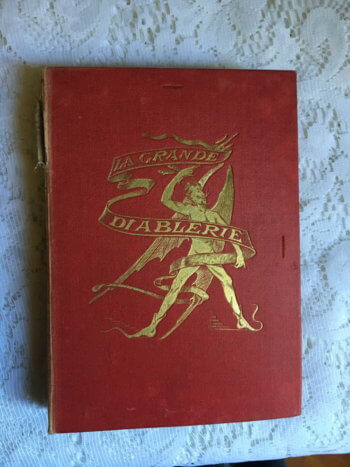
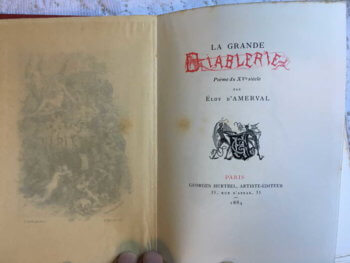 La Grande Diablerie, poem du XVe siècles, by Éloy d'Amerval (George Hurtrel, Artiste-Édueur, Paris, 1884, #152/1000 hand signed by publisher) 5" x 6.75", 216pp, in original published state, french wraps with loose hardcover/case, red with gilt decoration, frontispiece and 3 full page engravings by Paul Avril protected by tissue guard, images throughout, good minus condition, spine cover is sunned, binding is loose and splitting in places Eloy d'Amerval (fl. 1455 – 1508) was a French composer, singer, choirmaster, and poet of the Renaissance. He spent most of his life in the Loire Valley of France. From his poetic works, the long poem Le livre de la deablerie, it can be inferred that he knew most of the famous composers of the time, even though his own musical works never approached theirs in renown. This poem, considered invaluable to music historians, recounts a dialogue between Satan and Lucifer, in which their nefarious plotting of future evil deeds is interrupted periodically by the author, who among other accounts of earthly and divine virtue, records useful information on contemporary musical practice. In addition to listing musical instruments, he lists who he considers to be the great composers of the time: they are residents of Paradise in his poem, even though several were still alive in 1508, the date of its composition. Édouard-Henri Avril (1849-1928) used the pseudonym “Paul Avril” for his erotic work. He was a French painter and commercial artist. His career saw collaboration with influential people like Octave Uzanne, Henry Spencer Ashbee and Friedrich Karl Forberg. He is one of the most celebrated erotic artists of his age. Avril was a soldier before starting his career in art. He was awarded with the Legion of Honour for his actions in the Franco-Prussian War.
La Grande Diablerie, poem du XVe siècles, by Éloy d'Amerval (George Hurtrel, Artiste-Édueur, Paris, 1884, #152/1000 hand signed by publisher) 5" x 6.75", 216pp, in original published state, french wraps with loose hardcover/case, red with gilt decoration, frontispiece and 3 full page engravings by Paul Avril protected by tissue guard, images throughout, good minus condition, spine cover is sunned, binding is loose and splitting in places Eloy d'Amerval (fl. 1455 – 1508) was a French composer, singer, choirmaster, and poet of the Renaissance. He spent most of his life in the Loire Valley of France. From his poetic works, the long poem Le livre de la deablerie, it can be inferred that he knew most of the famous composers of the time, even though his own musical works never approached theirs in renown. This poem, considered invaluable to music historians, recounts a dialogue between Satan and Lucifer, in which their nefarious plotting of future evil deeds is interrupted periodically by the author, who among other accounts of earthly and divine virtue, records useful information on contemporary musical practice. In addition to listing musical instruments, he lists who he considers to be the great composers of the time: they are residents of Paradise in his poem, even though several were still alive in 1508, the date of its composition. Édouard-Henri Avril (1849-1928) used the pseudonym “Paul Avril” for his erotic work. He was a French painter and commercial artist. His career saw collaboration with influential people like Octave Uzanne, Henry Spencer Ashbee and Friedrich Karl Forberg. He is one of the most celebrated erotic artists of his age. Avril was a soldier before starting his career in art. He was awarded with the Legion of Honour for his actions in the Franco-Prussian War. -
 La Génération de l' Homme ou Tableau de l' Amour Conjugal, considéré dans l'état du mariage, Nicolas Venette (np London, 1768, "Nouvelle Édition") 6.25″x3.75″, 408pp, vol. 1 only (of 2), full mottled calf, 5 raised bands worn), gilt title and decorations on spine (worn), marbled boards, fair condition for age, beautiful illustrations including a beautifully engraved frontispiece and title page. Nicolas Venette (1633–1698) was a physician, sexologist and French writer. Born in La Rochelle, he studied medicine at Bordeaux where he received his doctorate in 1656. He then went to Paris where he studied under Guy Patin and Pierre Petit, before travelling to Spain, Portugal and Italy. He then returned to La Rochelle, where he became Regius Professor of Anatomy and Surgery in 1668. First published in Amsterdam in 1686 as Tableau de l’amour humain considéré dans l’état du mariage (Table of human love considered in the state of marriage) under the pseudonym Salocini Venetian (anagram of Nicolas Venette), this book, more properly titled Table of conjugal love, or the complete history of the generation of man, is considered to be the first treatise on sexology in West. It proved to be a bestseller and was translated into English, Spanish, German and Dutch. There were 33 editions published sporadically until 1903. This edition was published in 1768 in two-volume. This book is volume 1. The author discusses four sub-topics with respect to sex: anatomy, reproduction, desire, and impotence/infertility. For each topic, he reviews ancient and medieval authors, adding his own observations or those of later authors, and comments where common sense prevails. The resulting composition has an ambiguous mixture of seriousness and light-heartedness bordering upon erotic literature.
La Génération de l' Homme ou Tableau de l' Amour Conjugal, considéré dans l'état du mariage, Nicolas Venette (np London, 1768, "Nouvelle Édition") 6.25″x3.75″, 408pp, vol. 1 only (of 2), full mottled calf, 5 raised bands worn), gilt title and decorations on spine (worn), marbled boards, fair condition for age, beautiful illustrations including a beautifully engraved frontispiece and title page. Nicolas Venette (1633–1698) was a physician, sexologist and French writer. Born in La Rochelle, he studied medicine at Bordeaux where he received his doctorate in 1656. He then went to Paris where he studied under Guy Patin and Pierre Petit, before travelling to Spain, Portugal and Italy. He then returned to La Rochelle, where he became Regius Professor of Anatomy and Surgery in 1668. First published in Amsterdam in 1686 as Tableau de l’amour humain considéré dans l’état du mariage (Table of human love considered in the state of marriage) under the pseudonym Salocini Venetian (anagram of Nicolas Venette), this book, more properly titled Table of conjugal love, or the complete history of the generation of man, is considered to be the first treatise on sexology in West. It proved to be a bestseller and was translated into English, Spanish, German and Dutch. There were 33 editions published sporadically until 1903. This edition was published in 1768 in two-volume. This book is volume 1. The author discusses four sub-topics with respect to sex: anatomy, reproduction, desire, and impotence/infertility. For each topic, he reviews ancient and medieval authors, adding his own observations or those of later authors, and comments where common sense prevails. The resulting composition has an ambiguous mixture of seriousness and light-heartedness bordering upon erotic literature. -
 La Génération de l' Homme ou Tableau de l' Amour Conjugal, considéré dans l'état du mariage, tome premier, Nicolas Venette (np 1776) 4″x6.75″, 365pp, vol. 1 only (of 2), full mottled calf, 5 raised bands, titles on spine are worn off, marbled boards loose but holding, fair condition for age. Illustrated throughout including a beautifully engraved frontispiece and title page, some illustrations are fold-outs. Nicolas Venette (1633–1698) was a physician, sexologist and French writer. Born in La Rochelle, he studied medicine at Bordeaux where he received his doctorate in 1656. He then went to Paris where he studied under Guy Patin and Pierre Petit, before travelling to Spain, Portugal and Italy. He then returned to La Rochelle, where he became Regius Professor of Anatomy and Surgery in 1668. First published in Amsterdam in 1686 as Tableau de l’amour humain considéré dans l’état du mariage (Table of human love considered in the state of marriage) under the pseudonym Salocini Venetian (anagram of Nicolas Venette), this book, more properly titled Table of conjugal love, or the complete history of the generation of man, is considered to be the first treatise on sexology in West. It proved to be a bestseller and was translated into English, Spanish, German and Dutch. There were 33 editions published sporadically until 1903. This edition was published in 1776 in two-volume. This book is volume 1. Many images are upgraded from previous editions to be fold-outs. The author discusses four sub-topics with respect to sex: anatomy, reproduction, desire, and impotence/infertility. For each topic, he reviews ancient and medieval authors, adding his own observations or those of later authors, and comments where common sense prevails. The resulting composition has an ambiguous mixture of seriousness and light-heartedness bordering upon erotic literature.
La Génération de l' Homme ou Tableau de l' Amour Conjugal, considéré dans l'état du mariage, tome premier, Nicolas Venette (np 1776) 4″x6.75″, 365pp, vol. 1 only (of 2), full mottled calf, 5 raised bands, titles on spine are worn off, marbled boards loose but holding, fair condition for age. Illustrated throughout including a beautifully engraved frontispiece and title page, some illustrations are fold-outs. Nicolas Venette (1633–1698) was a physician, sexologist and French writer. Born in La Rochelle, he studied medicine at Bordeaux where he received his doctorate in 1656. He then went to Paris where he studied under Guy Patin and Pierre Petit, before travelling to Spain, Portugal and Italy. He then returned to La Rochelle, where he became Regius Professor of Anatomy and Surgery in 1668. First published in Amsterdam in 1686 as Tableau de l’amour humain considéré dans l’état du mariage (Table of human love considered in the state of marriage) under the pseudonym Salocini Venetian (anagram of Nicolas Venette), this book, more properly titled Table of conjugal love, or the complete history of the generation of man, is considered to be the first treatise on sexology in West. It proved to be a bestseller and was translated into English, Spanish, German and Dutch. There were 33 editions published sporadically until 1903. This edition was published in 1776 in two-volume. This book is volume 1. Many images are upgraded from previous editions to be fold-outs. The author discusses four sub-topics with respect to sex: anatomy, reproduction, desire, and impotence/infertility. For each topic, he reviews ancient and medieval authors, adding his own observations or those of later authors, and comments where common sense prevails. The resulting composition has an ambiguous mixture of seriousness and light-heartedness bordering upon erotic literature. -

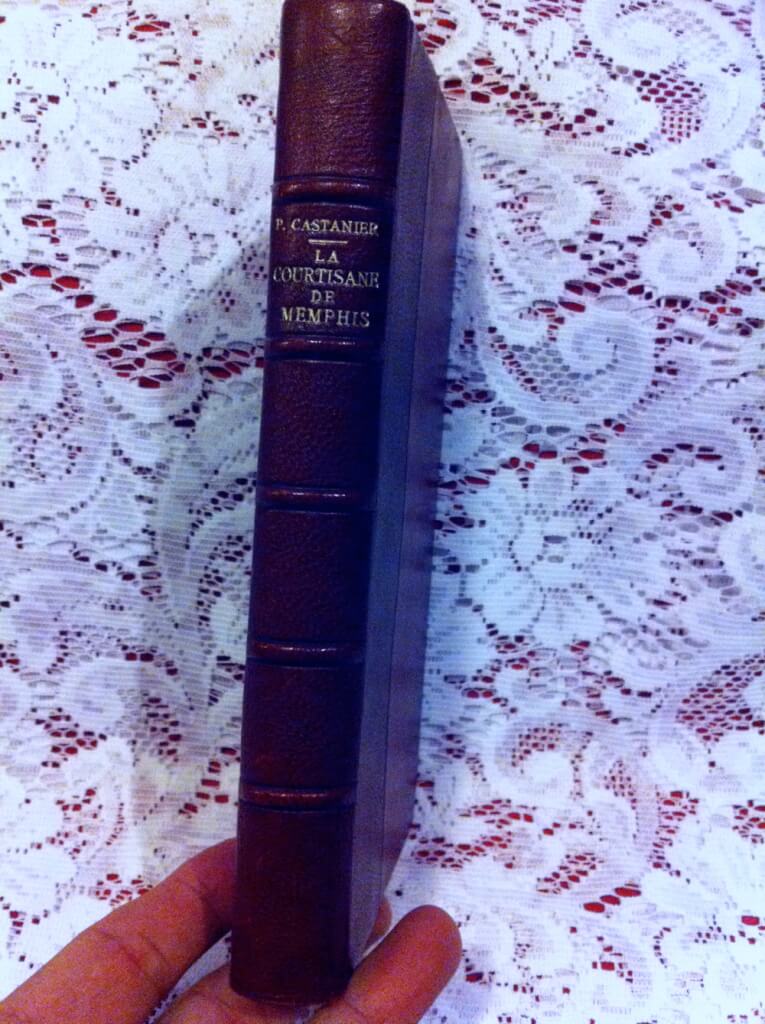 La Courtisane de Memphis, Prosper Castanier, illust. by A. Calbet (Librairie L. Borel, Paris, 1900 "Nymphée Collection") 7.75" X 4", 242pp.+, 1/2 red leather over silk-covered boards, marbled end-papers, gallery of 7 full-page illustrations in red, 5 pages of ads in back, fine condition for age, ribbon intact. In French, The Courtesan of Memphis. Prosper Castanier wrote of the decadence of ancient Rome. This is a beautiful example of a rare book. The French author, poet, novelist and historian Prosper Castanier (1865-19??) was born in Saint-Ambroix (Gard). He was the editor-in-chief of the "Progrès du midi". He had made a specialty of novels set in antiquity. (Particularly after the success of Aphrodite by Pierre Louès, published in 1896)
La Courtisane de Memphis, Prosper Castanier, illust. by A. Calbet (Librairie L. Borel, Paris, 1900 "Nymphée Collection") 7.75" X 4", 242pp.+, 1/2 red leather over silk-covered boards, marbled end-papers, gallery of 7 full-page illustrations in red, 5 pages of ads in back, fine condition for age, ribbon intact. In French, The Courtesan of Memphis. Prosper Castanier wrote of the decadence of ancient Rome. This is a beautiful example of a rare book. The French author, poet, novelist and historian Prosper Castanier (1865-19??) was born in Saint-Ambroix (Gard). He was the editor-in-chief of the "Progrès du midi". He had made a specialty of novels set in antiquity. (Particularly after the success of Aphrodite by Pierre Louès, published in 1896) -
 L'histoire comique de Francion en laquelle sont découvertes les plus subtiles finesses et trompeuses inventions tant des hommes que des femmes de toute sortes de conditions et d'âges. Non moins profitable pour s'en garder, que plaisante à la lecture., Charles Sorel, illus. Martin van Maele (chez Jean Fort, Paris, 1925 #131/ 1100 of copies made with pure Enoshima fibre paper) 9″x6″, 411pp, quarter-bound calf over slate boards, 5 raised bands, gilt titles and decorations on spine, top-edge gilt others deckled, fair condition, boards very loose, barely holding Charles Sorel, sieur de Souvigny (1602 –1674) was a French novelist and general writer. Very little is known of his life except that in 1635 he was historiographer of France. He wrote on science, history and religion, but is only remembered for his novels. He tried to destroy the vogue for the pastoral romance by writing a novel of adventure, the Histoire comique de Francion (first edition in seven volumes, 1623; second edition in twelve volumes, 1633). The episodical adventures of Francion found many readers, who nevertheless kept their admiration for Honoré d'Urfé's L'Astrée, which it was intended to ridicule.
L'histoire comique de Francion en laquelle sont découvertes les plus subtiles finesses et trompeuses inventions tant des hommes que des femmes de toute sortes de conditions et d'âges. Non moins profitable pour s'en garder, que plaisante à la lecture., Charles Sorel, illus. Martin van Maele (chez Jean Fort, Paris, 1925 #131/ 1100 of copies made with pure Enoshima fibre paper) 9″x6″, 411pp, quarter-bound calf over slate boards, 5 raised bands, gilt titles and decorations on spine, top-edge gilt others deckled, fair condition, boards very loose, barely holding Charles Sorel, sieur de Souvigny (1602 –1674) was a French novelist and general writer. Very little is known of his life except that in 1635 he was historiographer of France. He wrote on science, history and religion, but is only remembered for his novels. He tried to destroy the vogue for the pastoral romance by writing a novel of adventure, the Histoire comique de Francion (first edition in seven volumes, 1623; second edition in twelve volumes, 1633). The episodical adventures of Francion found many readers, who nevertheless kept their admiration for Honoré d'Urfé's L'Astrée, which it was intended to ridicule. -
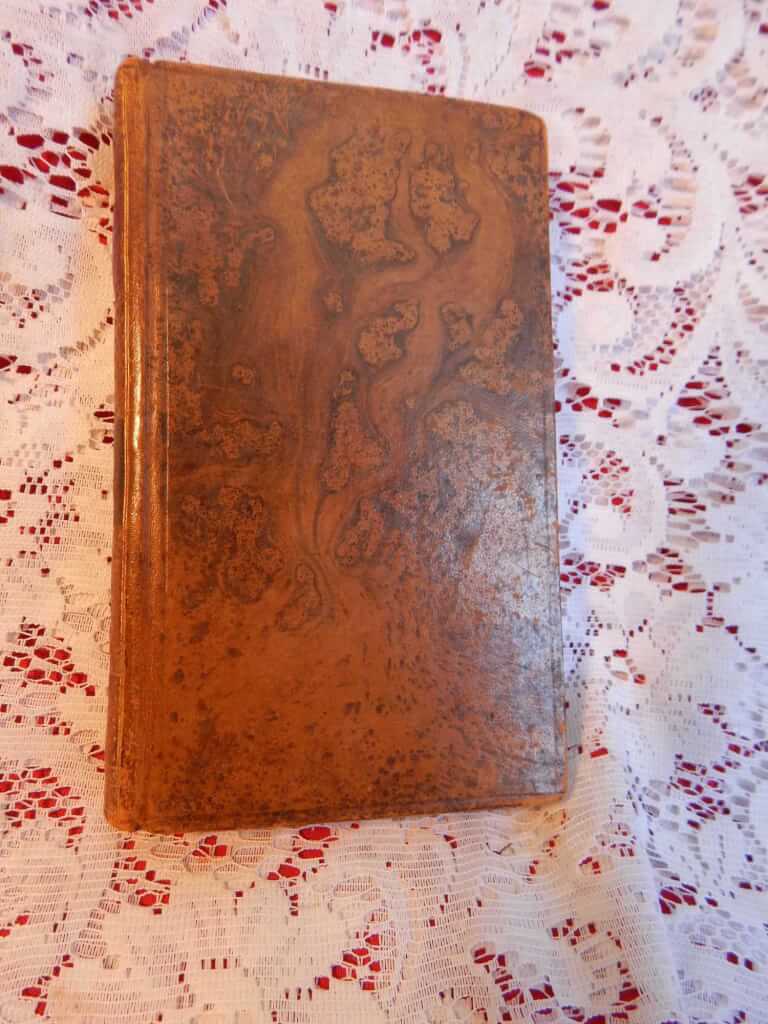
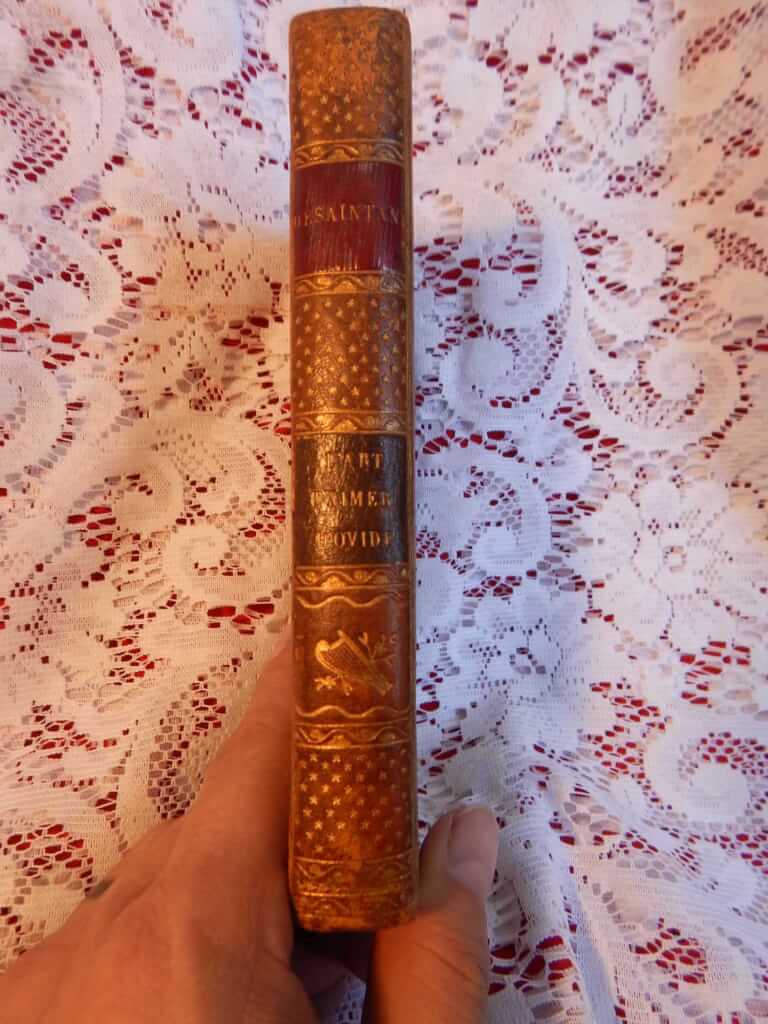 L'art d'aimer d'Ovide, traduction en vers, avec des remarques par M. Desaintange (Chez Giguet et Michaud, Paris, 1807, first edition of translation) 5"x8", 320pp, full calf, gilt titles and decorations to spine, marbled boards, some rubbing and bumping, good+ condition for age, finely engraved frontispiece, unknown artist French language translation by Saint-Ange of Ovid's The Art of Love. Publius Ovidius Naso (43 BC – AD 17/18), known as Ovid in the English-speaking world, was a Roman poet who lived during the reign of Augustus. He was a contemporary of the older Virgil and Horace, with whom he is often ranked as one of the three canonical poets of Latin literature. The Imperial scholar Quintilian considered him the last of the Latin love elegists. He enjoyed enormous popularity, but, in one of the mysteries of literary history, was sent by Augustus into exile in a remote province on the Black Sea, where he remained until his death. Ovid himself attributes his exile to carmen et error, "a poem and a mistake", but his discretion in discussing the causes has resulted in much speculation among scholars. The first major Roman poet to begin his career during the reign of Augustus, Ovid is today best known for the Metamorphoses, a 15-book continuous mythological narrative written in the meter of epic, and for works in elegiac couplets such as Ars Amatoria ("The Art of Love") and Fasti. His poetry was much imitated during Late Antiquity and the Middle Ages, and greatly influenced Western art and literature. The Metamorphoses remains one of the most important sources of classical mythology. Ange-François Fariau de Saint-Ange (1747-1810), known as Saint-Ange was a French poet and translator. Born of a father adviser of the king, he studied at the collège des jésuites de Blois, then at the college Sainte-Barbe de Paris. He acquired from a young age a reputation for his his unparalleled wit. Protected by Turgot, he gained a place in general control, but found himself without resources in the Revolution. At the fall of Robespierre, he found a job in the clothing agency of the troops, then became then professor of belles-lettres, then of general and reasoned grammar, with the central school of the street Saint-Antoine. He was elected member of the French Academy in 1810. In his reception speech, sensing that his shaky health would not allow him to sit there for a long time, he declared: "I am doing violence, at this moment, to the continual suffering and intolerable who warn me that the shadow of the academician whom I replace is waiting for mine. Three months later, he suffered a fall and died while visiting the institute.
L'art d'aimer d'Ovide, traduction en vers, avec des remarques par M. Desaintange (Chez Giguet et Michaud, Paris, 1807, first edition of translation) 5"x8", 320pp, full calf, gilt titles and decorations to spine, marbled boards, some rubbing and bumping, good+ condition for age, finely engraved frontispiece, unknown artist French language translation by Saint-Ange of Ovid's The Art of Love. Publius Ovidius Naso (43 BC – AD 17/18), known as Ovid in the English-speaking world, was a Roman poet who lived during the reign of Augustus. He was a contemporary of the older Virgil and Horace, with whom he is often ranked as one of the three canonical poets of Latin literature. The Imperial scholar Quintilian considered him the last of the Latin love elegists. He enjoyed enormous popularity, but, in one of the mysteries of literary history, was sent by Augustus into exile in a remote province on the Black Sea, where he remained until his death. Ovid himself attributes his exile to carmen et error, "a poem and a mistake", but his discretion in discussing the causes has resulted in much speculation among scholars. The first major Roman poet to begin his career during the reign of Augustus, Ovid is today best known for the Metamorphoses, a 15-book continuous mythological narrative written in the meter of epic, and for works in elegiac couplets such as Ars Amatoria ("The Art of Love") and Fasti. His poetry was much imitated during Late Antiquity and the Middle Ages, and greatly influenced Western art and literature. The Metamorphoses remains one of the most important sources of classical mythology. Ange-François Fariau de Saint-Ange (1747-1810), known as Saint-Ange was a French poet and translator. Born of a father adviser of the king, he studied at the collège des jésuites de Blois, then at the college Sainte-Barbe de Paris. He acquired from a young age a reputation for his his unparalleled wit. Protected by Turgot, he gained a place in general control, but found himself without resources in the Revolution. At the fall of Robespierre, he found a job in the clothing agency of the troops, then became then professor of belles-lettres, then of general and reasoned grammar, with the central school of the street Saint-Antoine. He was elected member of the French Academy in 1810. In his reception speech, sensing that his shaky health would not allow him to sit there for a long time, he declared: "I am doing violence, at this moment, to the continual suffering and intolerable who warn me that the shadow of the academician whom I replace is waiting for mine. Three months later, he suffered a fall and died while visiting the institute. -

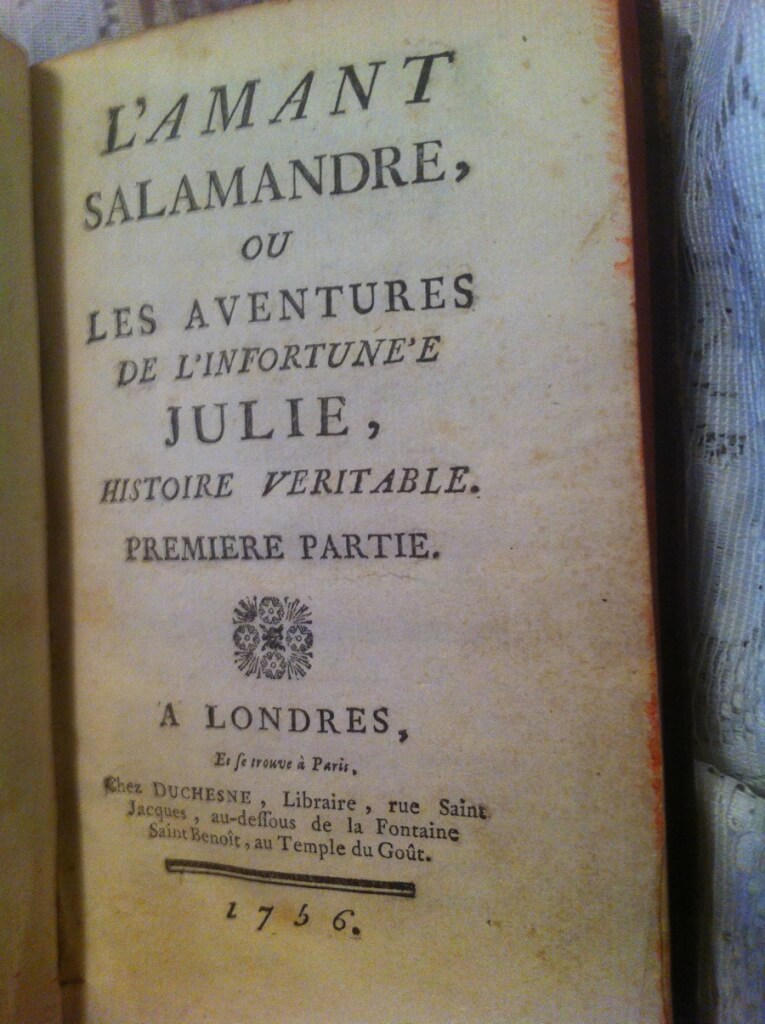 L'Amant Salamandre, ou Les Aventures de l'Infortunée Julie,Histoire Veritable, anonymous [Cointreau] , ("Londres, Et se trouve à Paris. Chez Duchesne" 1756, [first edition]) 4"x6.75", in two parts, 132pp, 135pp, Contemporary mottled calf, gilt decorations on spine, marbled boards, in good condition for age, some splitting at spine, but binding good. Julie is the bizarre tale of a young orphan tricked by her wicked governess into believing in magic. The governess delivers the girl to her son, who attempts to seduce her disguised as Salamandre, a magician. The young girl escapes to a convent, only to cross paths with the governess some time later, who once again tries to procure her for her son. 'Salamandre' is attacked by assassins and confesses his mother's crimes on his death bed. The novel was very popular in it's day. Although very popular in it's day, it's a rare find, especially the original 1756 version.
L'Amant Salamandre, ou Les Aventures de l'Infortunée Julie,Histoire Veritable, anonymous [Cointreau] , ("Londres, Et se trouve à Paris. Chez Duchesne" 1756, [first edition]) 4"x6.75", in two parts, 132pp, 135pp, Contemporary mottled calf, gilt decorations on spine, marbled boards, in good condition for age, some splitting at spine, but binding good. Julie is the bizarre tale of a young orphan tricked by her wicked governess into believing in magic. The governess delivers the girl to her son, who attempts to seduce her disguised as Salamandre, a magician. The young girl escapes to a convent, only to cross paths with the governess some time later, who once again tries to procure her for her son. 'Salamandre' is attacked by assassins and confesses his mother's crimes on his death bed. The novel was very popular in it's day. Although very popular in it's day, it's a rare find, especially the original 1756 version. -

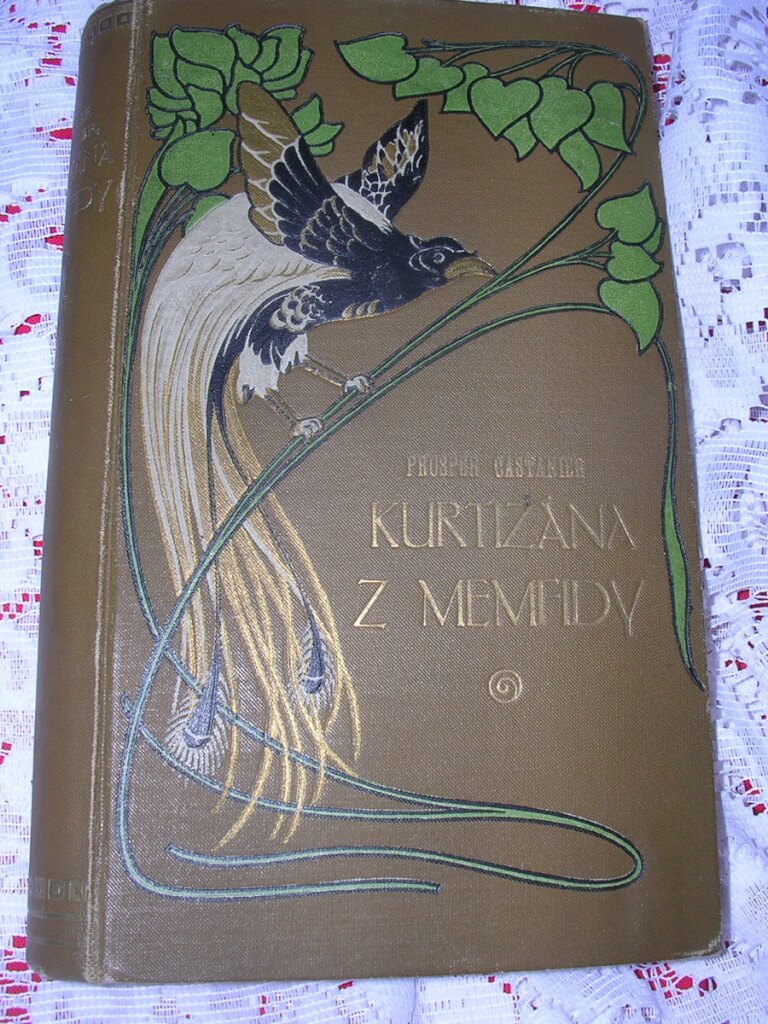 Kurtizána z Memfidy: Anticky román [Czech], Prosper Castanier, trans. Karel Weinfurter, illus. A. Calbeta (Alois Hynek, Praha [Prague], nd [c. 1901], printed by J. Rokyta, Praha) 7" x 4.5", 312pp, hardbound brown decorated cloth boards with gilt and other colors, gilt lettering and design on spine. Top edge gilt. Illustrated throughout with 4 choice illustrations duplicated in alternating red and green before title page. Great condition of a very rare book. This is a rare Czech translation of The Courtesan of Memphis, Czech Memfidy (Memphis) book, also in the rare publisher's original cloth-binding. The publisher, Alois Hynek, translated this and many of Castanier's books into German. These books had similiarly decorated covers. Most of the Hynek's Czech translations one finds are softcover. This is a rare hardcover translation into Czech. It is beautifully illustrated The French author, poet, novelist and historian Prosper Castanier (1865-19??) was born in Saint-Ambroix (Gard). He was the editor-in-chief of the "Progrès du midi". He had made a specialty of novels set in antiquity. (Particularly after the success of Aphrodite by Pierre Louès, published in 1896)
Kurtizána z Memfidy: Anticky román [Czech], Prosper Castanier, trans. Karel Weinfurter, illus. A. Calbeta (Alois Hynek, Praha [Prague], nd [c. 1901], printed by J. Rokyta, Praha) 7" x 4.5", 312pp, hardbound brown decorated cloth boards with gilt and other colors, gilt lettering and design on spine. Top edge gilt. Illustrated throughout with 4 choice illustrations duplicated in alternating red and green before title page. Great condition of a very rare book. This is a rare Czech translation of The Courtesan of Memphis, Czech Memfidy (Memphis) book, also in the rare publisher's original cloth-binding. The publisher, Alois Hynek, translated this and many of Castanier's books into German. These books had similiarly decorated covers. Most of the Hynek's Czech translations one finds are softcover. This is a rare hardcover translation into Czech. It is beautifully illustrated The French author, poet, novelist and historian Prosper Castanier (1865-19??) was born in Saint-Ambroix (Gard). He was the editor-in-chief of the "Progrès du midi". He had made a specialty of novels set in antiquity. (Particularly after the success of Aphrodite by Pierre Louès, published in 1896) -
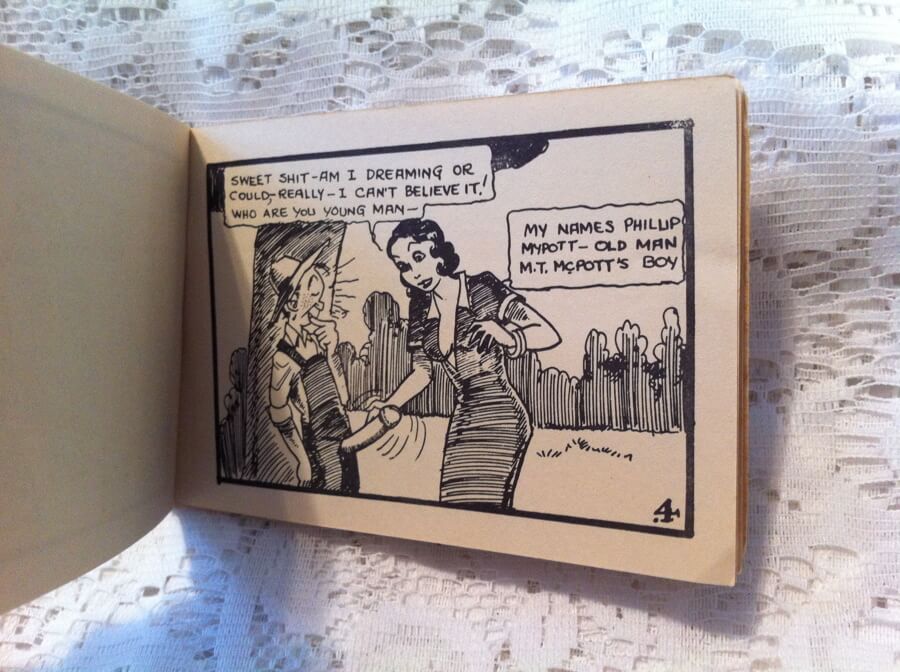
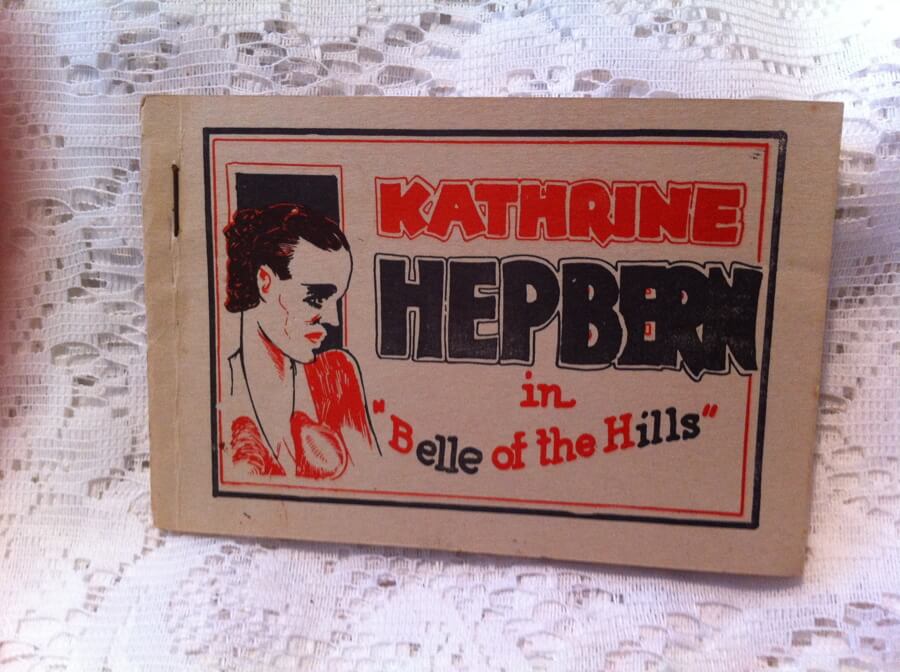 Katherine Hepbern in "Belle of the Hills", (n.p. n.d.) 4.5" x 3", 8pp. pamphlet, stapled Tijuana bibles (also known as eight-pagers, bluesies, gray-backs, Jiggs-and-Maggie books, jo-jo books, Tillie-and-Mac books, and two-by-fours) were little pornographic comic books produced in the United States from the 1920s to the early 1960s.
Katherine Hepbern in "Belle of the Hills", (n.p. n.d.) 4.5" x 3", 8pp. pamphlet, stapled Tijuana bibles (also known as eight-pagers, bluesies, gray-backs, Jiggs-and-Maggie books, jo-jo books, Tillie-and-Mac books, and two-by-fours) were little pornographic comic books produced in the United States from the 1920s to the early 1960s. -
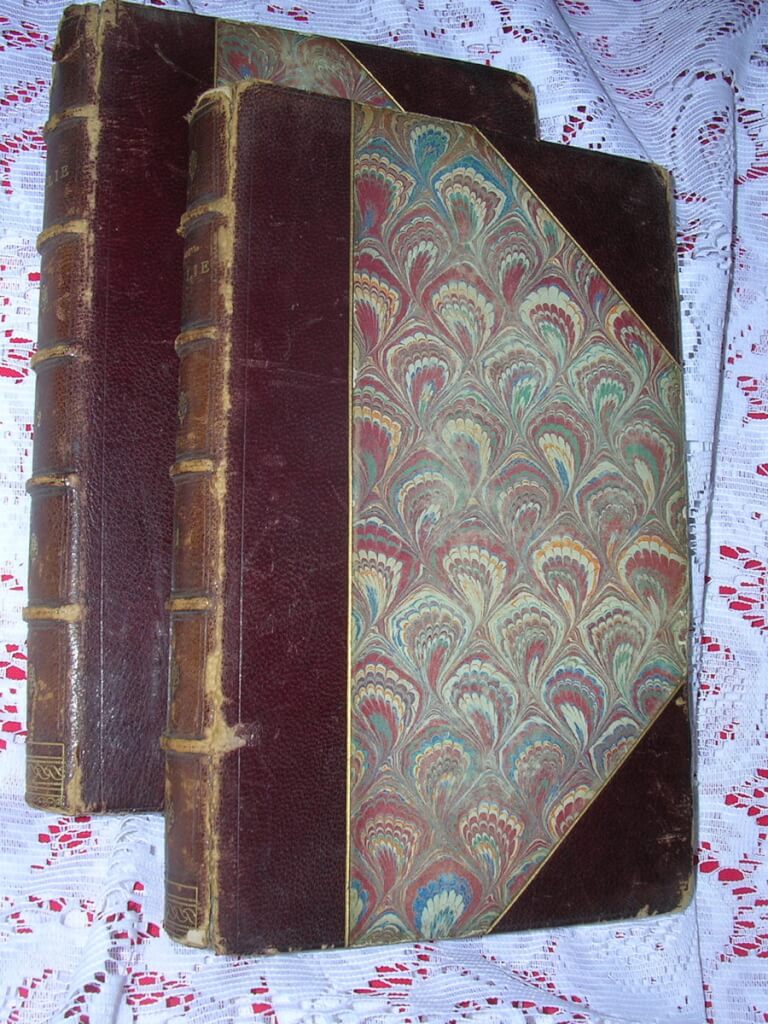
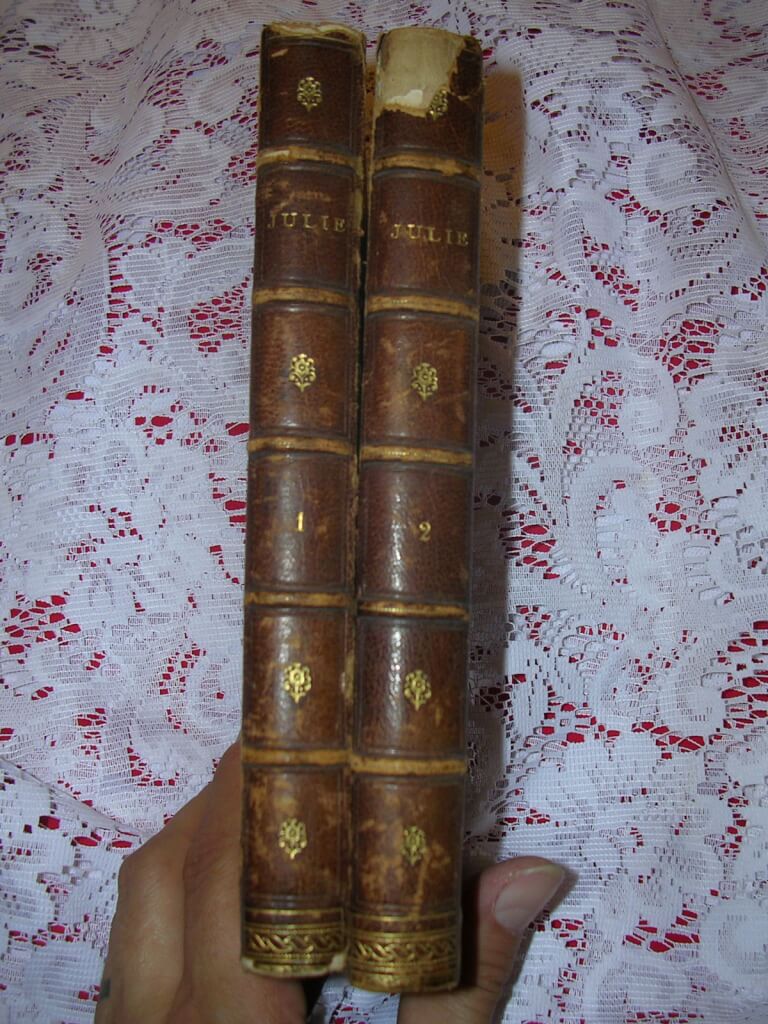 Julie, ou J'ai sauvé ma rose, Madame de C*** [Félicité Choiseul-Meuse] (Gay et Doucé, Bruxelles, 1882) 7.5" x 4.75", 2 vol. 169pp 188pp, hardbound half-leather over decorated paper boards and marbled endpapers. Gilt lettering and decorations on spine, 5 raised bands. 2 frontispiece engravings. Fair condition for age. Vol. 1 front boards loose and first few endpapers not attached, no missing pages, wear and tear to top of spine. Edges worn, corners bumped. Felicite de Choiseul-Meuse wrote approximately twenty-seven novels from 1797 to 1824. Writings are sometimes identified by pseudonyms and acronyms: LFDLC; Emilia P ***, Madame de C *** , etc.. Her 1807 novel "Julie, ou j'ai sauvé ma rose" [Julie, or I saved my rose] is widely considered the first erotic novel written by a woman. It is more appropriately translated as "how I kept my cherry" for it tells the tale of a young woman who lets her lovers fondle her all they want, but will not allow penetration until she finds the right man and marries him. The work was condemned as obscene and its destruction ordered by the Cour royale de Paris on August 5, 1828. Excerpt: "I tasted in his arms unspeakable pleasures. Deadened by pleasure, then revived by an even more delirious pleasure, I made the object of happiness almost as happy as I was myself; and yet, true to my system, I made sure that he did not harvest the rose."
Julie, ou J'ai sauvé ma rose, Madame de C*** [Félicité Choiseul-Meuse] (Gay et Doucé, Bruxelles, 1882) 7.5" x 4.75", 2 vol. 169pp 188pp, hardbound half-leather over decorated paper boards and marbled endpapers. Gilt lettering and decorations on spine, 5 raised bands. 2 frontispiece engravings. Fair condition for age. Vol. 1 front boards loose and first few endpapers not attached, no missing pages, wear and tear to top of spine. Edges worn, corners bumped. Felicite de Choiseul-Meuse wrote approximately twenty-seven novels from 1797 to 1824. Writings are sometimes identified by pseudonyms and acronyms: LFDLC; Emilia P ***, Madame de C *** , etc.. Her 1807 novel "Julie, ou j'ai sauvé ma rose" [Julie, or I saved my rose] is widely considered the first erotic novel written by a woman. It is more appropriately translated as "how I kept my cherry" for it tells the tale of a young woman who lets her lovers fondle her all they want, but will not allow penetration until she finds the right man and marries him. The work was condemned as obscene and its destruction ordered by the Cour royale de Paris on August 5, 1828. Excerpt: "I tasted in his arms unspeakable pleasures. Deadened by pleasure, then revived by an even more delirious pleasure, I made the object of happiness almost as happy as I was myself; and yet, true to my system, I made sure that he did not harvest the rose." -
 Julie, ou J'ai sauvé ma rose, Madame de C*** [Félicité Choiseul-Meuse] (J.-J. Gay, Bruxelles, 1882) 8" x 5.25", 2 vol. 169pp 188pp, full mottled calf, marbled endpapers. Gilt lettering and decorations on spine, 5 raised bands. 2 frontispiece engravings. just Fair condition, interior good, exterior in poor shape, Vol. 1 boards loose, Vol. 2 boards detached. Felicite de Choiseul-Meuse wrote approximately twenty-seven novels from 1797 to 1824. Writings are sometimes identified by pseudonyms and acronyms: LFDLC; Emilia P ***, Madame de C *** , etc.. Her 1807 novel "Julie, ou j'ai sauvé ma rose" [Julie, or I saved my rose] is widely considered the first erotic novel written by a woman. It is more appropriately translated as "how I kept my cherry" for it tells the tale of a young woman who lets her lovers fondle her all they want, but will not allow penetration until she finds the right man and marries him. The work was condemned as obscene and its destruction ordered by the Cour royale de Paris on August 5, 1828. Excerpt: "I tasted in his arms unspeakable pleasures. Deadened by pleasure, then revived by an even more delirious pleasure, I made the object of happiness almost as happy as I was myself; and yet, true to my system, I made sure that he did not harvest the rose."
Julie, ou J'ai sauvé ma rose, Madame de C*** [Félicité Choiseul-Meuse] (J.-J. Gay, Bruxelles, 1882) 8" x 5.25", 2 vol. 169pp 188pp, full mottled calf, marbled endpapers. Gilt lettering and decorations on spine, 5 raised bands. 2 frontispiece engravings. just Fair condition, interior good, exterior in poor shape, Vol. 1 boards loose, Vol. 2 boards detached. Felicite de Choiseul-Meuse wrote approximately twenty-seven novels from 1797 to 1824. Writings are sometimes identified by pseudonyms and acronyms: LFDLC; Emilia P ***, Madame de C *** , etc.. Her 1807 novel "Julie, ou j'ai sauvé ma rose" [Julie, or I saved my rose] is widely considered the first erotic novel written by a woman. It is more appropriately translated as "how I kept my cherry" for it tells the tale of a young woman who lets her lovers fondle her all they want, but will not allow penetration until she finds the right man and marries him. The work was condemned as obscene and its destruction ordered by the Cour royale de Paris on August 5, 1828. Excerpt: "I tasted in his arms unspeakable pleasures. Deadened by pleasure, then revived by an even more delirious pleasure, I made the object of happiness almost as happy as I was myself; and yet, true to my system, I made sure that he did not harvest the rose." -
 Julie, ou J'ai sauvé ma rose, Madame de C*** [Félicité Choiseul-Meuse] (Se trouve chez tous les Libraires Anglais, 1882) 8" x 5.25", 2 vol. bound together, 166pp 183pp, half calf on marbled boards, original wraps bound within, red label with gilt titles on spine, just good condition, boards intact, binding good, ribbon intact, major scuffing and bumping to the spine and rubbing to the boards. Felicite de Choiseul-Meuse wrote approximately twenty-seven novels from 1797 to 1824. Writings are sometimes identified by pseudonyms and acronyms: LFDLC; Emilia P ***, Madame de C *** , etc.. Her 1807 novel "Julie, ou j'ai sauvé ma rose" [Julie, or I saved my rose] is widely considered the first erotic novel written by a woman. It is more appropriately translated as "how I kept my cherry" for it tells the tale of a young woman who lets her lovers fondle her all they want, but will not allow penetration until she finds the right man and marries him. The work was condemned as obscene and its destruction ordered by the Cour royale de Paris on August 5, 1828. Excerpt: "I tasted in his arms unspeakable pleasures. Deadened by pleasure, then revived by an even more delirious pleasure, I made the object of happiness almost as happy as I was myself; and yet, true to my system, I made sure that he did not harvest the rose."
Julie, ou J'ai sauvé ma rose, Madame de C*** [Félicité Choiseul-Meuse] (Se trouve chez tous les Libraires Anglais, 1882) 8" x 5.25", 2 vol. bound together, 166pp 183pp, half calf on marbled boards, original wraps bound within, red label with gilt titles on spine, just good condition, boards intact, binding good, ribbon intact, major scuffing and bumping to the spine and rubbing to the boards. Felicite de Choiseul-Meuse wrote approximately twenty-seven novels from 1797 to 1824. Writings are sometimes identified by pseudonyms and acronyms: LFDLC; Emilia P ***, Madame de C *** , etc.. Her 1807 novel "Julie, ou j'ai sauvé ma rose" [Julie, or I saved my rose] is widely considered the first erotic novel written by a woman. It is more appropriately translated as "how I kept my cherry" for it tells the tale of a young woman who lets her lovers fondle her all they want, but will not allow penetration until she finds the right man and marries him. The work was condemned as obscene and its destruction ordered by the Cour royale de Paris on August 5, 1828. Excerpt: "I tasted in his arms unspeakable pleasures. Deadened by pleasure, then revived by an even more delirious pleasure, I made the object of happiness almost as happy as I was myself; and yet, true to my system, I made sure that he did not harvest the rose." -

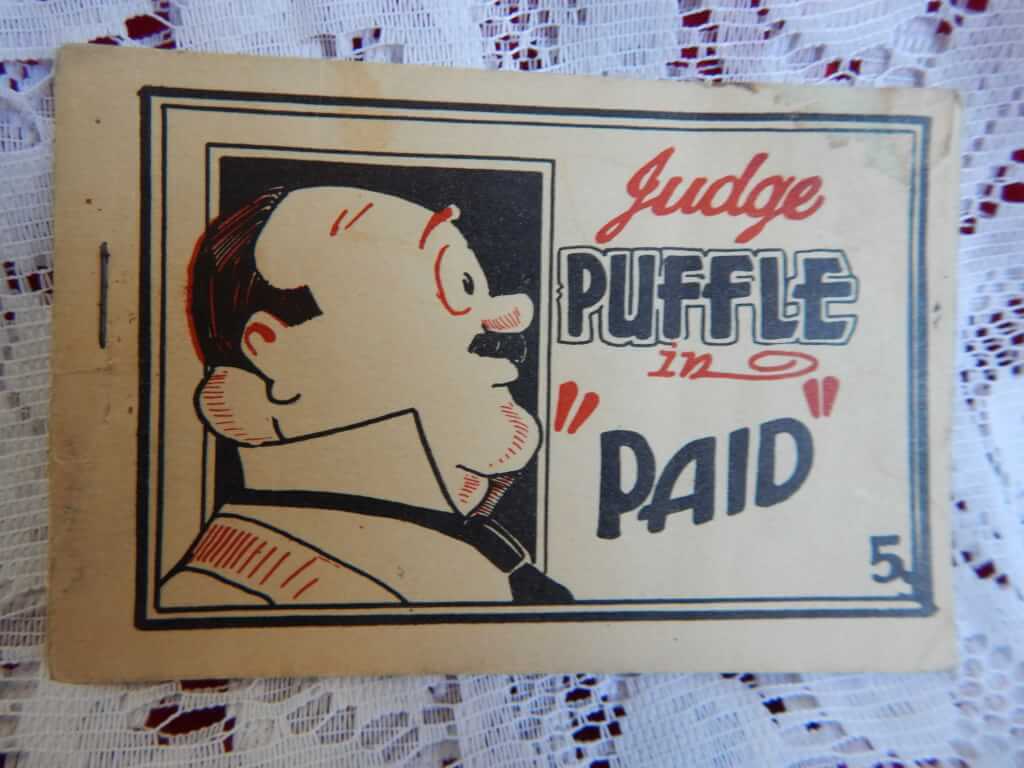 Judge Puffle in "Paid", (np. nd.) 4.5" x 3", 8pp. pamphlet, stapled Tijuana bibles (also known as eight-pagers, bluesies, gray-backs, Jiggs-and-Maggie books, jo-jo books, Tillie-and-Mac books, and two-by-fours) were little pornographic comic books produced in the United States from the 1920s to the early 1960s.
Judge Puffle in "Paid", (np. nd.) 4.5" x 3", 8pp. pamphlet, stapled Tijuana bibles (also known as eight-pagers, bluesies, gray-backs, Jiggs-and-Maggie books, jo-jo books, Tillie-and-Mac books, and two-by-fours) were little pornographic comic books produced in the United States from the 1920s to the early 1960s. -
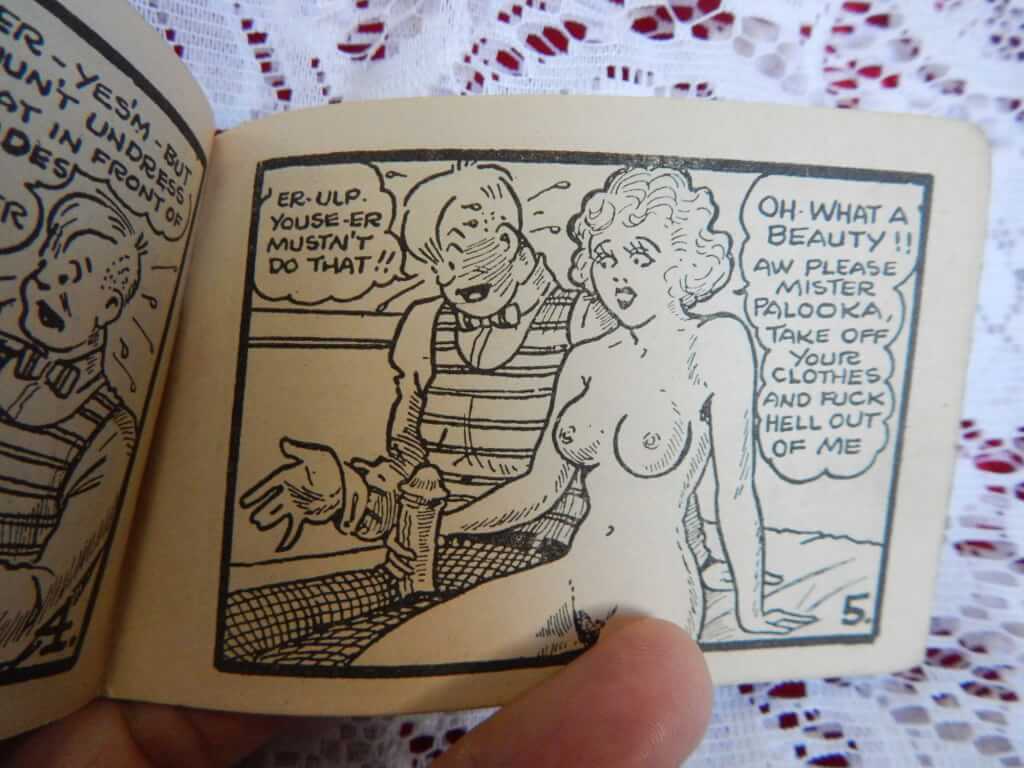
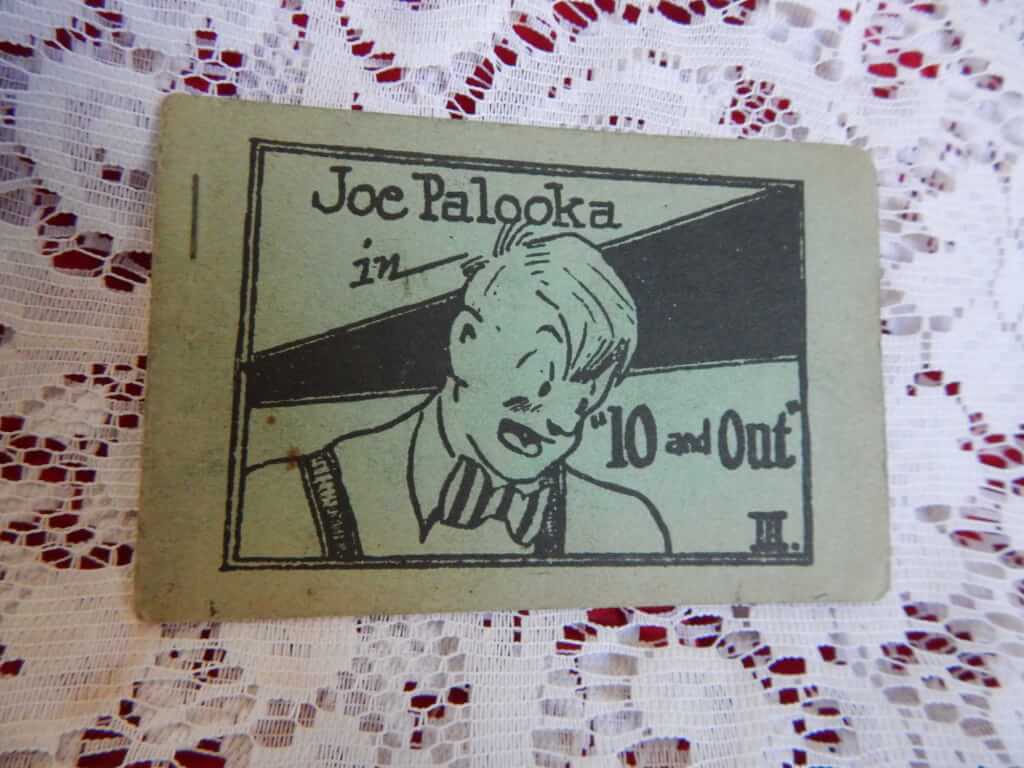 Joe Palooka in "10 and Out", (n.p. n.d.) 4.5" x 3", 8pp. pamphlet, stapled Tijuana bibles (also known as eight-pagers, bluesies, gray-backs, Jiggs-and-Maggie books, jo-jo books, Tillie-and-Mac books, and two-by-fours) were little pornographic comic books produced in the United States from the 1920s to the early 1960s.
Joe Palooka in "10 and Out", (n.p. n.d.) 4.5" x 3", 8pp. pamphlet, stapled Tijuana bibles (also known as eight-pagers, bluesies, gray-backs, Jiggs-and-Maggie books, jo-jo books, Tillie-and-Mac books, and two-by-fours) were little pornographic comic books produced in the United States from the 1920s to the early 1960s. -
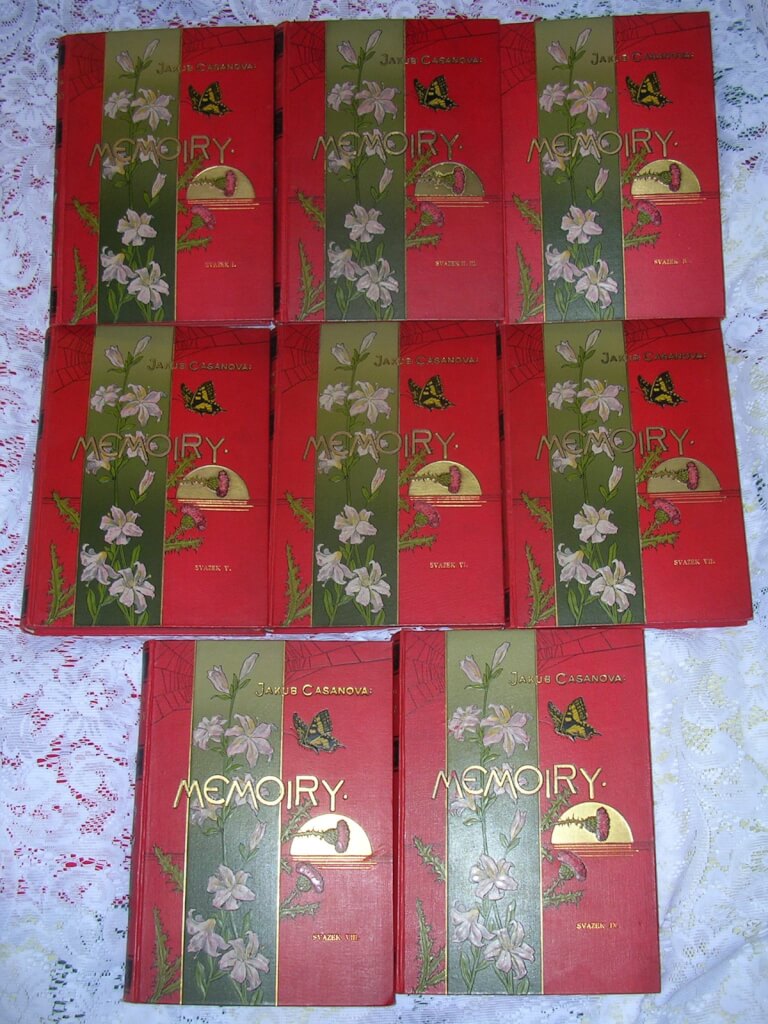
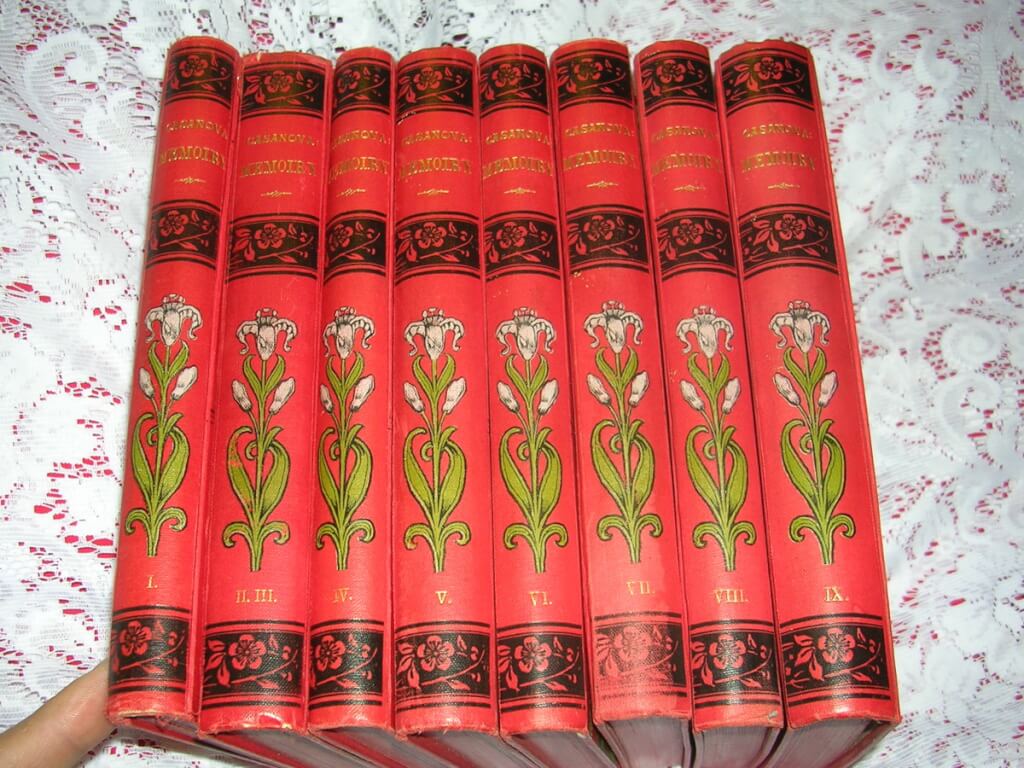 Jakub Casanova: Memoiry (Czech: Cassanova's Memoirs), Giacomo Casanova (Alois Hynek, J. Rokyta, Praze, n.d. [c. 1890-1900]) 8.75" X 6.25" 9 vol. in 8 books 275pp. [220pp 144pp in one vol.] 283pp. 358pp. 304pp. 356pp. 326pp. 345 i-v. Hardcover with beautifully decorated red cloth boards. Very good condition. Rare complete set with full color boards. Even more rare copy translated into Czech. Giovanni Giacomo Casanova (1725-1798) was an ecclesiastic, writer, soldier, spy, and diplomatist, chiefly remembered as the prince of Italian adventurers and as the man who made the name Casanova synonymous with "libertine." His autobiography, which perhaps exaggerates some of his escapades, is a splendid description of 18th-century society in the capitals of Europe. This is a beautiful Czech edition, 9 volumes in 8 books in publisher's original decorative cloth-binding. A beautifully bound edition. I am unable to find another complete set. The only other place I can find mention these books is in the Czech National Library.
Jakub Casanova: Memoiry (Czech: Cassanova's Memoirs), Giacomo Casanova (Alois Hynek, J. Rokyta, Praze, n.d. [c. 1890-1900]) 8.75" X 6.25" 9 vol. in 8 books 275pp. [220pp 144pp in one vol.] 283pp. 358pp. 304pp. 356pp. 326pp. 345 i-v. Hardcover with beautifully decorated red cloth boards. Very good condition. Rare complete set with full color boards. Even more rare copy translated into Czech. Giovanni Giacomo Casanova (1725-1798) was an ecclesiastic, writer, soldier, spy, and diplomatist, chiefly remembered as the prince of Italian adventurers and as the man who made the name Casanova synonymous with "libertine." His autobiography, which perhaps exaggerates some of his escapades, is a splendid description of 18th-century society in the capitals of Europe. This is a beautiful Czech edition, 9 volumes in 8 books in publisher's original decorative cloth-binding. A beautifully bound edition. I am unable to find another complete set. The only other place I can find mention these books is in the Czech National Library. -

 J. Wellington, Wimpy in "Back to his First Love" / That's My Pop, (n.p., n.d.) 5" x 3.5", 8pp. double pamphlet, stapled Tijuana bibles (also known as eight-pagers, bluesies, gray-backs, Jiggs-and-Maggie books, jo-jo books, Tillie-and-Mac books, and two-by-fours) were little pornographic comic books produced in the United States from the 1920s to the early 1960s. This book is two books in one, featuring reprints of the originals printed on both sides of the paper. Flip the book over and it's a different book.
J. Wellington, Wimpy in "Back to his First Love" / That's My Pop, (n.p., n.d.) 5" x 3.5", 8pp. double pamphlet, stapled Tijuana bibles (also known as eight-pagers, bluesies, gray-backs, Jiggs-and-Maggie books, jo-jo books, Tillie-and-Mac books, and two-by-fours) were little pornographic comic books produced in the United States from the 1920s to the early 1960s. This book is two books in one, featuring reprints of the originals printed on both sides of the paper. Flip the book over and it's a different book. -
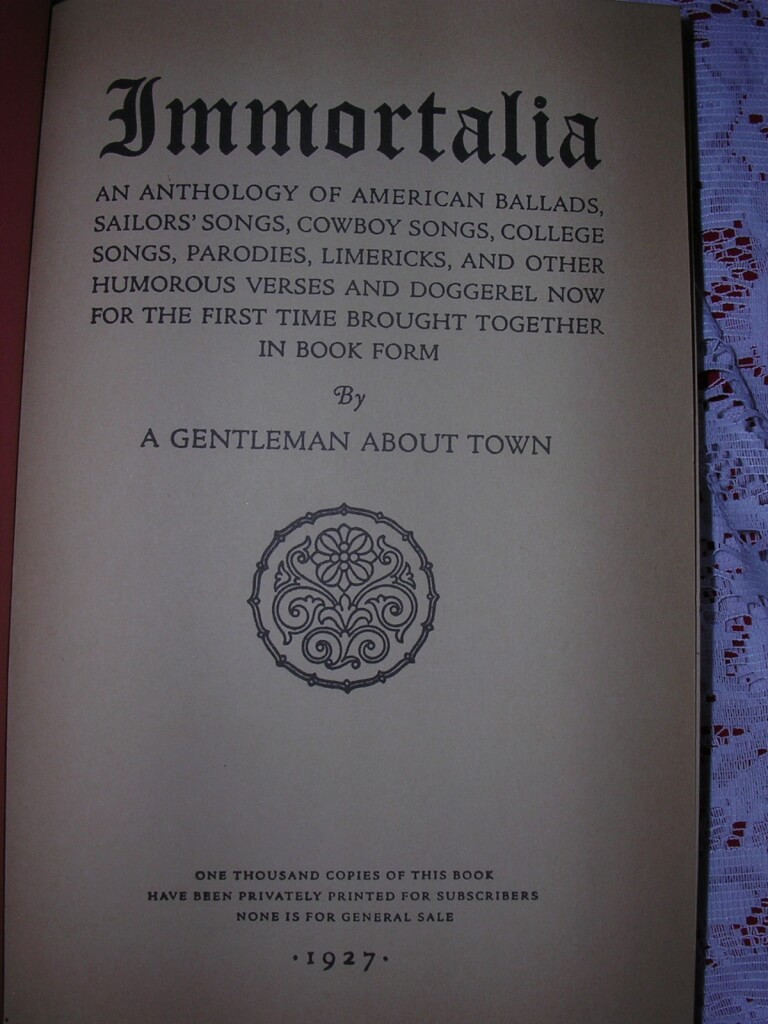
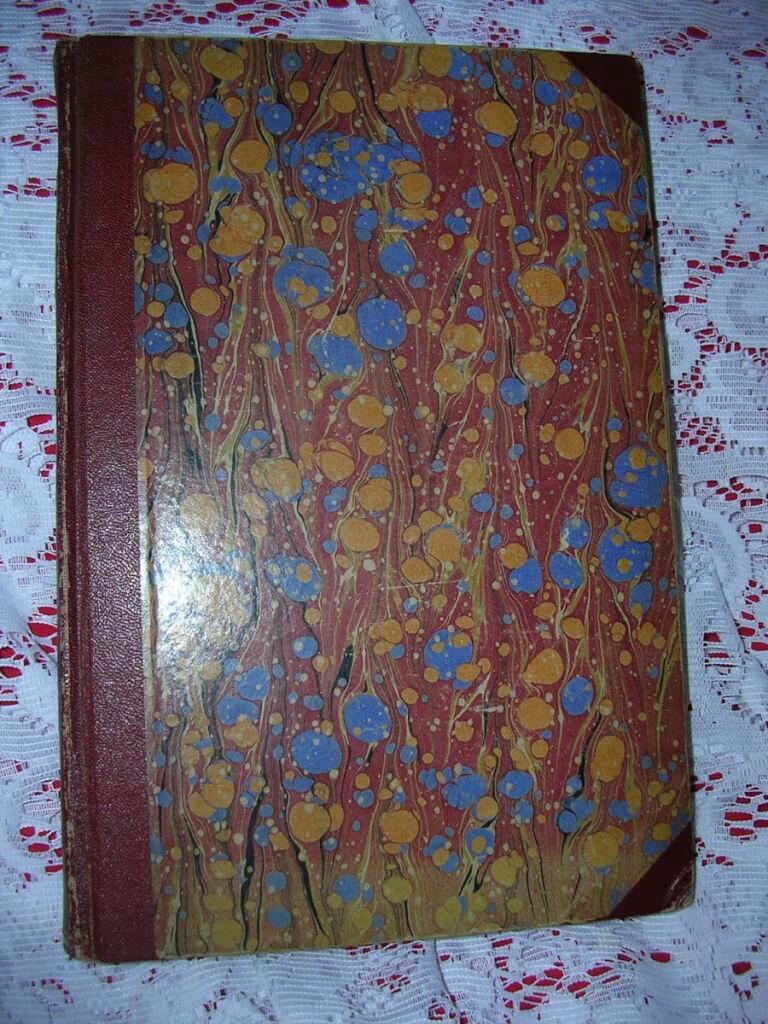 Immortalia, an anthology of american ballads, sailors' songs, cowboy songs, college songs, parodies, limericks, and other humorous verses and doggerel now for the first time brought together in book form, "By A Gentleman About Town" [T. R. Smith?] ("...privately printed for subscribers, none is for general sale" 1927 [pirated edition from the 2nd printing 1928 edtion, c.1932. New York: Samuel Roth or, less likely, Philadelphia: Nathan Young and Robert Sterling].) 6" x 8.75", iii, 184 pp., hardbound no DJ, decorated paper boards, cloth on spine and corners, worn edges on boards, corners bumped, binding tight. Assumed to be edited by T. R. Smith (George Macy, editor of Poetica Erotica around the same time). This is the most influential and widely published/circulated collection of "bawdry". Most collections since borrow from it liberally. There is a heavy emphasis on limericks (103 to be exact). Included are poems/"doggerel" attributed to James Joyce and D.H. Lawrence.
Immortalia, an anthology of american ballads, sailors' songs, cowboy songs, college songs, parodies, limericks, and other humorous verses and doggerel now for the first time brought together in book form, "By A Gentleman About Town" [T. R. Smith?] ("...privately printed for subscribers, none is for general sale" 1927 [pirated edition from the 2nd printing 1928 edtion, c.1932. New York: Samuel Roth or, less likely, Philadelphia: Nathan Young and Robert Sterling].) 6" x 8.75", iii, 184 pp., hardbound no DJ, decorated paper boards, cloth on spine and corners, worn edges on boards, corners bumped, binding tight. Assumed to be edited by T. R. Smith (George Macy, editor of Poetica Erotica around the same time). This is the most influential and widely published/circulated collection of "bawdry". Most collections since borrow from it liberally. There is a heavy emphasis on limericks (103 to be exact). Included are poems/"doggerel" attributed to James Joyce and D.H. Lawrence. -
 Held Down and Birched, artist unknown Print from: Nell in Bridewell: Description of the System of Corporal Punishment (Flagellation) in the Female Prisons of South Germany up to the year 1848 W. Reinhard, trans. W.C. Costello Ph. D. and A. R. Allinson M. A. (Psych Press [New York], 1932) Image: 7" x 10", high-resolution ink-jet print Paper: 8.5" x 11", 65lb White paper
Held Down and Birched, artist unknown Print from: Nell in Bridewell: Description of the System of Corporal Punishment (Flagellation) in the Female Prisons of South Germany up to the year 1848 W. Reinhard, trans. W.C. Costello Ph. D. and A. R. Allinson M. A. (Psych Press [New York], 1932) Image: 7" x 10", high-resolution ink-jet print Paper: 8.5" x 11", 65lb White paper -

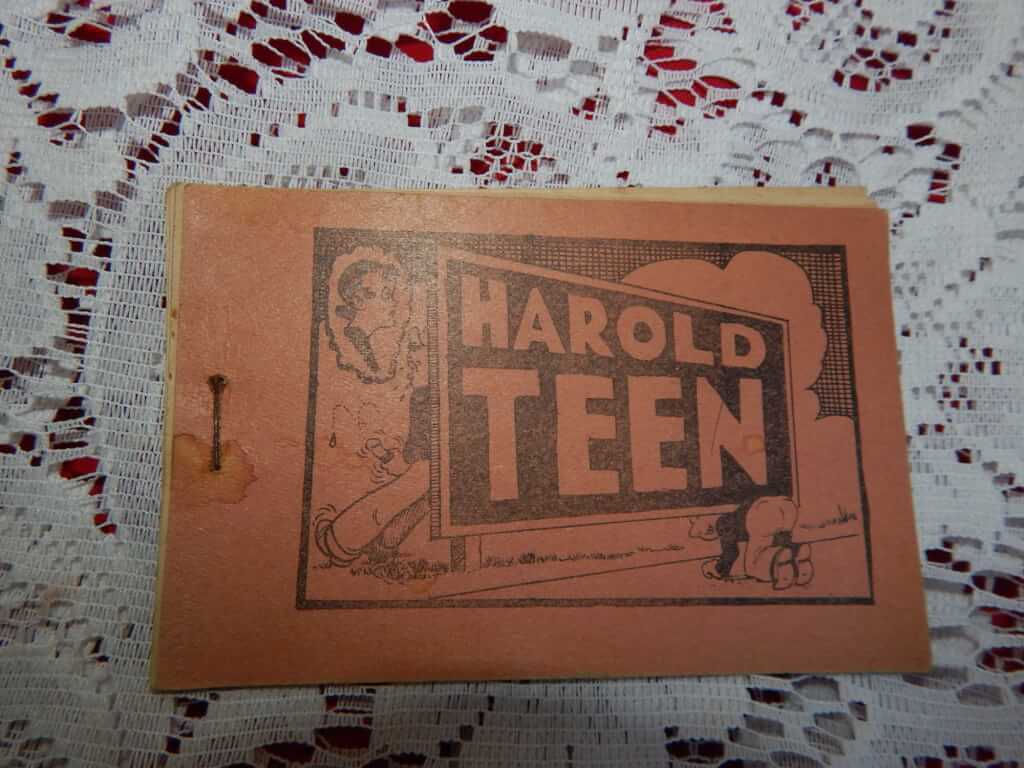 Harold Teen, (n.p. n.d.) 4.5" x 3", 8pp. pamphlet, stapled Tijuana bibles (also known as eight-pagers, bluesies, gray-backs, Jiggs-and-Maggie books, jo-jo books, Tillie-and-Mac books, and two-by-fours) were little pornographic comic books produced in the United States from the 1920s to the early 1960s.
Harold Teen, (n.p. n.d.) 4.5" x 3", 8pp. pamphlet, stapled Tijuana bibles (also known as eight-pagers, bluesies, gray-backs, Jiggs-and-Maggie books, jo-jo books, Tillie-and-Mac books, and two-by-fours) were little pornographic comic books produced in the United States from the 1920s to the early 1960s. -
Out of stock
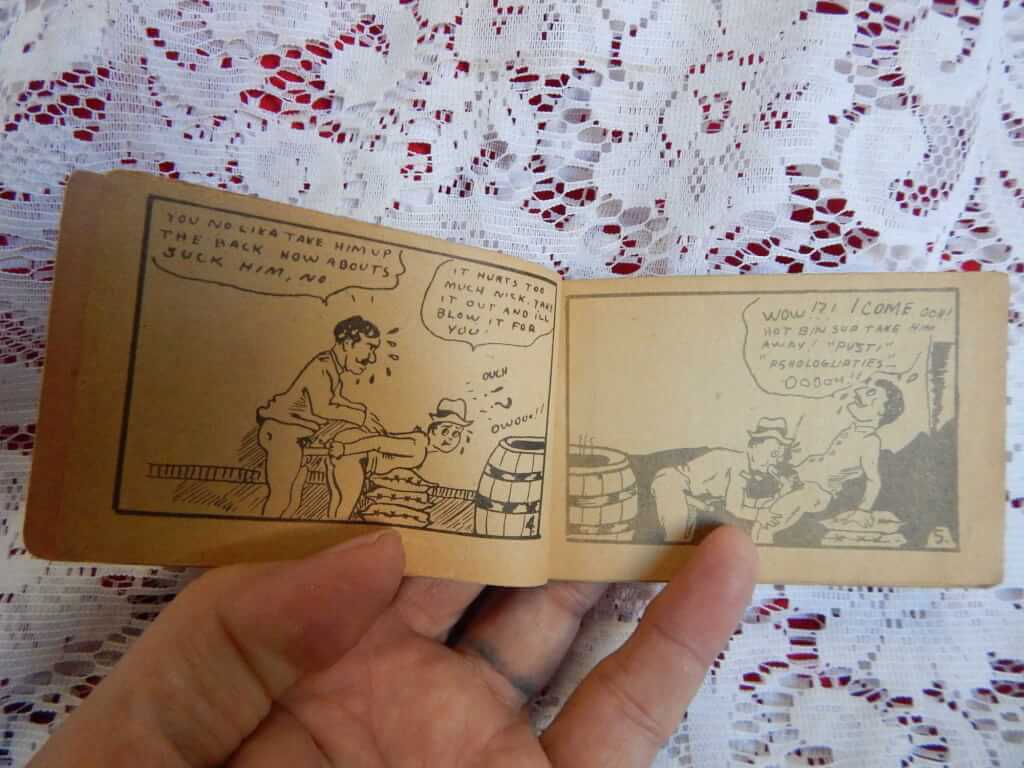
 Harold Teen, (n.p. n.d.) 4.5" x 3", 8pp. pamphlet, stapled Tijuana bibles (also known as eight-pagers, bluesies, gray-backs, Jiggs-and-Maggie books, jo-jo books, Tillie-and-Mac books, and two-by-fours) were little pornographic comic books produced in the United States from the 1920s to the early 1960s.
Harold Teen, (n.p. n.d.) 4.5" x 3", 8pp. pamphlet, stapled Tijuana bibles (also known as eight-pagers, bluesies, gray-backs, Jiggs-and-Maggie books, jo-jo books, Tillie-and-Mac books, and two-by-fours) were little pornographic comic books produced in the United States from the 1920s to the early 1960s. -
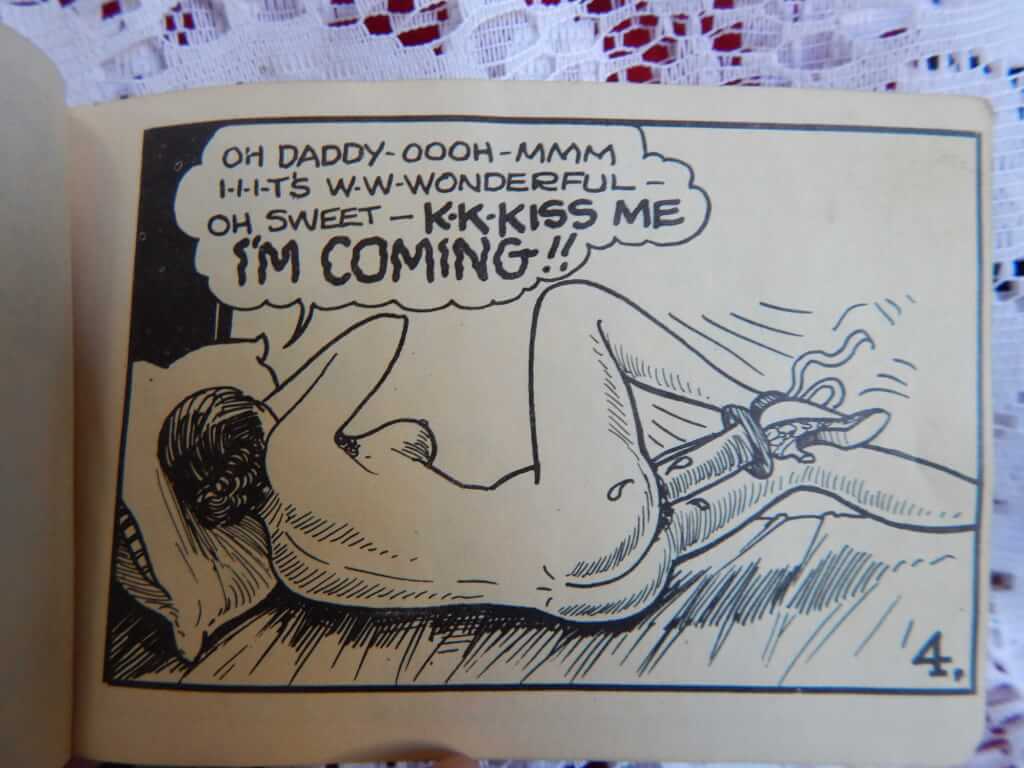
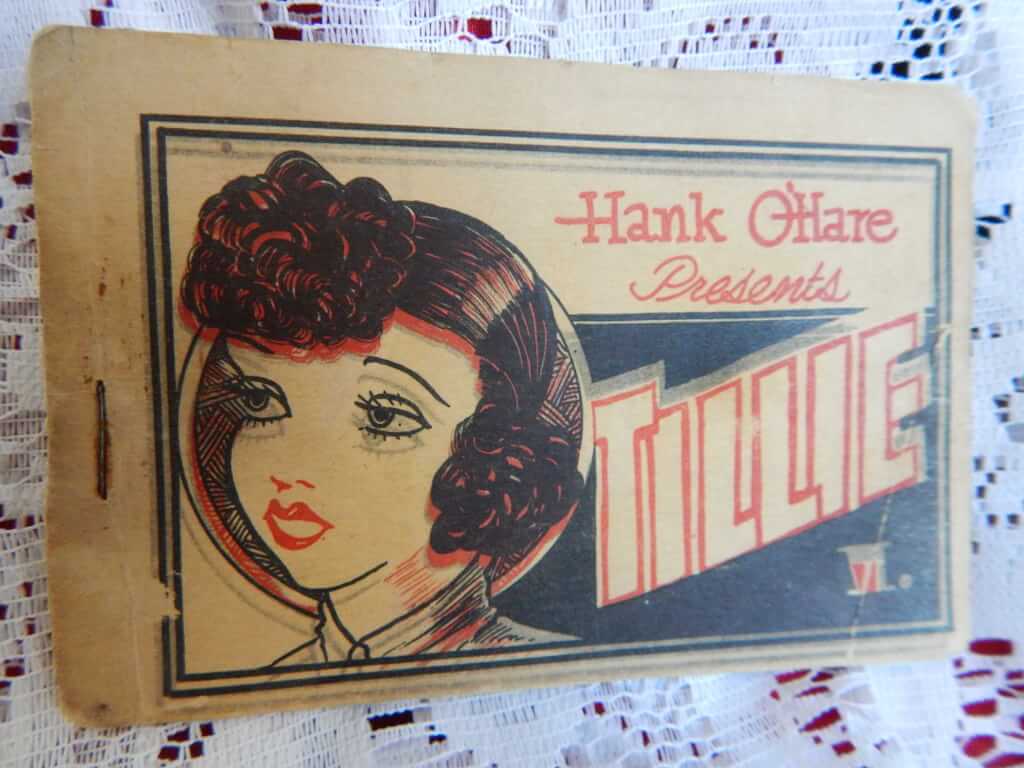 Hank O'Hare presents Tillie, (np. nd.) 4.5" x 3", 8pp., pamphlet, stapled and taped Tijuana bibles (also known as eight-pagers, bluesies, gray-backs, Jiggs-and-Maggie books, jo-jo books, Tillie-and-Mac books, and two-by-fours) were little pornographic comic books produced in the United States from the 1920s to the early 1960s.
Hank O'Hare presents Tillie, (np. nd.) 4.5" x 3", 8pp., pamphlet, stapled and taped Tijuana bibles (also known as eight-pagers, bluesies, gray-backs, Jiggs-and-Maggie books, jo-jo books, Tillie-and-Mac books, and two-by-fours) were little pornographic comic books produced in the United States from the 1920s to the early 1960s. -
 Blue Book Treasury of Classic Tails | Volume 1 | Goldilocks, "Translated from the Old Saxon and Illustrated by Sir Rod Q. M'Gurk, Knight of the Brush" (Classic Tails, Inc., 1972) 11" X 8.5", 32pp, soft covers, good condition, some minor bumping to corners & scuffing to covers, near fine internal pages. Blue Book Treasury of Classic Tails | Volume 2 | Jack and the Beanstalk, "Translated from the Old Saxon and Illustrated by Sir Rod Q. M'Gurk, Knight of the Brush" (Classic Tails, Inc., 1972) 11" X 8.5", 32pp, soft covers, just good condition, bumping to corners & scuffing/soiling to covers, near fine internal pages. Blue Book Treasury of Classic Tails | Volume 3 | Little Red Riding Hood, by Fud Dicksworth III (Classic Tails, Inc., 1972) 11" X 8.5", 32pp, soft covers, good+ condition, some bumping to corners, VERY rare. I've been able to find a few references to this book and very little about "Sir Rod Q. M'Gurk" or "Fud Dicksworth III". M'Gurk apparently also had his cartoons published in Swank magazine c. 1976-7. Eventually it came to the attention of some illustrators and (with help of former Disney animators) was made into a movie by Don Jurwich (not sure the connection between him and Sir Rod Q. M'Gurk, but I'd love to know if it was him).
Blue Book Treasury of Classic Tails | Volume 1 | Goldilocks, "Translated from the Old Saxon and Illustrated by Sir Rod Q. M'Gurk, Knight of the Brush" (Classic Tails, Inc., 1972) 11" X 8.5", 32pp, soft covers, good condition, some minor bumping to corners & scuffing to covers, near fine internal pages. Blue Book Treasury of Classic Tails | Volume 2 | Jack and the Beanstalk, "Translated from the Old Saxon and Illustrated by Sir Rod Q. M'Gurk, Knight of the Brush" (Classic Tails, Inc., 1972) 11" X 8.5", 32pp, soft covers, just good condition, bumping to corners & scuffing/soiling to covers, near fine internal pages. Blue Book Treasury of Classic Tails | Volume 3 | Little Red Riding Hood, by Fud Dicksworth III (Classic Tails, Inc., 1972) 11" X 8.5", 32pp, soft covers, good+ condition, some bumping to corners, VERY rare. I've been able to find a few references to this book and very little about "Sir Rod Q. M'Gurk" or "Fud Dicksworth III". M'Gurk apparently also had his cartoons published in Swank magazine c. 1976-7. Eventually it came to the attention of some illustrators and (with help of former Disney animators) was made into a movie by Don Jurwich (not sure the connection between him and Sir Rod Q. M'Gurk, but I'd love to know if it was him). -
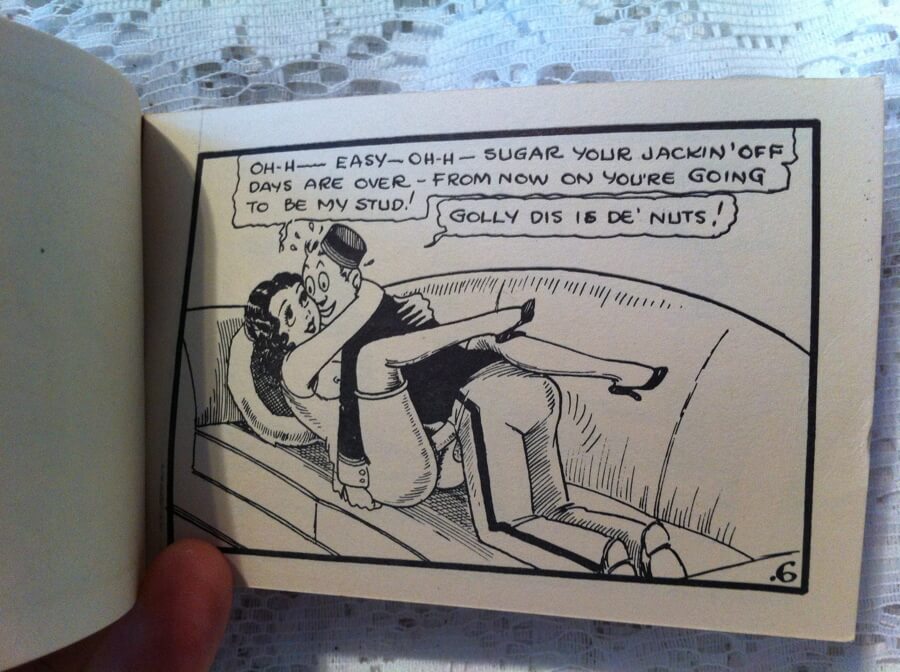
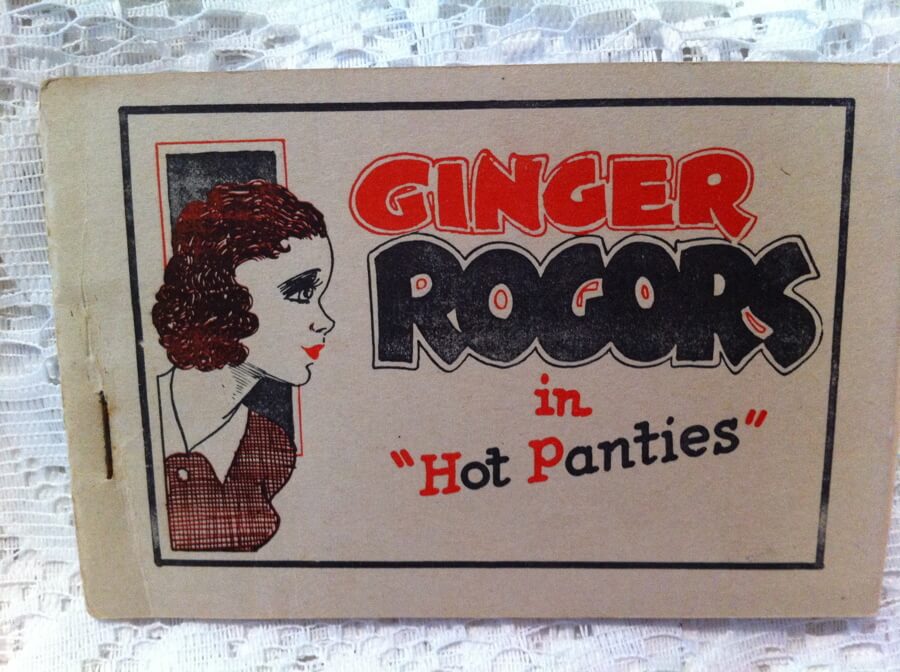 Ginger Rogers in "Hot Panties", (n.p. n.d.) 4.5" x 3", 8pp. pamphlet, stapled Tijuana bibles (also known as eight-pagers, bluesies, gray-backs, Jiggs-and-Maggie books, jo-jo books, Tillie-and-Mac books, and two-by-fours) were little pornographic comic books produced in the United States from the 1920s to the early 1960s.
Ginger Rogers in "Hot Panties", (n.p. n.d.) 4.5" x 3", 8pp. pamphlet, stapled Tijuana bibles (also known as eight-pagers, bluesies, gray-backs, Jiggs-and-Maggie books, jo-jo books, Tillie-and-Mac books, and two-by-fours) were little pornographic comic books produced in the United States from the 1920s to the early 1960s. -
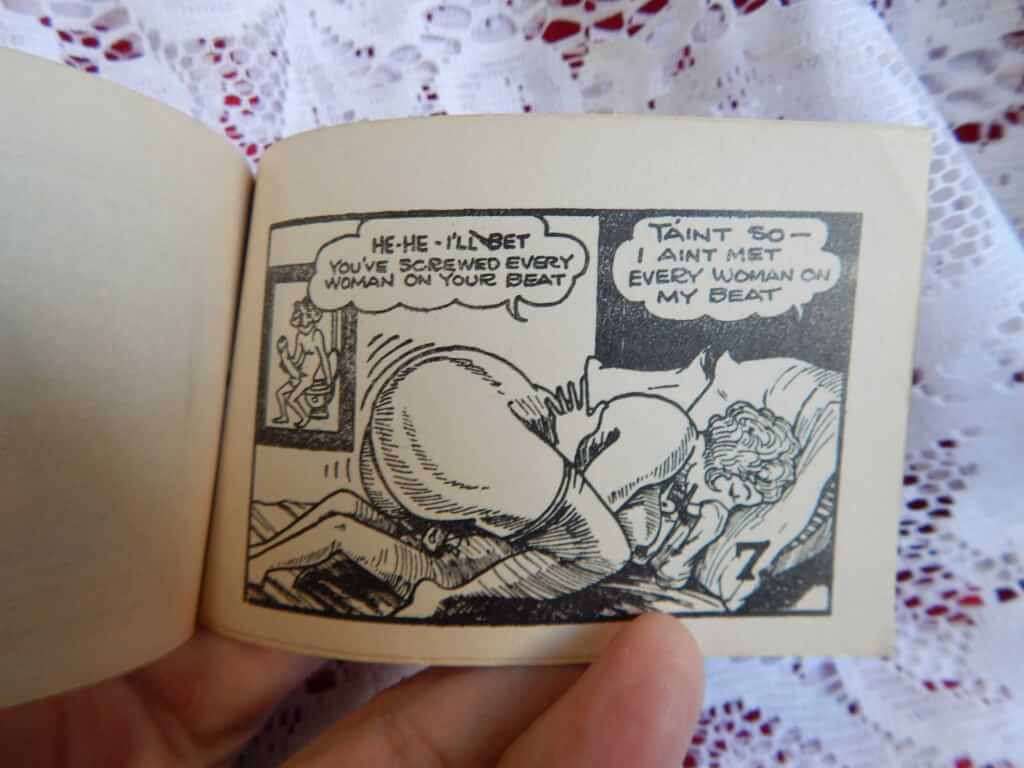
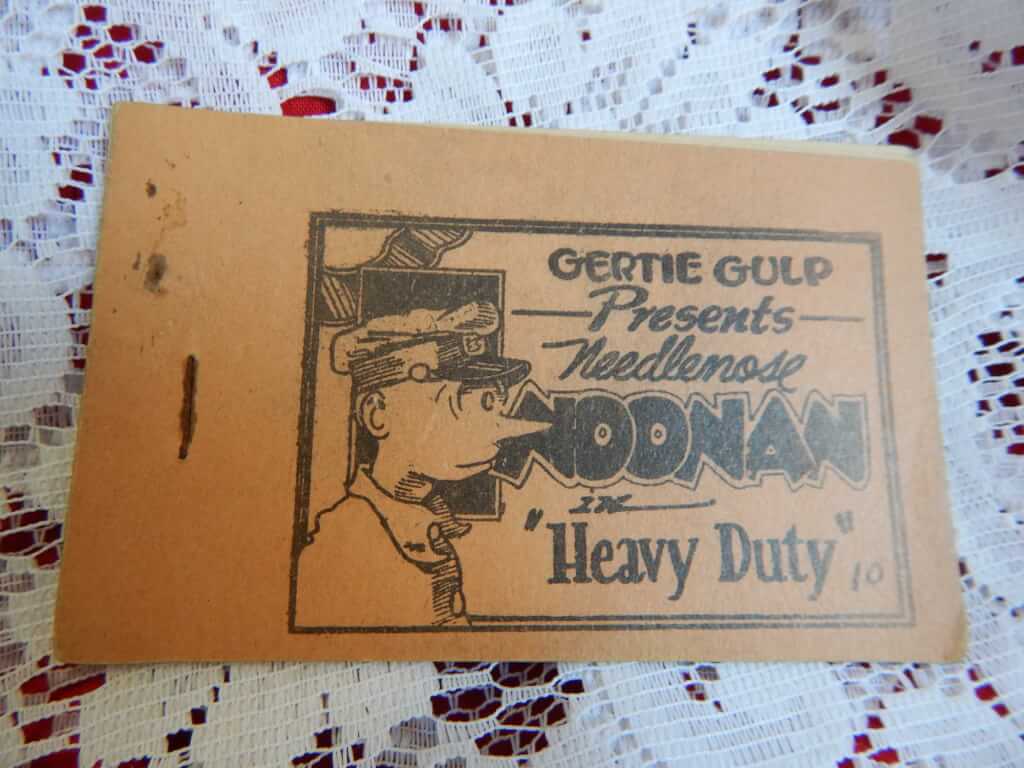 Gertie Gulp presents Needlenose Noonan in "Heavy Duty", (n.p. n.d.) 4.5" x 3", 8pp. pamphlet, stapled Tijuana bibles (also known as eight-pagers, bluesies, gray-backs, Jiggs-and-Maggie books, jo-jo books, Tillie-and-Mac books, and two-by-fours) were little pornographic comic books produced in the United States from the 1920s to the early 1960s.
Gertie Gulp presents Needlenose Noonan in "Heavy Duty", (n.p. n.d.) 4.5" x 3", 8pp. pamphlet, stapled Tijuana bibles (also known as eight-pagers, bluesies, gray-backs, Jiggs-and-Maggie books, jo-jo books, Tillie-and-Mac books, and two-by-fours) were little pornographic comic books produced in the United States from the 1920s to the early 1960s. -
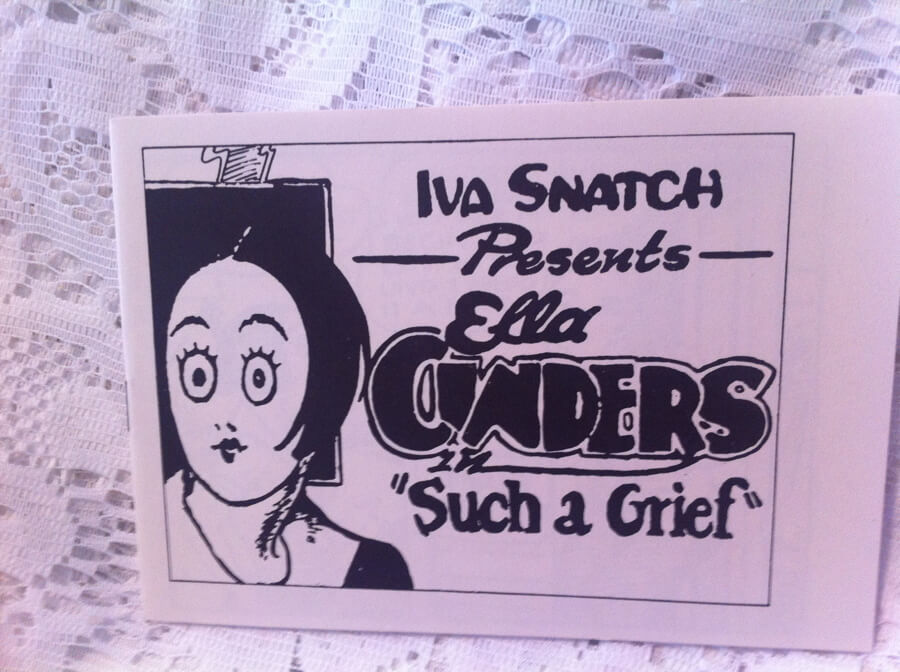
 George and Harry in "Doing Things" / Iva Snatch Presents Ella Cinders in "Such a Grief", (n.p., n.d.) 5" x 3.5", 8pp. double pamphlet, stapled Tijuana bibles (also known as eight-pagers, bluesies, gray-backs, Jiggs-and-Maggie books, jo-jo books, Tillie-and-Mac books, and two-by-fours) were little pornographic comic books produced in the United States from the 1920s to the early 1960s. This book is two books in one, featuring reprints of the originals printed on both sides of the paper. Flip the book over and it's a different book.
George and Harry in "Doing Things" / Iva Snatch Presents Ella Cinders in "Such a Grief", (n.p., n.d.) 5" x 3.5", 8pp. double pamphlet, stapled Tijuana bibles (also known as eight-pagers, bluesies, gray-backs, Jiggs-and-Maggie books, jo-jo books, Tillie-and-Mac books, and two-by-fours) were little pornographic comic books produced in the United States from the 1920s to the early 1960s. This book is two books in one, featuring reprints of the originals printed on both sides of the paper. Flip the book over and it's a different book. -
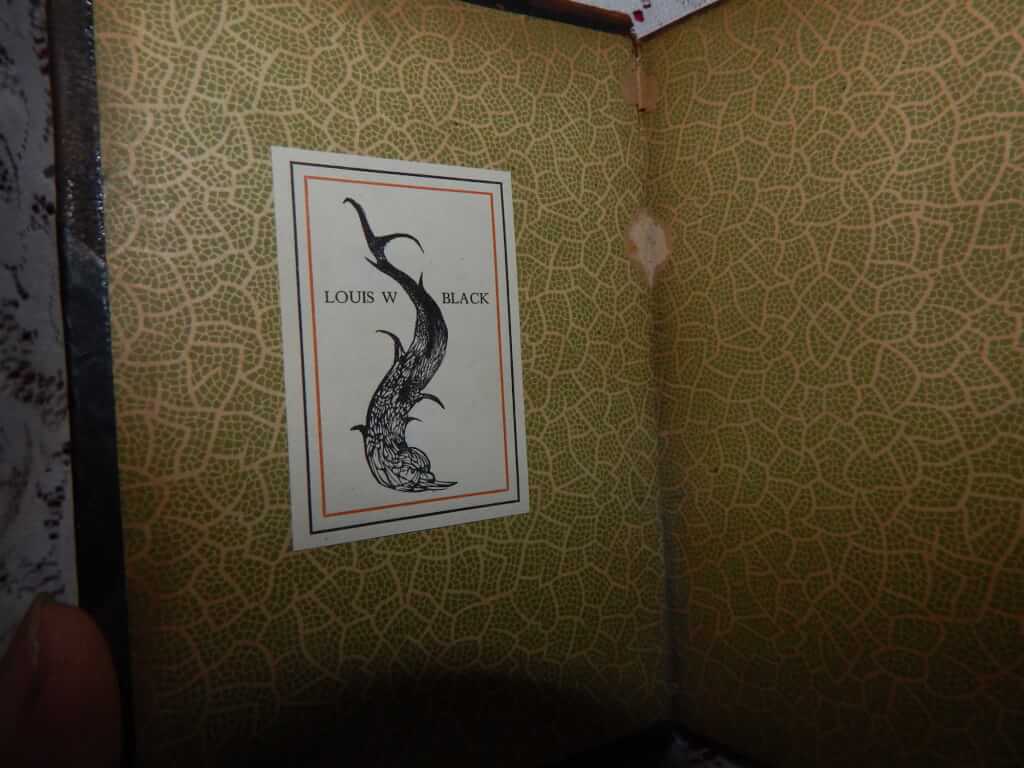
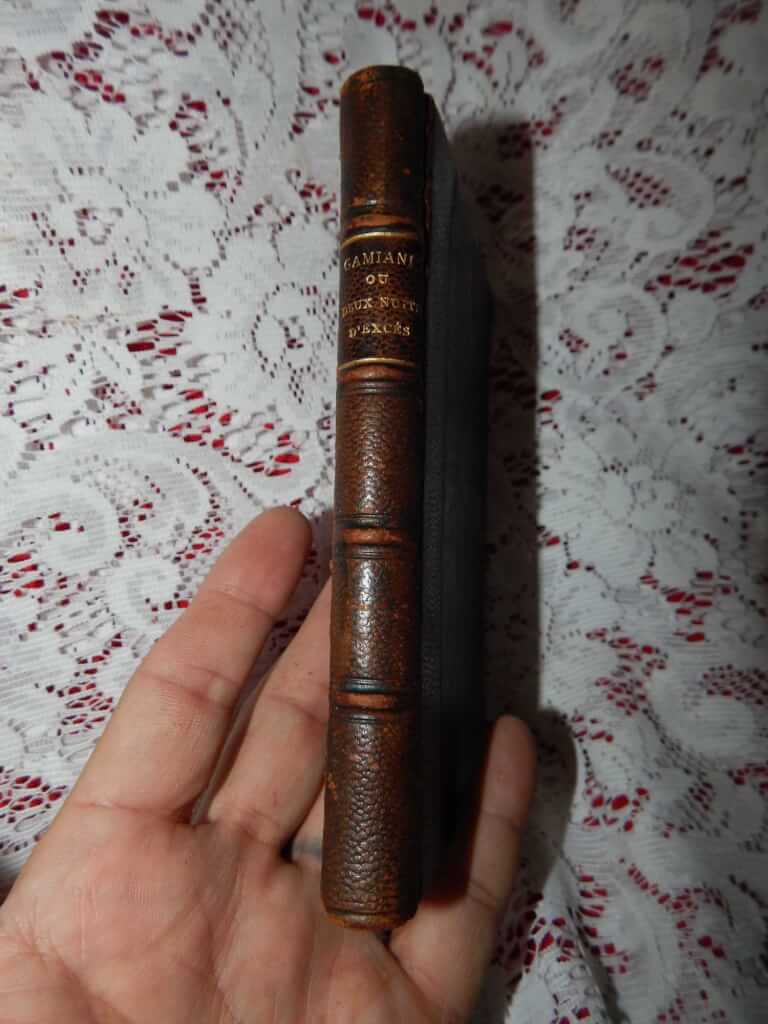 Gamiani, ou deux nuits d'excés par Alcide, Baron de M***, anonymous [believed to have been written by Alfred de Musset] (G. Lebaucher, Libraire-Éditeur, Montreal, Canada [likely Gaucher, Malakoff, France] nd.) 4.5"x6", 144pp, half morocco over marbled boards, title in gilt on spine, 4 raised bands, boards cracked but holding, just good condition Gamiani, or Two Nights of Excess is a French erotic novel first published in 1833. Its authorship is anonymous, but it is believed to have been written by Alfred de Musset and the lesbian eponymous heroine a portrait of his lover, George Sand. It became a bestseller among nineteenth century erotic literature. Modeled after George Sand, this work gives us a young man named Alcide observing the Countess Gamiani and a young girl named Fanny, engaged in their lesbian bed. Having watched them and provoked by their abandonment, he reveals himself, joins them, and they spend the night alternately sharing their intimate histories and their bodies. The stories they tell include the rape of one in a monastery and the nearly fatal debauchment of another in a convent, as well as encounters with a number of animals, including an ape and a donkey. Elias Gaucher (publisher from 1898 until 1925(?)) was a Clandestine editor who mainly used the pseudonym G. Lebaucher, Libraire-Éditeur, Montreal (Canada), but also Maison Mystère, Imprimerie Galante, etc. This publisher published many erotic underground works in English from 1898 to about 1904 with the mentions "Printed for the Erotica Biblion Society of London and New York", he also published erotic texts in French from 1899. His printing press was actually located at 11 rue Danicourt in Malakoff, France. Gaucher left his works in deposit with booksellers-distributors [...] Most editions of Gaucher are counterfeit editions of Brancart or Hirsch, and Gaucher often republished his own works.
Gamiani, ou deux nuits d'excés par Alcide, Baron de M***, anonymous [believed to have been written by Alfred de Musset] (G. Lebaucher, Libraire-Éditeur, Montreal, Canada [likely Gaucher, Malakoff, France] nd.) 4.5"x6", 144pp, half morocco over marbled boards, title in gilt on spine, 4 raised bands, boards cracked but holding, just good condition Gamiani, or Two Nights of Excess is a French erotic novel first published in 1833. Its authorship is anonymous, but it is believed to have been written by Alfred de Musset and the lesbian eponymous heroine a portrait of his lover, George Sand. It became a bestseller among nineteenth century erotic literature. Modeled after George Sand, this work gives us a young man named Alcide observing the Countess Gamiani and a young girl named Fanny, engaged in their lesbian bed. Having watched them and provoked by their abandonment, he reveals himself, joins them, and they spend the night alternately sharing their intimate histories and their bodies. The stories they tell include the rape of one in a monastery and the nearly fatal debauchment of another in a convent, as well as encounters with a number of animals, including an ape and a donkey. Elias Gaucher (publisher from 1898 until 1925(?)) was a Clandestine editor who mainly used the pseudonym G. Lebaucher, Libraire-Éditeur, Montreal (Canada), but also Maison Mystère, Imprimerie Galante, etc. This publisher published many erotic underground works in English from 1898 to about 1904 with the mentions "Printed for the Erotica Biblion Society of London and New York", he also published erotic texts in French from 1899. His printing press was actually located at 11 rue Danicourt in Malakoff, France. Gaucher left his works in deposit with booksellers-distributors [...] Most editions of Gaucher are counterfeit editions of Brancart or Hirsch, and Gaucher often republished his own works. -
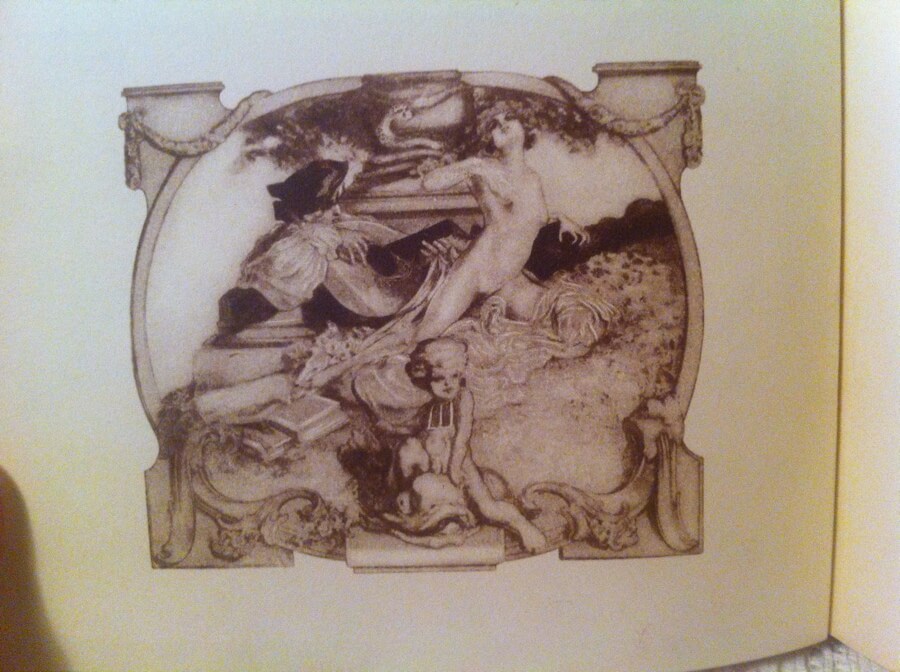
 Galante Lieder und Gedichte, Concordia Ball 25. Jänner 1926 [Galante songs and poems with images after originals by Franz von Bayros selected by Johannes Pilz and Viktor Wögerer, Concordia Ball, January 25, 1926] (Der Presseclub Concordia, Strache, Vienna 1926) 6.5"x4.75", very good condition, boards slightly rubbed and stained, interior fine, with carrying strap intact. Press Club Concordia, an organization of Austrian journalists and writers, has been holding a traditional Viennese ball at the Vienna City Hall each June for over 150 years. In 1926 their program book featured art by Franz von Bayros. The illustrations feature both erotic and musical themes. This is a great piece of European/Austrian interbellum history, a rare find in this condition with the carrying strap still intact.
Galante Lieder und Gedichte, Concordia Ball 25. Jänner 1926 [Galante songs and poems with images after originals by Franz von Bayros selected by Johannes Pilz and Viktor Wögerer, Concordia Ball, January 25, 1926] (Der Presseclub Concordia, Strache, Vienna 1926) 6.5"x4.75", very good condition, boards slightly rubbed and stained, interior fine, with carrying strap intact. Press Club Concordia, an organization of Austrian journalists and writers, has been holding a traditional Viennese ball at the Vienna City Hall each June for over 150 years. In 1926 their program book featured art by Franz von Bayros. The illustrations feature both erotic and musical themes. This is a great piece of European/Austrian interbellum history, a rare find in this condition with the carrying strap still intact. -

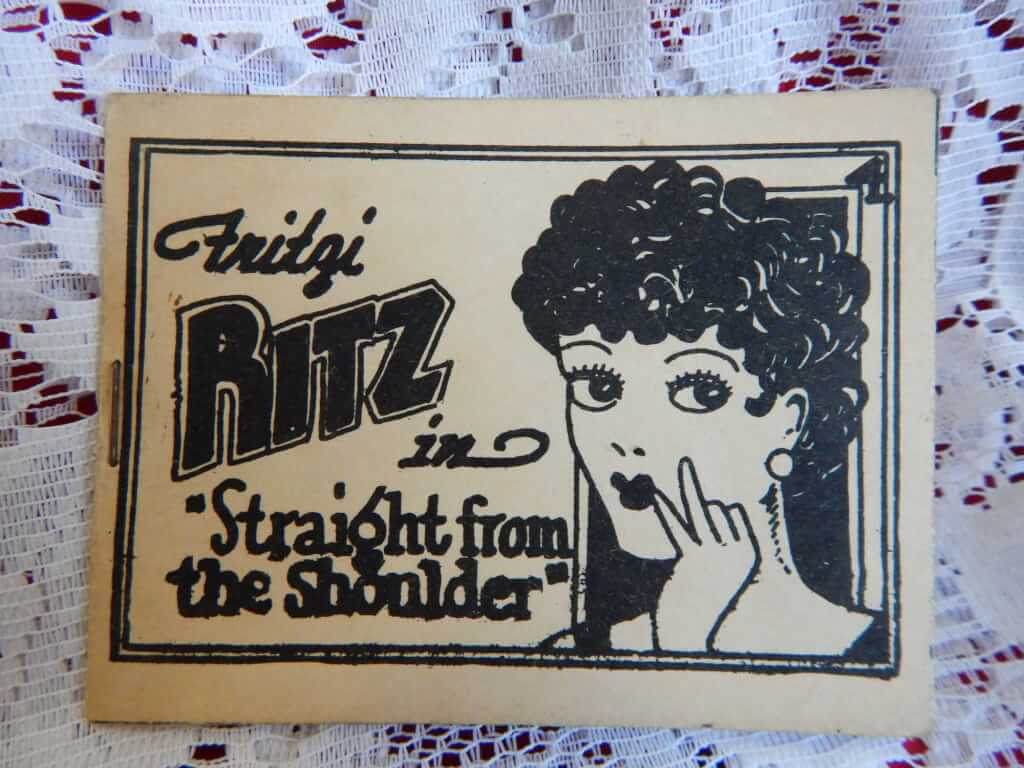 Fritzi Ritz in "Straight from the Shoulder", (n.p. n.d.) 4.5" x 3", 8pp. pamphlet, stapled, pages loose Tijuana bibles (also known as eight-pagers, bluesies, gray-backs, Jiggs-and-Maggie books, jo-jo books, Tillie-and-Mac books, and two-by-fours) were little pornographic comic books produced in the United States from the 1920s to the early 1960s.
Fritzi Ritz in "Straight from the Shoulder", (n.p. n.d.) 4.5" x 3", 8pp. pamphlet, stapled, pages loose Tijuana bibles (also known as eight-pagers, bluesies, gray-backs, Jiggs-and-Maggie books, jo-jo books, Tillie-and-Mac books, and two-by-fours) were little pornographic comic books produced in the United States from the 1920s to the early 1960s. -
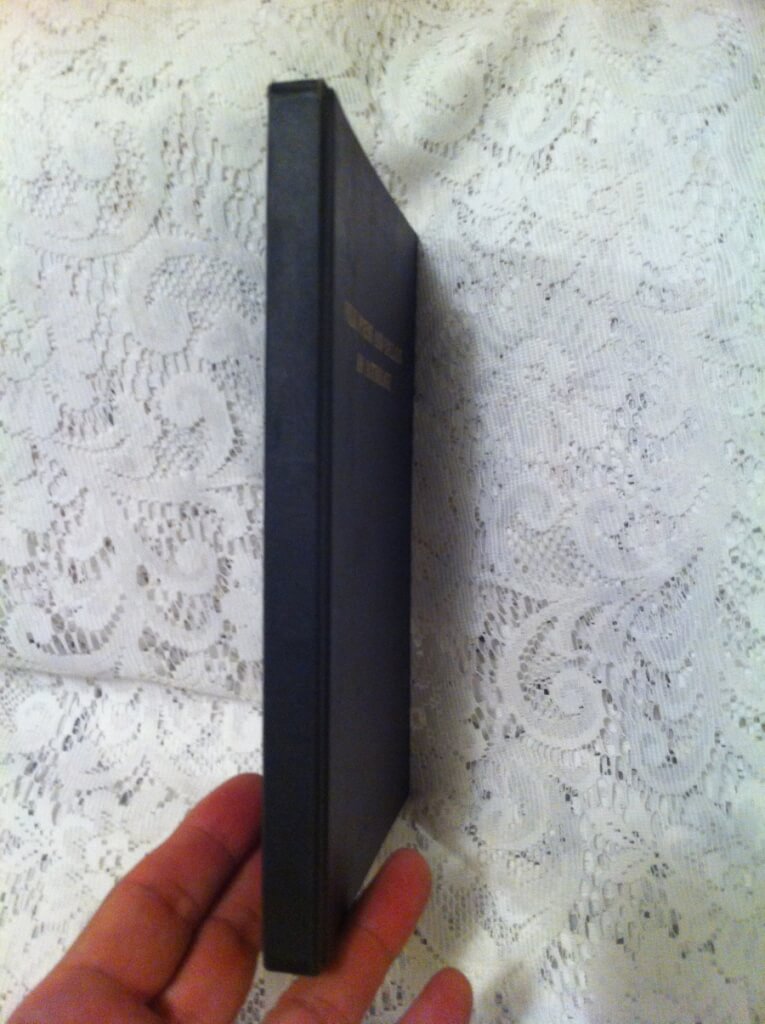
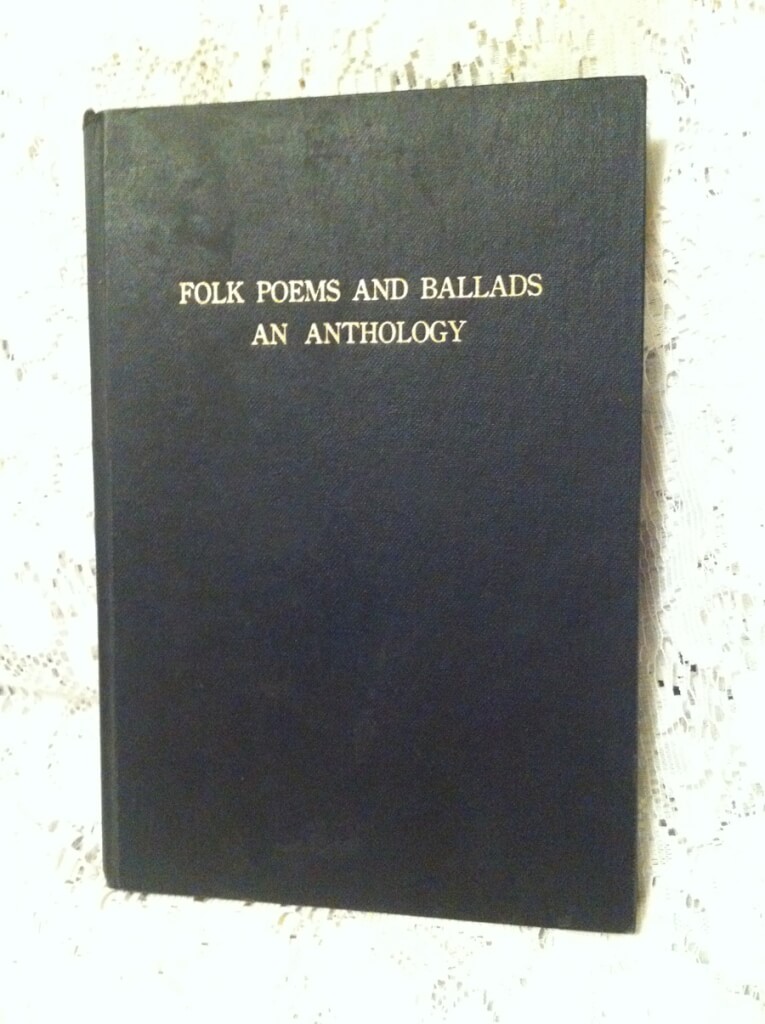 Folk Poems and Ballads An Anthology, anonymous [A. Reynolds Morse] ( Cruciform Press, Mexico City: Privately Printed for Private Circulation to Subscribers Only, 1944 [Cleveland, Ohio: A. Reynolds Morse, 1948.] #230/250) 8" X 5.5", vi 128pp. Hardbound, black cloth boards, gilt lettering on cover. Fair condition, 1st signature detached, 4th signature loose but holding (a common problem with these books), good copy of a poorly made book. Subtitled: "A collection of rare verses and amusing folk songs compiled from scarce and suppressed books as well as from verbal sources which modern prudery, false social customs, and intolerance laws have separated from the public and historical record." A. Reynolds Morse was an American, born in 1914, who died in 2000. He moved to Cleveland from Denver in 1941. An industrialist and philanthropist, he is best known for his activity in collecting works by Salvador Dali, and founding the Salvador Dali Museum. According to his obituary in the New York Times, Reynolds and his wife "embarked on a sometimes turbulent friendship with Dali and his wife, Gala". He also had a hobby of collecting and publishing works that other publishers would not print. Title page: "A collection of rare verses and amusing folk songs compiled from scarce and suppressed books as well as from verbal sources which modern prudery, false social customs, and intolerance have separated from the public and historical record." Mr. Morse also published "Limericks, A Facet of Our Culture". Both books were suppressed by police action in the late 1940's. This is the more rare of the two books.
Folk Poems and Ballads An Anthology, anonymous [A. Reynolds Morse] ( Cruciform Press, Mexico City: Privately Printed for Private Circulation to Subscribers Only, 1944 [Cleveland, Ohio: A. Reynolds Morse, 1948.] #230/250) 8" X 5.5", vi 128pp. Hardbound, black cloth boards, gilt lettering on cover. Fair condition, 1st signature detached, 4th signature loose but holding (a common problem with these books), good copy of a poorly made book. Subtitled: "A collection of rare verses and amusing folk songs compiled from scarce and suppressed books as well as from verbal sources which modern prudery, false social customs, and intolerance laws have separated from the public and historical record." A. Reynolds Morse was an American, born in 1914, who died in 2000. He moved to Cleveland from Denver in 1941. An industrialist and philanthropist, he is best known for his activity in collecting works by Salvador Dali, and founding the Salvador Dali Museum. According to his obituary in the New York Times, Reynolds and his wife "embarked on a sometimes turbulent friendship with Dali and his wife, Gala". He also had a hobby of collecting and publishing works that other publishers would not print. Title page: "A collection of rare verses and amusing folk songs compiled from scarce and suppressed books as well as from verbal sources which modern prudery, false social customs, and intolerance have separated from the public and historical record." Mr. Morse also published "Limericks, A Facet of Our Culture". Both books were suppressed by police action in the late 1940's. This is the more rare of the two books. -
 Flogging, artist unknown Print from: Nell in Bridewell: Description of the System of Corporal Punishment (Flagellation) in the Female Prisons of South Germany up to the year 1848 W. Reinhard, trans. W.C. Costello Ph. D. and A. R. Allinson M. A. (Psych Press [New York], 1932) Image: 7" x 10", high-resolution ink-jet print Paper: 8.5" x 11", 65lb White paper
Flogging, artist unknown Print from: Nell in Bridewell: Description of the System of Corporal Punishment (Flagellation) in the Female Prisons of South Germany up to the year 1848 W. Reinhard, trans. W.C. Costello Ph. D. and A. R. Allinson M. A. (Psych Press [New York], 1932) Image: 7" x 10", high-resolution ink-jet print Paper: 8.5" x 11", 65lb White paper -
Out of stock
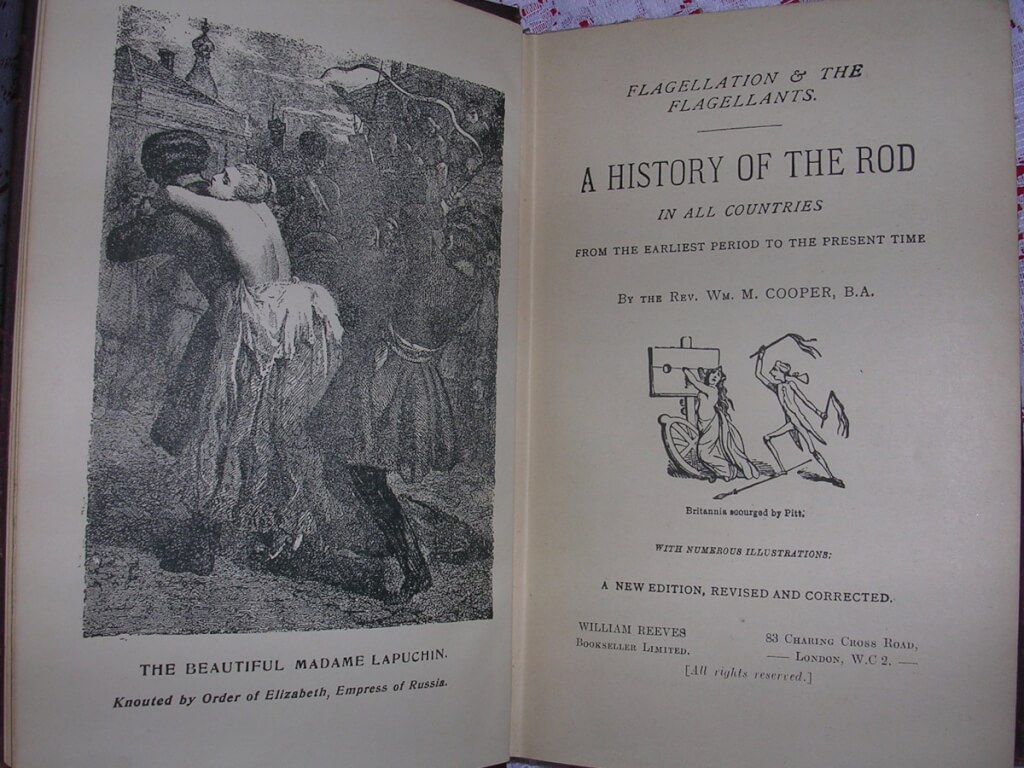
 Flagellation & the Flagellants. A History of the Rod in All Countries from the earliest period to the present time, The Rev. Wm. M. Cooper, B.A. [James Glass Bertram] (William Reeves Bookseller Limited, London, nd [c. 1908]) 7 3/4" X 5 1/4", 544pp, hardbound no DJ, dark purple cloth boards with gilt stamp and blind stamp decorations to boards and spine, good condition, minor bumping and rubbing, a few stains on lower fore-edge of boards. Bertram was apprenticed to Tait's Edinburgh Magazine and became managing clerk, before joining a company of strolling players. He returned to Edinburgh and set up as a bookseller and newsagent. In 1855 he was appointed the editor of the North Briton and in 1872 of the Glasgow News, leaving to become a freelance journalist two years later. He published "flagellation" pornography under the names "Revd William Cooper" and "Margaret Anson". This edition was published by William Reeves sometime around 1908.
Flagellation & the Flagellants. A History of the Rod in All Countries from the earliest period to the present time, The Rev. Wm. M. Cooper, B.A. [James Glass Bertram] (William Reeves Bookseller Limited, London, nd [c. 1908]) 7 3/4" X 5 1/4", 544pp, hardbound no DJ, dark purple cloth boards with gilt stamp and blind stamp decorations to boards and spine, good condition, minor bumping and rubbing, a few stains on lower fore-edge of boards. Bertram was apprenticed to Tait's Edinburgh Magazine and became managing clerk, before joining a company of strolling players. He returned to Edinburgh and set up as a bookseller and newsagent. In 1855 he was appointed the editor of the North Briton and in 1872 of the Glasgow News, leaving to become a freelance journalist two years later. He published "flagellation" pornography under the names "Revd William Cooper" and "Margaret Anson". This edition was published by William Reeves sometime around 1908. -
 Flagellation & the Flagellants. A History of the Rod in All Countries from the earliest period to the present time, The Rev. Wm. M. Cooper, B.A. [James Glass Bertram] (William Reeves Bookseller Limited, London, nd [c. 1908]) 7 3/4" X 5 1/4", 544pp, hardbound no DJ, dark purple cloth boards with gilt stamp and blind stamp decorations to boards and spine, price is marked on spine in gilt "12/6" (12 shilling, 6 penny), gilting is faded, good condition, minor bumping and rubbing, binding good but leaning slightly, back board hinges worn but holding. Bertram was apprenticed to Tait's Edinburgh Magazine and became managing clerk, before joining a company of strolling players. He returned to Edinburgh and set up as a bookseller and newsagent. In 1855 he was appointed the editor of the North Briton and in 1872 of the Glasgow News, leaving to become a freelance journalist two years later. He published "flagellation" pornography under the names "Revd William Cooper" and "Margaret Anson". This edition was published by William Reeves sometime around 1908.
Flagellation & the Flagellants. A History of the Rod in All Countries from the earliest period to the present time, The Rev. Wm. M. Cooper, B.A. [James Glass Bertram] (William Reeves Bookseller Limited, London, nd [c. 1908]) 7 3/4" X 5 1/4", 544pp, hardbound no DJ, dark purple cloth boards with gilt stamp and blind stamp decorations to boards and spine, price is marked on spine in gilt "12/6" (12 shilling, 6 penny), gilting is faded, good condition, minor bumping and rubbing, binding good but leaning slightly, back board hinges worn but holding. Bertram was apprenticed to Tait's Edinburgh Magazine and became managing clerk, before joining a company of strolling players. He returned to Edinburgh and set up as a bookseller and newsagent. In 1855 he was appointed the editor of the North Briton and in 1872 of the Glasgow News, leaving to become a freelance journalist two years later. He published "flagellation" pornography under the names "Revd William Cooper" and "Margaret Anson". This edition was published by William Reeves sometime around 1908. -
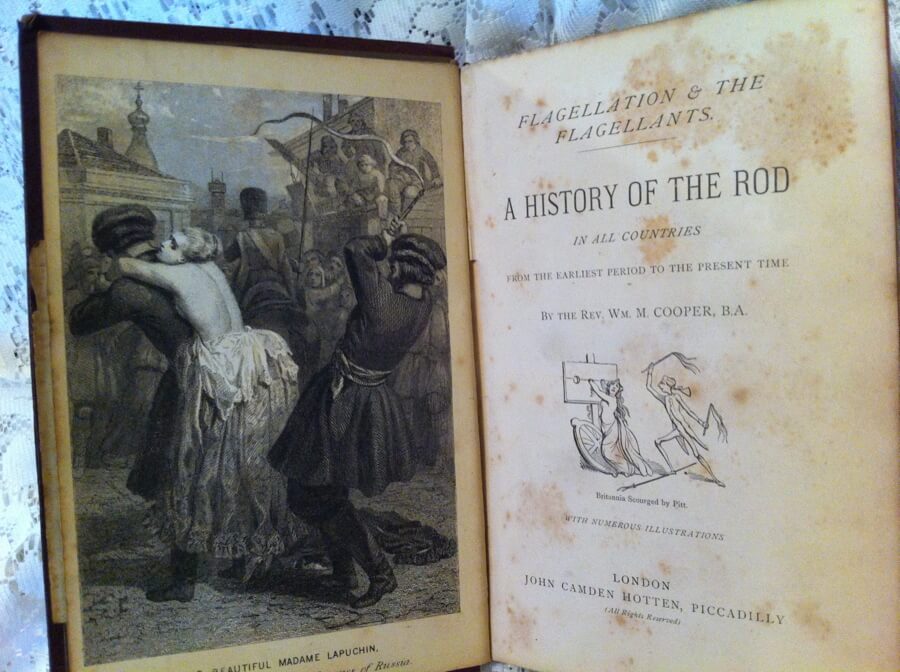
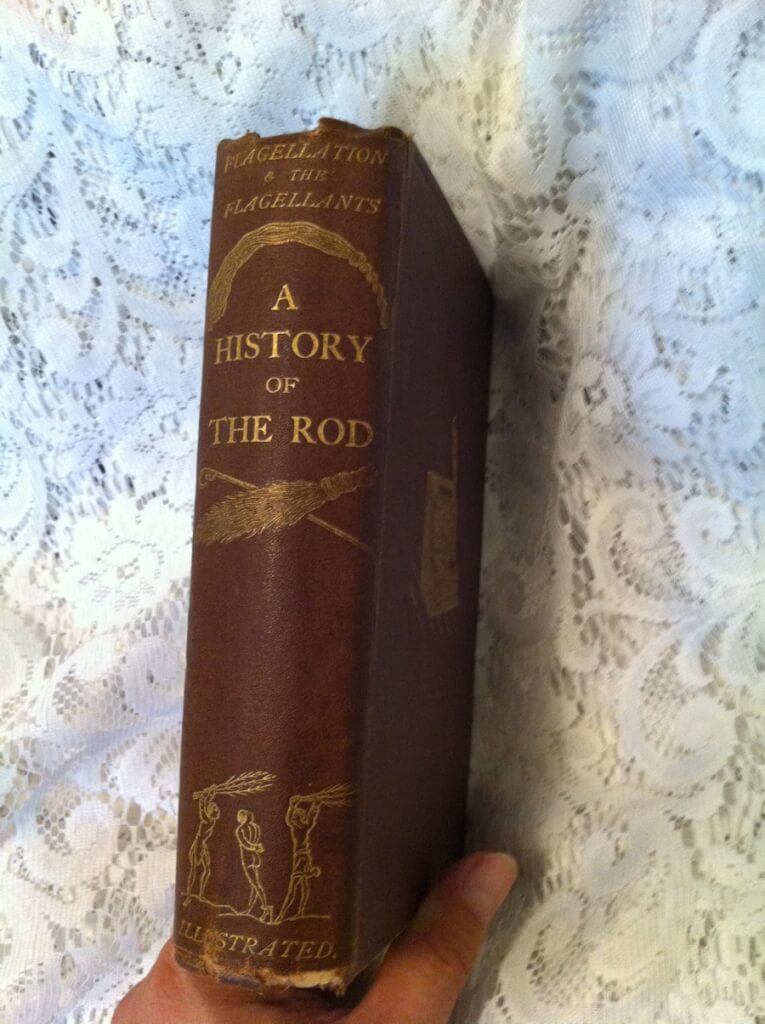 Flagellation & the Flagellants. a History of the Rod in All Countries, The Rev. Wm. M. Cooper, B.A. [James Glass Bertram] (John Camden Hotten, London, n.d. [1870, from ads at end of book]) 7 3/4" X 5 1/2", 544pp plus 32 pages of advertisements for "Very Important New Books", hardbound with red cloth, gilt lettering and decorations, spine worn at top and bottom and lower front, Binder's ticket on lower pastedown: "Bound by W. Bone and Son. 76 Fleet St. London E.C.", front pastdown has cute bookplate asking the book be returned to Robert Day, front end-paper has armorial bookplate of Robert Day. Good condition, corners bumped, top and bottom of spine worn, back boards loose but holding. Bertram was apprenticed to Tait's Edinburgh Magazine and became managing clerk, before joining a company of strolling players. He returned to Edinburgh and set up as a bookseller and newsagent. In 1855 he was appointed the editor of the North Briton and in 1872 of the Glasgow News, leaving to become a freelance journalist two years later. He published "flagellation" pornography under the names "Revd William Cooper" and "Margaret Anson". Illustrated throughout with a colored frontispiece. The bookplate is of Robert Day (1836_1914), an Irish antiquarian and photographer who collaborated with Franz Tieze in producing imitation Williamite, Jacobite and Irish Volunteer glassware. He was an important and well-travelled antiquarian collector. He was involved in his family's extensive saddlery business together with a sports shop well known to Cork anglers.
Flagellation & the Flagellants. a History of the Rod in All Countries, The Rev. Wm. M. Cooper, B.A. [James Glass Bertram] (John Camden Hotten, London, n.d. [1870, from ads at end of book]) 7 3/4" X 5 1/2", 544pp plus 32 pages of advertisements for "Very Important New Books", hardbound with red cloth, gilt lettering and decorations, spine worn at top and bottom and lower front, Binder's ticket on lower pastedown: "Bound by W. Bone and Son. 76 Fleet St. London E.C.", front pastdown has cute bookplate asking the book be returned to Robert Day, front end-paper has armorial bookplate of Robert Day. Good condition, corners bumped, top and bottom of spine worn, back boards loose but holding. Bertram was apprenticed to Tait's Edinburgh Magazine and became managing clerk, before joining a company of strolling players. He returned to Edinburgh and set up as a bookseller and newsagent. In 1855 he was appointed the editor of the North Briton and in 1872 of the Glasgow News, leaving to become a freelance journalist two years later. He published "flagellation" pornography under the names "Revd William Cooper" and "Margaret Anson". Illustrated throughout with a colored frontispiece. The bookplate is of Robert Day (1836_1914), an Irish antiquarian and photographer who collaborated with Franz Tieze in producing imitation Williamite, Jacobite and Irish Volunteer glassware. He was an important and well-travelled antiquarian collector. He was involved in his family's extensive saddlery business together with a sports shop well known to Cork anglers. -
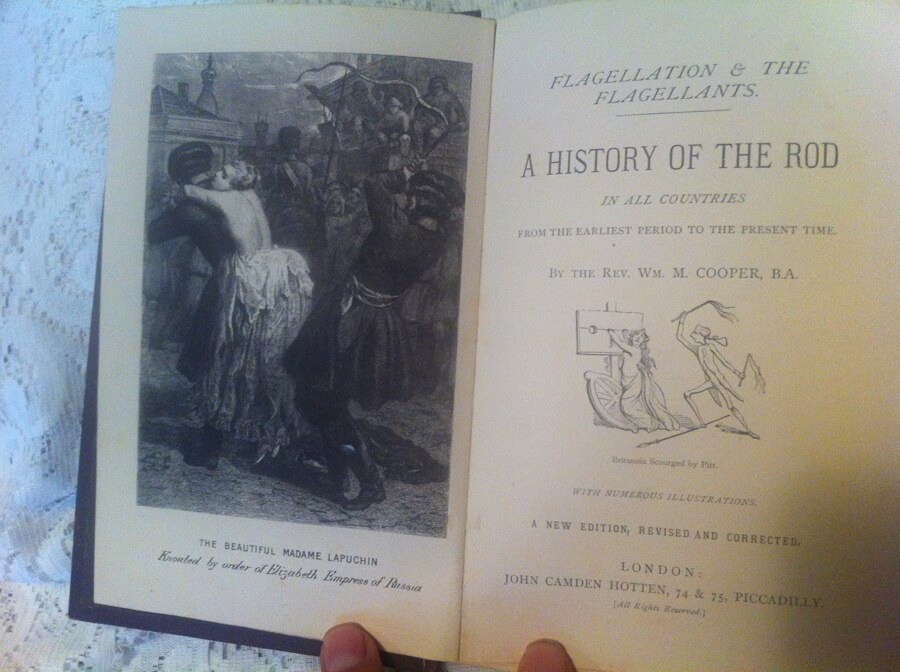
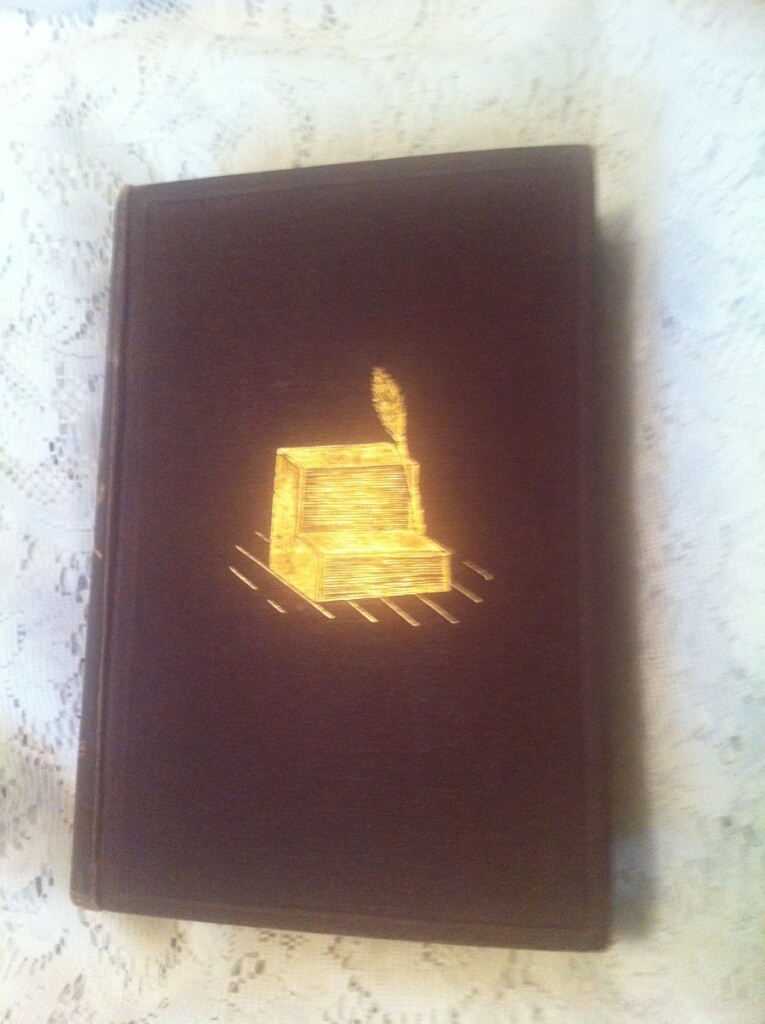 Flagellation & the Flagellants. a History of the Rod in All Countries, The Rev. Wm. M. Cooper, B.A. [James Glass Bertram] (John Camden Hotten, London, n.d. [1873, from ads at end of book] "a new edition revised and corrected") 7 3/4" X 5 1/2", 544pp plus 32 pages of advertisements for "Very Important New Books", hardbound with red cloth, gilt lettering and decorations, spine worn at top and bottom and lower front, Very Good condition, corners bumped, top and bottom of spine worn, boards slightly loose. Ex libris: "From the library of Walter Wentworth Allerton" Bertram was apprenticed to Tait's Edinburgh Magazine and became managing clerk, before joining a company of strolling players. He returned to Edinburgh and set up as a bookseller and newsagent. In 1855 he was appointed the editor of the North Briton and in 1872 of the Glasgow News, leaving to become a freelance journalist two years later. He published "flagellation" pornography under the names "Revd William Cooper" and "Margaret Anson". Illustrated throughout. This is a later "newly revised edition" from Hotten and the version used for the Reeves edition.
Flagellation & the Flagellants. a History of the Rod in All Countries, The Rev. Wm. M. Cooper, B.A. [James Glass Bertram] (John Camden Hotten, London, n.d. [1873, from ads at end of book] "a new edition revised and corrected") 7 3/4" X 5 1/2", 544pp plus 32 pages of advertisements for "Very Important New Books", hardbound with red cloth, gilt lettering and decorations, spine worn at top and bottom and lower front, Very Good condition, corners bumped, top and bottom of spine worn, boards slightly loose. Ex libris: "From the library of Walter Wentworth Allerton" Bertram was apprenticed to Tait's Edinburgh Magazine and became managing clerk, before joining a company of strolling players. He returned to Edinburgh and set up as a bookseller and newsagent. In 1855 he was appointed the editor of the North Briton and in 1872 of the Glasgow News, leaving to become a freelance journalist two years later. He published "flagellation" pornography under the names "Revd William Cooper" and "Margaret Anson". Illustrated throughout. This is a later "newly revised edition" from Hotten and the version used for the Reeves edition. -
Out of stock
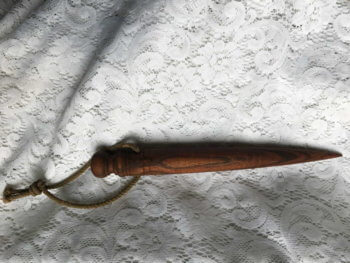
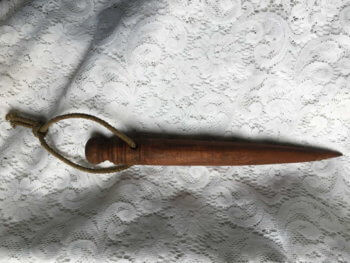 Fid from India 13.5" long, 1.5" at widest part, unknown wood, with original rope A fid is a conical tool made of wood or bone. It is used to work with rope and canvas in seamanship. A fid is used to hold open knots and holes in canvas or to open the "lays", or strands of rope, for splicing.
Fid from India 13.5" long, 1.5" at widest part, unknown wood, with original rope A fid is a conical tool made of wood or bone. It is used to work with rope and canvas in seamanship. A fid is used to hold open knots and holes in canvas or to open the "lays", or strands of rope, for splicing. -
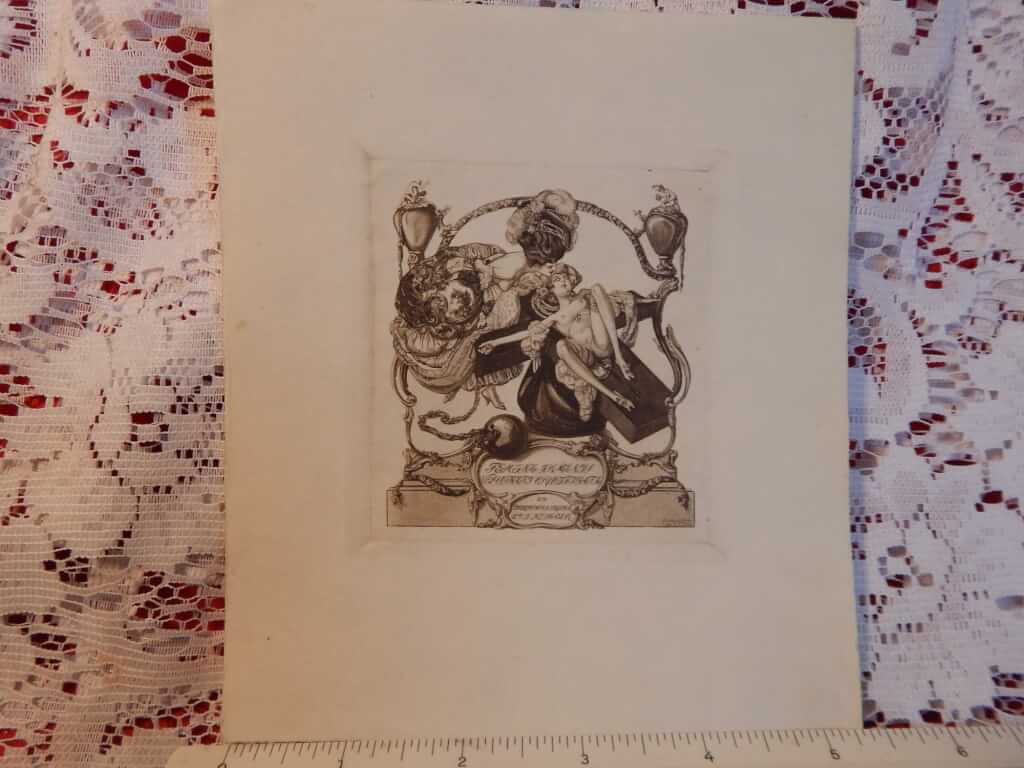 Femina Hominis Voluptati Crucifigata, Ex Bibliotheca Erotica Dr. J. Klueber, by Franz von Bayros paper size 5.5 x 6.25", print size 3.5 x 3.5" Topless handcuffed woman consoling naked girl nailed to cross. "Femina Hominis Voluptati Crucifigata" is possibly latin for "the woman is man's pleasure crucified"? The detail in this print is magnifying-glass-worthy as there are copulating couples at the top of the columns. Franz von Bayros (1866 – 1924) was an Austrian commercial artist, illustrator, and painter, now he is best known for his erotic work. He belonged to the Decadent movement in art, often utilizing erotic themes and phantasmagoric imagery. At the age 17, Bayros passed the entrance exam for the Vienna Academy with Eduard von Engerth. Bayros mixed in elegant society and soon belonged to the circle of friends of Johann Straub, whose step daughter Alice he married on 1896. The next year, Bayros moved to Munich. In 1904, Bayros gave his first exhibition in Munich, which was a great success. From 1904 until 1908, Bayros traveled to Paris and Italy for his studies. Typically, for an artist dealing with such imagery, von Bayros produced work under several pseudonyms, most notably Choisy Le Conin, and was hounded by authorities for much of his life for his “indecent” art often very imaginative, and including such taboo subjects as sadomasochism and bestiality. He became equally well-known for his masterly drawn figures of elegant modestly nude and non-nude women.
Femina Hominis Voluptati Crucifigata, Ex Bibliotheca Erotica Dr. J. Klueber, by Franz von Bayros paper size 5.5 x 6.25", print size 3.5 x 3.5" Topless handcuffed woman consoling naked girl nailed to cross. "Femina Hominis Voluptati Crucifigata" is possibly latin for "the woman is man's pleasure crucified"? The detail in this print is magnifying-glass-worthy as there are copulating couples at the top of the columns. Franz von Bayros (1866 – 1924) was an Austrian commercial artist, illustrator, and painter, now he is best known for his erotic work. He belonged to the Decadent movement in art, often utilizing erotic themes and phantasmagoric imagery. At the age 17, Bayros passed the entrance exam for the Vienna Academy with Eduard von Engerth. Bayros mixed in elegant society and soon belonged to the circle of friends of Johann Straub, whose step daughter Alice he married on 1896. The next year, Bayros moved to Munich. In 1904, Bayros gave his first exhibition in Munich, which was a great success. From 1904 until 1908, Bayros traveled to Paris and Italy for his studies. Typically, for an artist dealing with such imagery, von Bayros produced work under several pseudonyms, most notably Choisy Le Conin, and was hounded by authorities for much of his life for his “indecent” art often very imaginative, and including such taboo subjects as sadomasochism and bestiality. He became equally well-known for his masterly drawn figures of elegant modestly nude and non-nude women. -
 Female Masturbation, New Illustrated Edition, G. Lombard Kelly, M.D. (Banner Books, Inglewood, Calif., 1966) 8.75" X 5.25", 192pp, softcover, good+ condition "A complete reprinting of Dr. Kelly's monograph on the subject of female auto-eroticism, as well as articles on the same subject by other well-known doctors including Edwin Hirsch, Bernhard Bauer, A. von Schrench-Notzing, J. Richardson Parke and Albert Moll."
Female Masturbation, New Illustrated Edition, G. Lombard Kelly, M.D. (Banner Books, Inglewood, Calif., 1966) 8.75" X 5.25", 192pp, softcover, good+ condition "A complete reprinting of Dr. Kelly's monograph on the subject of female auto-eroticism, as well as articles on the same subject by other well-known doctors including Edwin Hirsch, Bernhard Bauer, A. von Schrench-Notzing, J. Richardson Parke and Albert Moll." -
 Fanny Hill's Cook Book, Lionel H. Braun & William Adams, illustrations by Brian Forbes (Taplinger Publishing Co., Inc., New York, 1971 [first edition]) 9 3/8" X 6 1/8", 137pp, hardbound with DJ, good condition, binding tight, some soiling to front boards, few tears in dust jacket Rare and raunchy 70's cookbook. Highlights include "Whores d'oeuvres and snacks" featuring "Dildoughs with Warts in Hot Lips", "Pickled Peckers" and Marquise d'Salade with Crafty Ebbing Undressing". In the "Meat Dishes" section there is "Suc d'Meat", "Rump Roast or Backside Entree", and "Fellatio Mignon". There is a whole section "On Stuffing." The pasta section features "Cunnilinguini with Pietro's Tongue" and the dessert features among others "Jock's Strap", "The Nutcracker Sweet" and "Virgin's pushups with a few bawdy stories thrown in between the recipes. The illustrations are very fun. Very 70's. A good copy of a rare book.
Fanny Hill's Cook Book, Lionel H. Braun & William Adams, illustrations by Brian Forbes (Taplinger Publishing Co., Inc., New York, 1971 [first edition]) 9 3/8" X 6 1/8", 137pp, hardbound with DJ, good condition, binding tight, some soiling to front boards, few tears in dust jacket Rare and raunchy 70's cookbook. Highlights include "Whores d'oeuvres and snacks" featuring "Dildoughs with Warts in Hot Lips", "Pickled Peckers" and Marquise d'Salade with Crafty Ebbing Undressing". In the "Meat Dishes" section there is "Suc d'Meat", "Rump Roast or Backside Entree", and "Fellatio Mignon". There is a whole section "On Stuffing." The pasta section features "Cunnilinguini with Pietro's Tongue" and the dessert features among others "Jock's Strap", "The Nutcracker Sweet" and "Virgin's pushups with a few bawdy stories thrown in between the recipes. The illustrations are very fun. Very 70's. A good copy of a rare book. -
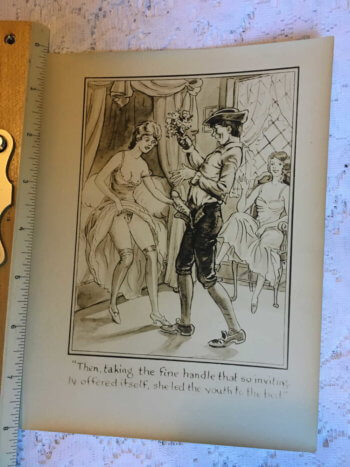
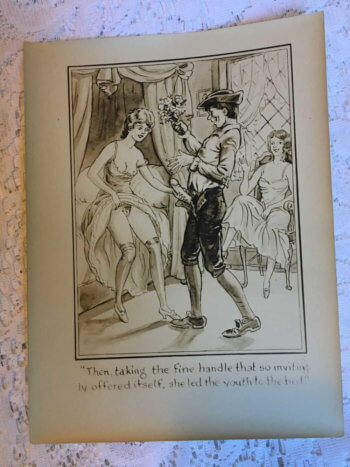 Fanny Hill print "Then, taking the fine handle that so invitingly offered itself, she led the youth to the bed." 6 x 8" This print came from someone's private collection. The rest of the prints I have from this estate are also from various editions of Fanny Hill by John Cleland. I'm unsure of the edition but this seems to be a print from the 1920-30s.
Fanny Hill print "Then, taking the fine handle that so invitingly offered itself, she led the youth to the bed." 6 x 8" This print came from someone's private collection. The rest of the prints I have from this estate are also from various editions of Fanny Hill by John Cleland. I'm unsure of the edition but this seems to be a print from the 1920-30s. -
Out of stock
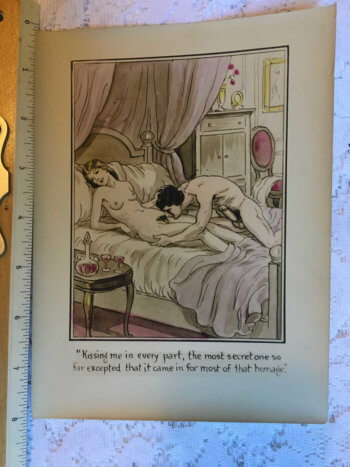
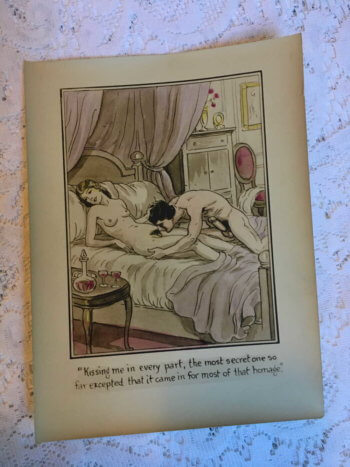 Fanny Hill print "Kissing me in every part, the most secret one so far excepted that it came in for most of that homage." 6 x 8", hand colored This print came from someone's private collection. The rest of the prints I have from this estate are also from various editions of Fanny Hill by John Cleland. I'm unsure of the edition but this seems to be a print from the 1920-30s and hand colored.
Fanny Hill print "Kissing me in every part, the most secret one so far excepted that it came in for most of that homage." 6 x 8", hand colored This print came from someone's private collection. The rest of the prints I have from this estate are also from various editions of Fanny Hill by John Cleland. I'm unsure of the edition but this seems to be a print from the 1920-30s and hand colored. -
Out of stock
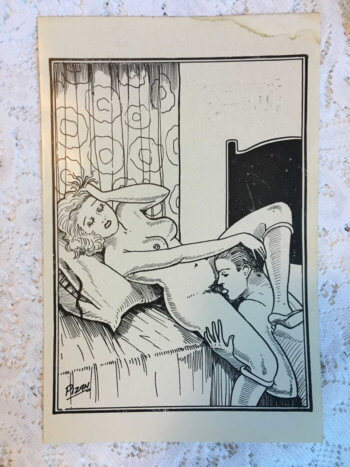
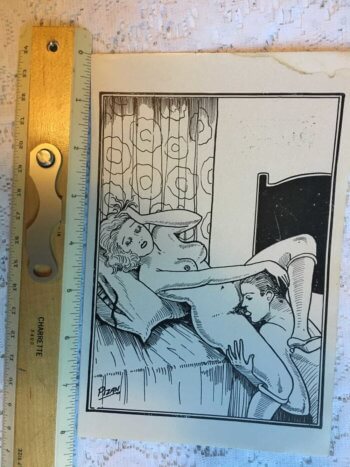 Fanny Hill print 5.5 x 8.25" This print came from someone's private collection. The rest of the prints I have from this estate are also from various editions of Fanny Hill by John Cleland. Print is by "PIZAN" and is possibly from a 20-30s edition printed clandestinely in NY.
Fanny Hill print 5.5 x 8.25" This print came from someone's private collection. The rest of the prints I have from this estate are also from various editions of Fanny Hill by John Cleland. Print is by "PIZAN" and is possibly from a 20-30s edition printed clandestinely in NY. -
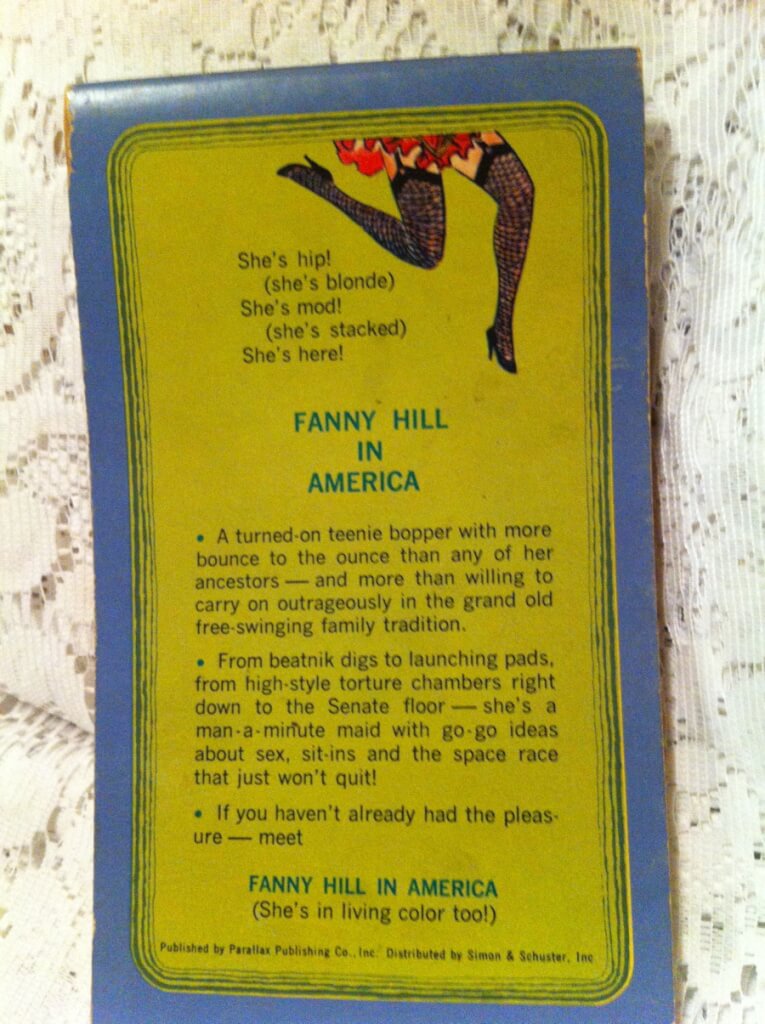
 Fanny Hill in America, by Frank Fosdick and David Sierra, cover by Jerry Schiano (Parallax Publishing Company, Inc, New York, Distributed by Simon & Schuster, Inc.) 7" x 4.25", soft cover comic book, cover scuffed and slightly soiled Stated "The first Go-Go Comic Novel in Full Color". As far as I can find it is the ONLY "Go-Go" Comic Novel. The Man from M.O.T.H.E.R. was also published in similar form saying "A Super-Cool Comic Novel in Full Color". Parallax is also hard to track down. I've only found mention of a few other comic books. all published in 1966 (The Great Society Comic Book[a parody of LBJ's social policies], it's companion comic, Bobman and Teddy [parodying Robert and Ted Kennedy], and the VERY rare Kosher Comics [featuring The Lone Arranger, Supermax, Tishman of the Apes, & Dick Shamus]). I can't find this publication listed at all. Other Parallax publications are similarly very rare.
Fanny Hill in America, by Frank Fosdick and David Sierra, cover by Jerry Schiano (Parallax Publishing Company, Inc, New York, Distributed by Simon & Schuster, Inc.) 7" x 4.25", soft cover comic book, cover scuffed and slightly soiled Stated "The first Go-Go Comic Novel in Full Color". As far as I can find it is the ONLY "Go-Go" Comic Novel. The Man from M.O.T.H.E.R. was also published in similar form saying "A Super-Cool Comic Novel in Full Color". Parallax is also hard to track down. I've only found mention of a few other comic books. all published in 1966 (The Great Society Comic Book[a parody of LBJ's social policies], it's companion comic, Bobman and Teddy [parodying Robert and Ted Kennedy], and the VERY rare Kosher Comics [featuring The Lone Arranger, Supermax, Tishman of the Apes, & Dick Shamus]). I can't find this publication listed at all. Other Parallax publications are similarly very rare. -
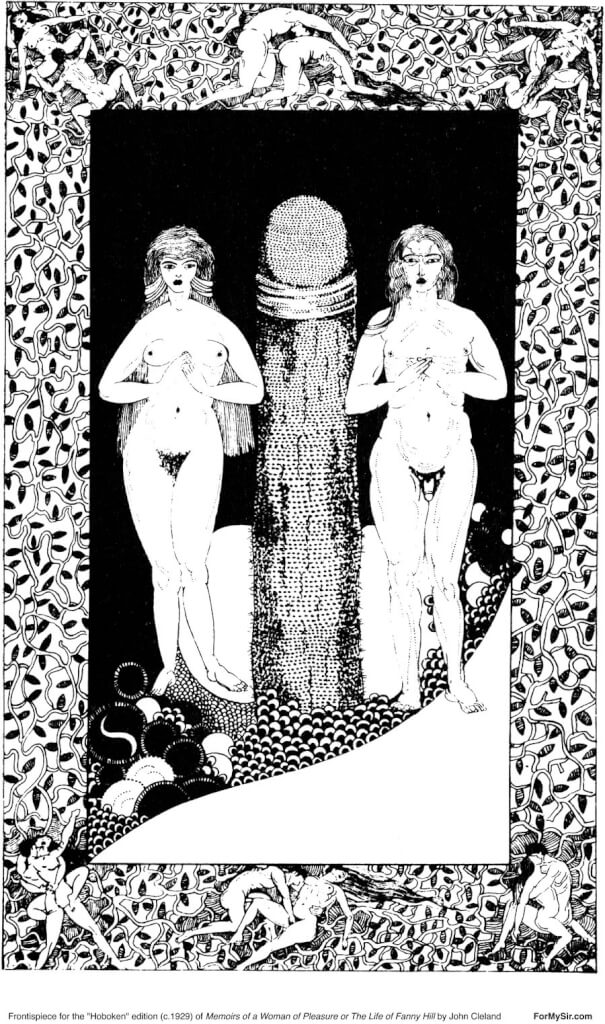 Fanny Hill (Hoboken frontispiece), artist unknown Printed from: Memoirs of a Woman of Pleasure or The Life of Fanny Hill John Cleland (Hoboken, np, 1929 [Philadelphia?] limited edition 700 (unnumbered)) Image: 6″ x 10″, high-resolution ink-jet print Paper: 8.5″ x 11″, your choice of 65lb White or 67lb Ivory Parchment
Fanny Hill (Hoboken frontispiece), artist unknown Printed from: Memoirs of a Woman of Pleasure or The Life of Fanny Hill John Cleland (Hoboken, np, 1929 [Philadelphia?] limited edition 700 (unnumbered)) Image: 6″ x 10″, high-resolution ink-jet print Paper: 8.5″ x 11″, your choice of 65lb White or 67lb Ivory Parchment -
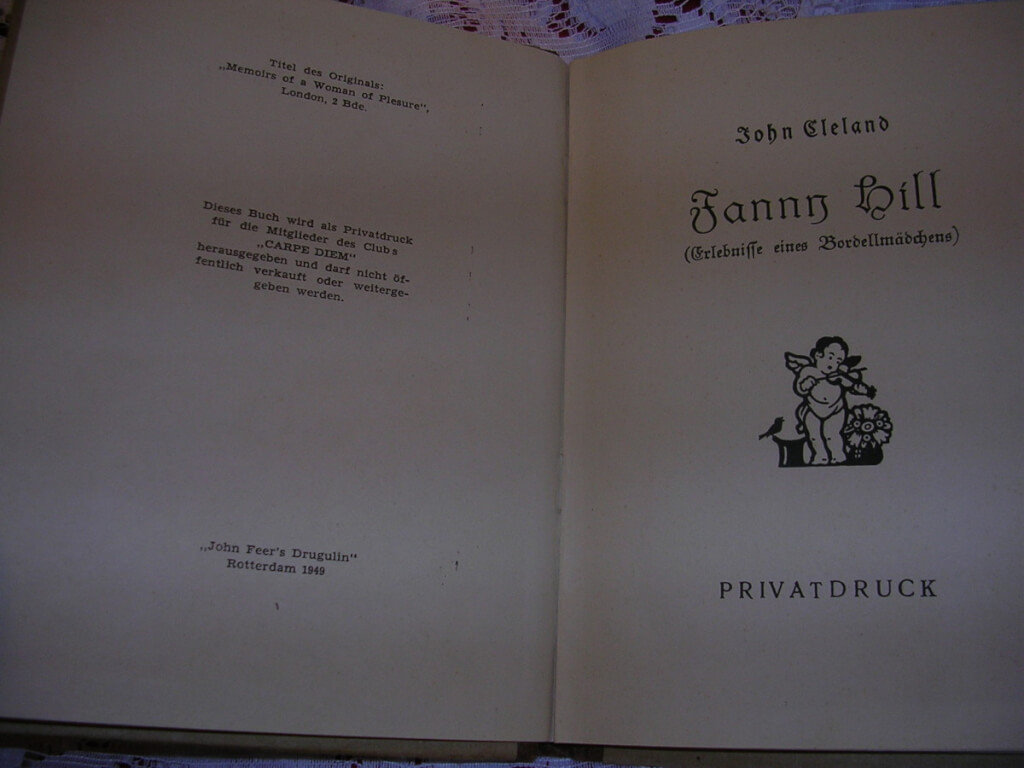
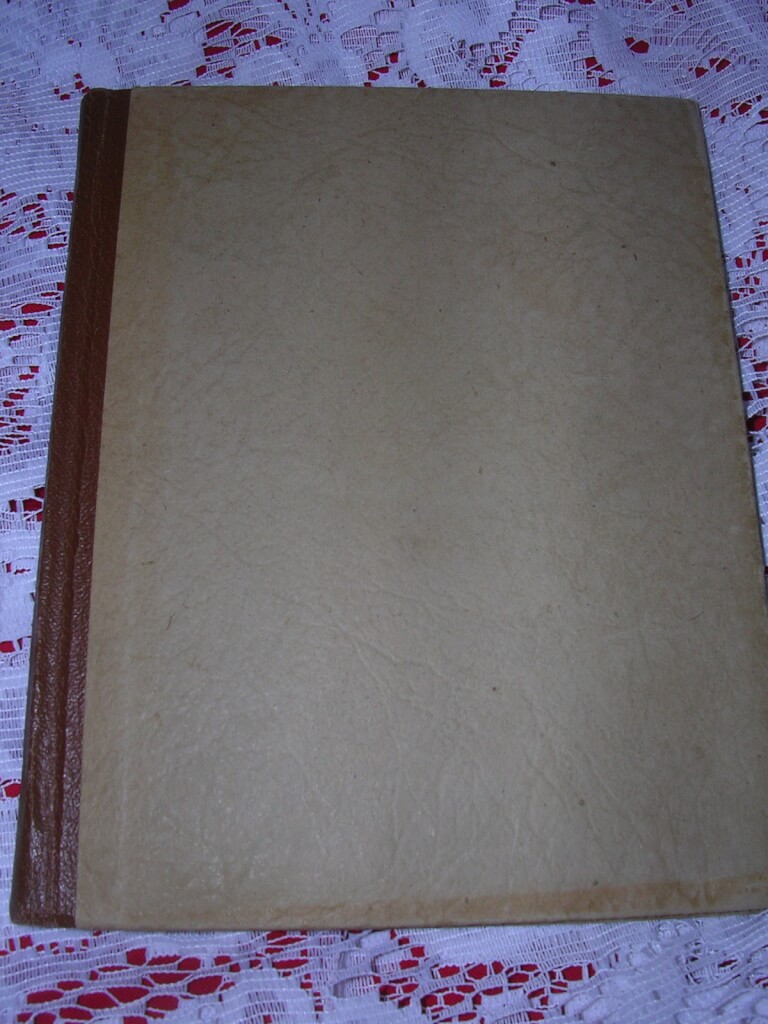 Fanny Hill (Erlebnisse eines Bordellmädchens.), John Cleland (Dieses Buch wird als Privatdruck für die Mitglieder des Clubs 'Carpe Diem' herausgegeben und darf nicht öffentlich verkauft oder weitergegeben werden. John Freer's Druglin, Rotterdam, 1949) 6.5" x 5.25", 78pp, hardbound tan paper over boards, faux leather spine. Good condition, slight foxing around edges of front cover. "This book is privately printed, published for the members of the 'Carpe Diem' club and must not be passed on or sold to the public." This was German "Bückware" or an item that was kept under the counter only for customers who asked for it. The book is labeled "Erstes Buch" (First Book). It is unknown whether this is a complete book. With only 79 pages, it might be a loosely translated edition or just the first volume. I have not found any similar books labeled anything but "Erste Buch"
Fanny Hill (Erlebnisse eines Bordellmädchens.), John Cleland (Dieses Buch wird als Privatdruck für die Mitglieder des Clubs 'Carpe Diem' herausgegeben und darf nicht öffentlich verkauft oder weitergegeben werden. John Freer's Druglin, Rotterdam, 1949) 6.5" x 5.25", 78pp, hardbound tan paper over boards, faux leather spine. Good condition, slight foxing around edges of front cover. "This book is privately printed, published for the members of the 'Carpe Diem' club and must not be passed on or sold to the public." This was German "Bückware" or an item that was kept under the counter only for customers who asked for it. The book is labeled "Erstes Buch" (First Book). It is unknown whether this is a complete book. With only 79 pages, it might be a loosely translated edition or just the first volume. I have not found any similar books labeled anything but "Erste Buch" -
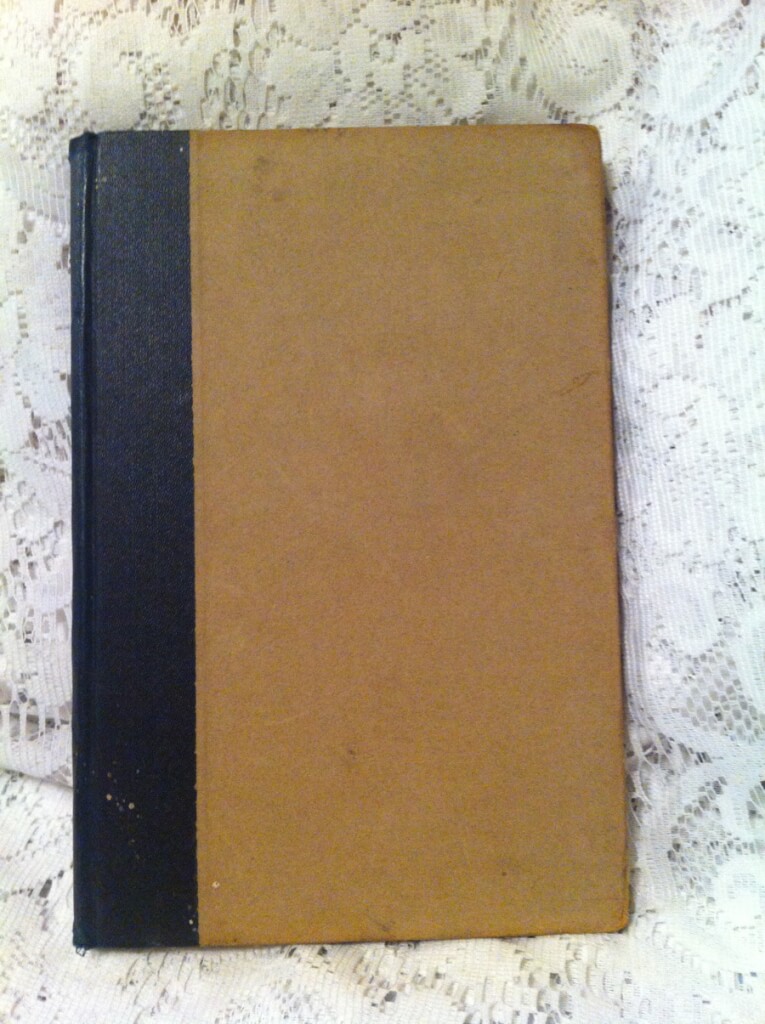
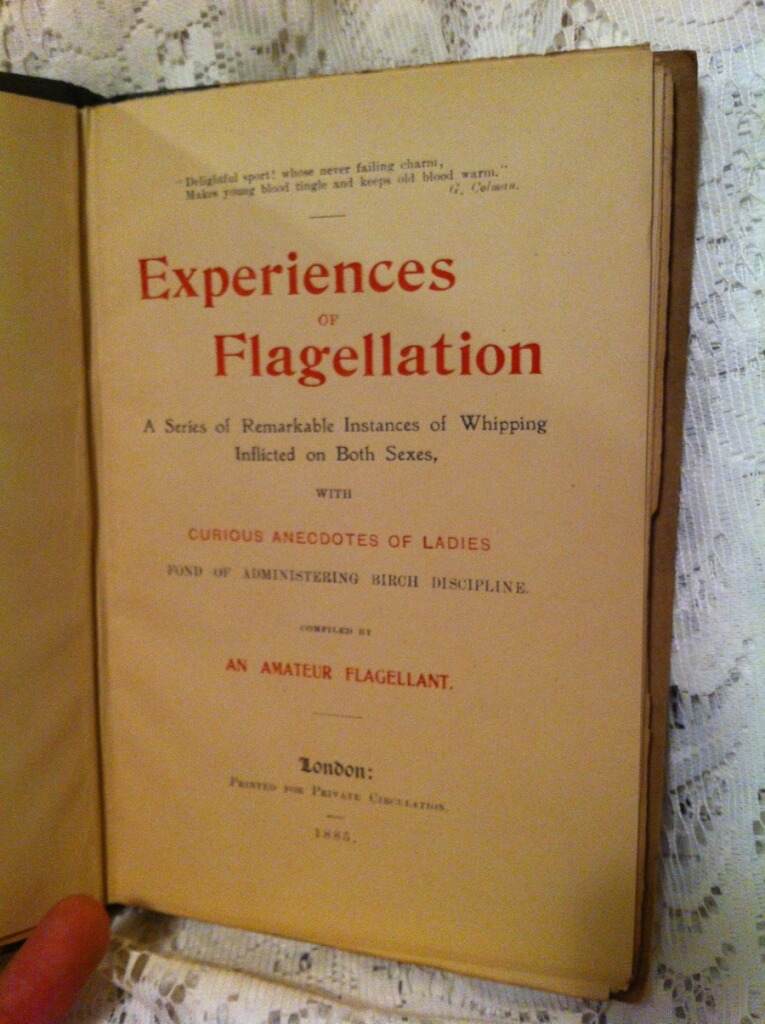 Experiences of Flagellation: A Series of Remarkable Instances of Whipping Inflicted on Both Sexes, With Curious Anecdotes of Ladies Fond of Administering Birch Discipline., "compiled by An Amateur Flagallant" (Printed for Private Circulation, London, 1885, first edition) 5.25"x 8", 80pp, hardbound no DJ, tan boards with blue spine, fair condition for age, some bumping to boards, binding fragile but holding, split between first and second signature, page 15/16 detached. A great read! Forward asserts God ordained pain and punishment, even animals fear it, it is his police department, not to punish is to keep a boy out of God's school. The rod should be used ceremoniously. Even girls up to 18 have often ben greatly improved for life by "Dr. Spankster's" cure wisely administered. Sections include: Flogging Girls, Wife Beating, A Conjugal Scene, Lady Preparing for Birching, and many more.
Experiences of Flagellation: A Series of Remarkable Instances of Whipping Inflicted on Both Sexes, With Curious Anecdotes of Ladies Fond of Administering Birch Discipline., "compiled by An Amateur Flagallant" (Printed for Private Circulation, London, 1885, first edition) 5.25"x 8", 80pp, hardbound no DJ, tan boards with blue spine, fair condition for age, some bumping to boards, binding fragile but holding, split between first and second signature, page 15/16 detached. A great read! Forward asserts God ordained pain and punishment, even animals fear it, it is his police department, not to punish is to keep a boy out of God's school. The rod should be used ceremoniously. Even girls up to 18 have often ben greatly improved for life by "Dr. Spankster's" cure wisely administered. Sections include: Flogging Girls, Wife Beating, A Conjugal Scene, Lady Preparing for Birching, and many more. -
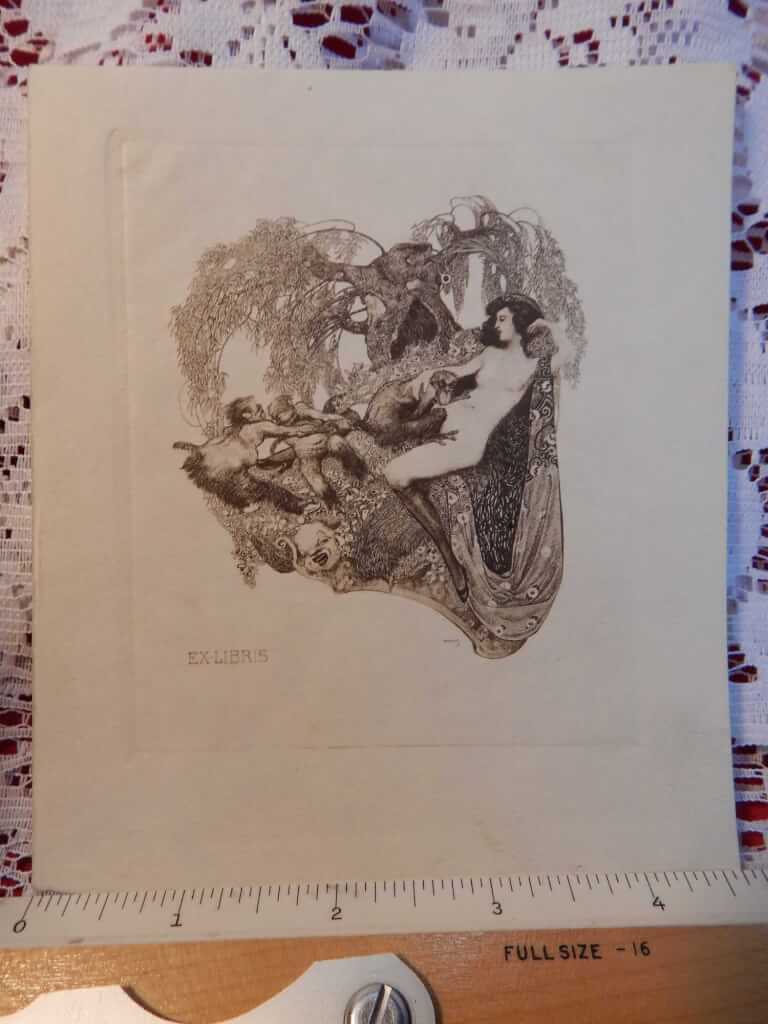 Ex Libris, by Franz von Bayros paper size 4.75 x 5.5", print size 3.5 x 4" naked woman sitting in a tree being "intimate" with monkey, other monkeys trying to pull him away from her. Very detailed and ornate. Franz von Bayros (1866 – 1924) was an Austrian commercial artist, illustrator, and painter, now he is best known for his erotic work. He belonged to the Decadent movement in art, often utilizing erotic themes and phantasmagoric imagery. At the age 17, Bayros passed the entrance exam for the Vienna Academy with Eduard von Engerth. Bayros mixed in elegant society and soon belonged to the circle of friends of Johann Straub, whose step daughter Alice he married on 1896. The next year, Bayros moved to Munich. In 1904, Bayros gave his first exhibition in Munich, which was a great success. From 1904 until 1908, Bayros traveled to Paris and Italy for his studies. Typically, for an artist dealing with such imagery, von Bayros produced work under several pseudonyms, most notably Choisy Le Conin, and was hounded by authorities for much of his life for his “indecent” art often very imaginative, and including such taboo subjects as sadomasochism and bestiality. He became equally well-known for his masterly drawn figures of elegant modestly nude and non-nude women.
Ex Libris, by Franz von Bayros paper size 4.75 x 5.5", print size 3.5 x 4" naked woman sitting in a tree being "intimate" with monkey, other monkeys trying to pull him away from her. Very detailed and ornate. Franz von Bayros (1866 – 1924) was an Austrian commercial artist, illustrator, and painter, now he is best known for his erotic work. He belonged to the Decadent movement in art, often utilizing erotic themes and phantasmagoric imagery. At the age 17, Bayros passed the entrance exam for the Vienna Academy with Eduard von Engerth. Bayros mixed in elegant society and soon belonged to the circle of friends of Johann Straub, whose step daughter Alice he married on 1896. The next year, Bayros moved to Munich. In 1904, Bayros gave his first exhibition in Munich, which was a great success. From 1904 until 1908, Bayros traveled to Paris and Italy for his studies. Typically, for an artist dealing with such imagery, von Bayros produced work under several pseudonyms, most notably Choisy Le Conin, and was hounded by authorities for much of his life for his “indecent” art often very imaginative, and including such taboo subjects as sadomasochism and bestiality. He became equally well-known for his masterly drawn figures of elegant modestly nude and non-nude women. -
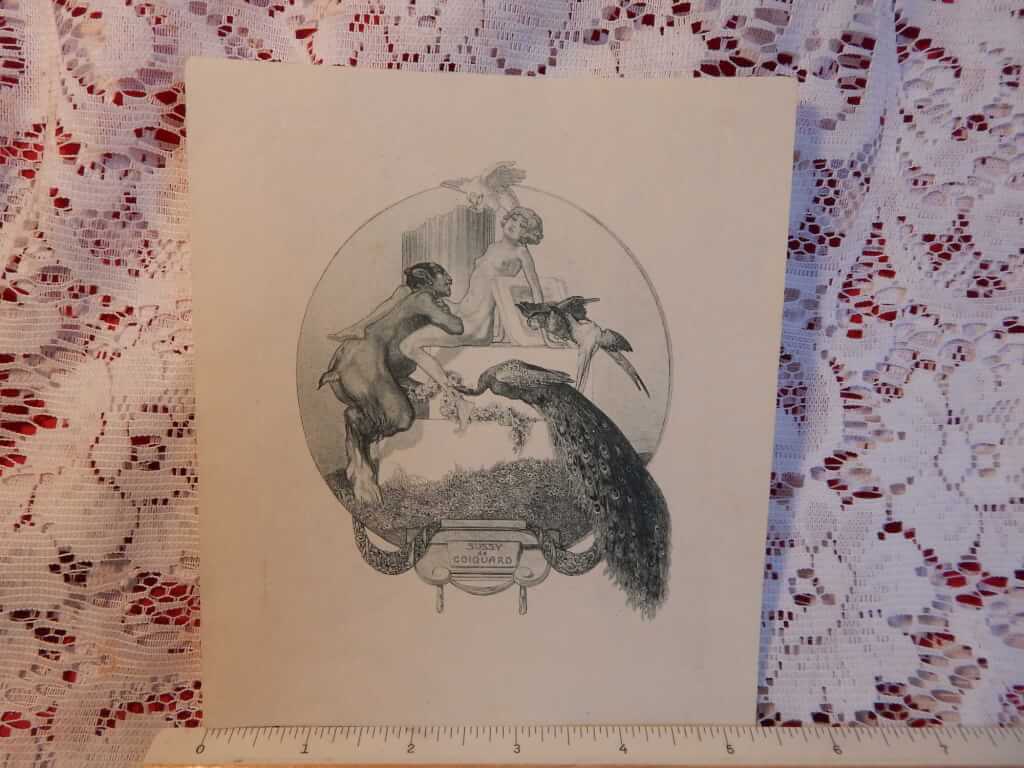 Ex libris Sussy de Coiquard, by Franz von Bayros paper size 5.5 x 6.25", print size 4.25 x 5.25" naked girl entertaining Pan(?), with peacock and other birds Franz von Bayros (1866 – 1924) was an Austrian commercial artist, illustrator, and painter, now he is best known for his erotic work. He belonged to the Decadent movement in art, often utilizing erotic themes and phantasmagoric imagery. At the age 17, Bayros passed the entrance exam for the Vienna Academy with Eduard von Engerth. Bayros mixed in elegant society and soon belonged to the circle of friends of Johann Straub, whose step daughter Alice he married on 1896. The next year, Bayros moved to Munich. In 1904, Bayros gave his first exhibition in Munich, which was a great success. From 1904 until 1908, Bayros traveled to Paris and Italy for his studies. Typically, for an artist dealing with such imagery, von Bayros produced work under several pseudonyms, most notably Choisy Le Conin, and was hounded by authorities for much of his life for his “indecent” art often very imaginative, and including such taboo subjects as sadomasochism and bestiality. He became equally well-known for his masterly drawn figures of elegant modestly nude and non-nude women.
Ex libris Sussy de Coiquard, by Franz von Bayros paper size 5.5 x 6.25", print size 4.25 x 5.25" naked girl entertaining Pan(?), with peacock and other birds Franz von Bayros (1866 – 1924) was an Austrian commercial artist, illustrator, and painter, now he is best known for his erotic work. He belonged to the Decadent movement in art, often utilizing erotic themes and phantasmagoric imagery. At the age 17, Bayros passed the entrance exam for the Vienna Academy with Eduard von Engerth. Bayros mixed in elegant society and soon belonged to the circle of friends of Johann Straub, whose step daughter Alice he married on 1896. The next year, Bayros moved to Munich. In 1904, Bayros gave his first exhibition in Munich, which was a great success. From 1904 until 1908, Bayros traveled to Paris and Italy for his studies. Typically, for an artist dealing with such imagery, von Bayros produced work under several pseudonyms, most notably Choisy Le Conin, and was hounded by authorities for much of his life for his “indecent” art often very imaginative, and including such taboo subjects as sadomasochism and bestiality. He became equally well-known for his masterly drawn figures of elegant modestly nude and non-nude women. -
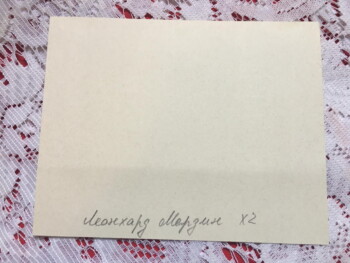
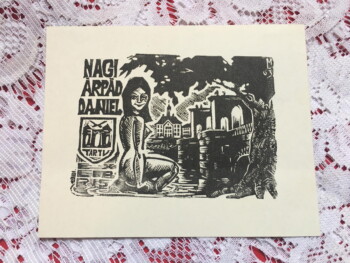 Ex Libris Nagi Arpad Daniel - Tartu 3.5 x 4.75", signed on the back, presumably by and for the Estonian artist, Arpad Daniel Nagy, Tartu is a city in Estonia nude woman sitting on rock in the water, behind her a bridge. Arpad Daniel Nagy was a creative visual artist. Arpad Daniel Nagy was born in 1922 and died in 1985. Arpad Daniel Nagy was largely inspired by the 1930s growing up. The period of the 1930s is characterised by the conflict between a number of political ideologies, including Marxist Socialism, Capitalist Democracy, and the Totalitarianism of both Communism and Fascism. Artistic output in the United States was heavily impacted at the time by the Great Depression, and a number of artists took to focusing on ideas of humility and the ordinary man. For the first time in US history, artists began to explore into political subjects and attempted to use their art to impact society. Themes such as poverty, lack of affordable housing, anti-lynching, anti-fascism, and workers' strikes were prevalent in many artists’ work. In the Soviet Union, Stalin’s government required urgent funds to implement the rapid industrialisation demanded by the first Five Year Plan. It initiated a secret plan to sell off treasures from the State Hermitage Museum in Leningrad (St. Petersburg), including a primary list of two hundred and fifty rare paintings by the Old Masters, many which found their way to the collection of Andrew Mellon via the New York based art dealing company, Knoedler. Surrealism continued to dominate in Europe, and had influence on an international scale. Artists such as Frida Kahlo and Diego Riviera in Mexico, worked to incorporate the ideas posed by Surrealism into their radical political ideologies, developing a new kind of magic realism. The decade took a ominous turn with the birth of National Socialism in Germany, followed by Adolf Hitler’s rise to power in 1933. By the end of the 1930s, the Second World War had begun; which preoccupied both artists and the global population.
Ex Libris Nagi Arpad Daniel - Tartu 3.5 x 4.75", signed on the back, presumably by and for the Estonian artist, Arpad Daniel Nagy, Tartu is a city in Estonia nude woman sitting on rock in the water, behind her a bridge. Arpad Daniel Nagy was a creative visual artist. Arpad Daniel Nagy was born in 1922 and died in 1985. Arpad Daniel Nagy was largely inspired by the 1930s growing up. The period of the 1930s is characterised by the conflict between a number of political ideologies, including Marxist Socialism, Capitalist Democracy, and the Totalitarianism of both Communism and Fascism. Artistic output in the United States was heavily impacted at the time by the Great Depression, and a number of artists took to focusing on ideas of humility and the ordinary man. For the first time in US history, artists began to explore into political subjects and attempted to use their art to impact society. Themes such as poverty, lack of affordable housing, anti-lynching, anti-fascism, and workers' strikes were prevalent in many artists’ work. In the Soviet Union, Stalin’s government required urgent funds to implement the rapid industrialisation demanded by the first Five Year Plan. It initiated a secret plan to sell off treasures from the State Hermitage Museum in Leningrad (St. Petersburg), including a primary list of two hundred and fifty rare paintings by the Old Masters, many which found their way to the collection of Andrew Mellon via the New York based art dealing company, Knoedler. Surrealism continued to dominate in Europe, and had influence on an international scale. Artists such as Frida Kahlo and Diego Riviera in Mexico, worked to incorporate the ideas posed by Surrealism into their radical political ideologies, developing a new kind of magic realism. The decade took a ominous turn with the birth of National Socialism in Germany, followed by Adolf Hitler’s rise to power in 1933. By the end of the 1930s, the Second World War had begun; which preoccupied both artists and the global population. -
Out of stock
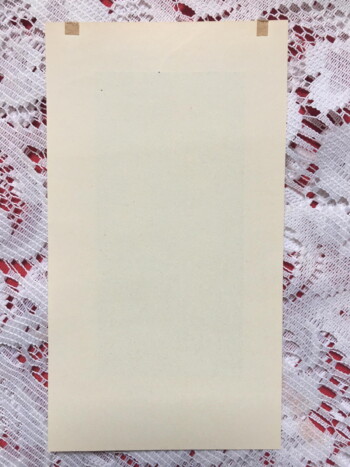
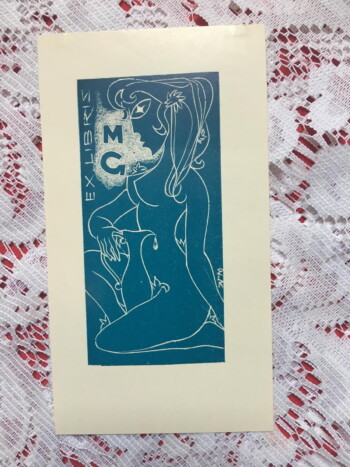 Ex Libris MG 2.75 x 5", unknown origin naked women with pitcher
Ex Libris MG 2.75 x 5", unknown origin naked women with pitcher -
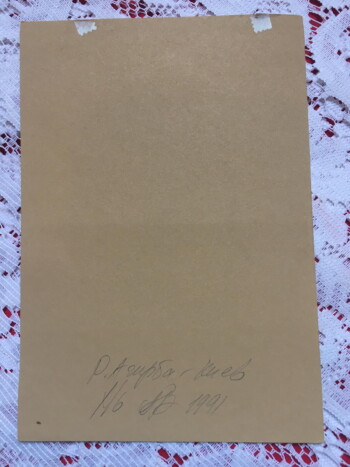
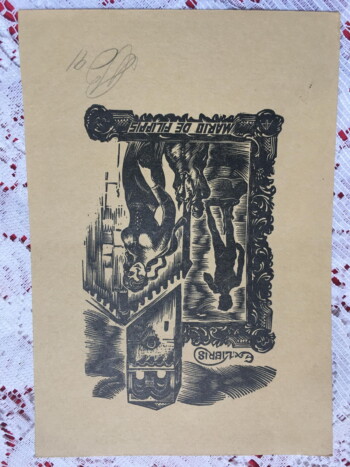 Ex Libris Mario de Filippis (signed) 5 x 4", signed on the front and back in pencil, presumably by artist Woman, man on horseback in front of Italian architecture and a silhouette of Michelangelo's David One of the most important (and largest) collections of ex libris in the world belongs to Mario De Filippis, the owner of Buca di San Francesco restaurant in Arezzo Italy. He has over 130,000 ex libris in his collection, approximately 13,000 are personal ex libris plates he's commissioned from artists all over the world using a multitude of printing techniques. His website describes Mario as "a passionate lover of small graphics".
Ex Libris Mario de Filippis (signed) 5 x 4", signed on the front and back in pencil, presumably by artist Woman, man on horseback in front of Italian architecture and a silhouette of Michelangelo's David One of the most important (and largest) collections of ex libris in the world belongs to Mario De Filippis, the owner of Buca di San Francesco restaurant in Arezzo Italy. He has over 130,000 ex libris in his collection, approximately 13,000 are personal ex libris plates he's commissioned from artists all over the world using a multitude of printing techniques. His website describes Mario as "a passionate lover of small graphics". -

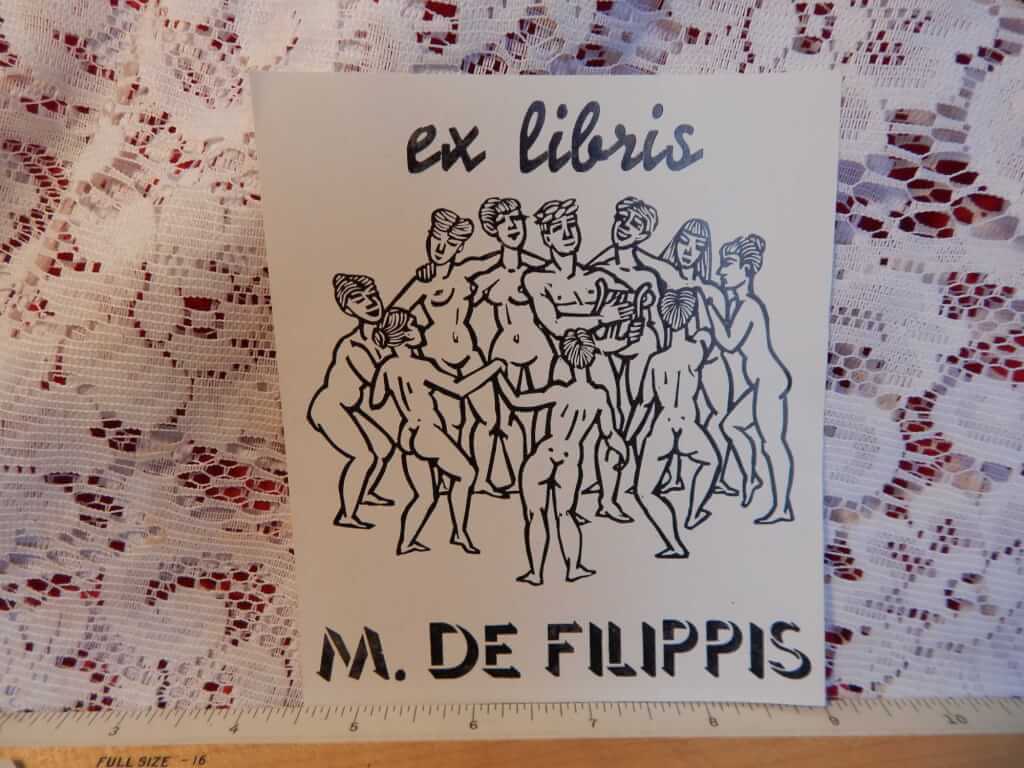 Ex Libris M. De Filippis by Constante Constantini 4.5 x 5.25", purchased from a collection in Italy, "Constantini, Italia, x/3, 1987" stamped on back Naked man playing a harp while naked dancers encircle him. One of the most important (and largest) collections of ex libris in the world belongs to Mario De Filippis, the owner of Buca di San Francesco restaurant in Arezzo Italy. He has over 130,000 ex libris in his collection, approximately 13,000 are personal ex libris plates he's commissioned from artists all over the world using a multitude of printing techniques. His website describes Mario as "a passionate lover of small graphics".
Ex Libris M. De Filippis by Constante Constantini 4.5 x 5.25", purchased from a collection in Italy, "Constantini, Italia, x/3, 1987" stamped on back Naked man playing a harp while naked dancers encircle him. One of the most important (and largest) collections of ex libris in the world belongs to Mario De Filippis, the owner of Buca di San Francesco restaurant in Arezzo Italy. He has over 130,000 ex libris in his collection, approximately 13,000 are personal ex libris plates he's commissioned from artists all over the world using a multitude of printing techniques. His website describes Mario as "a passionate lover of small graphics". -

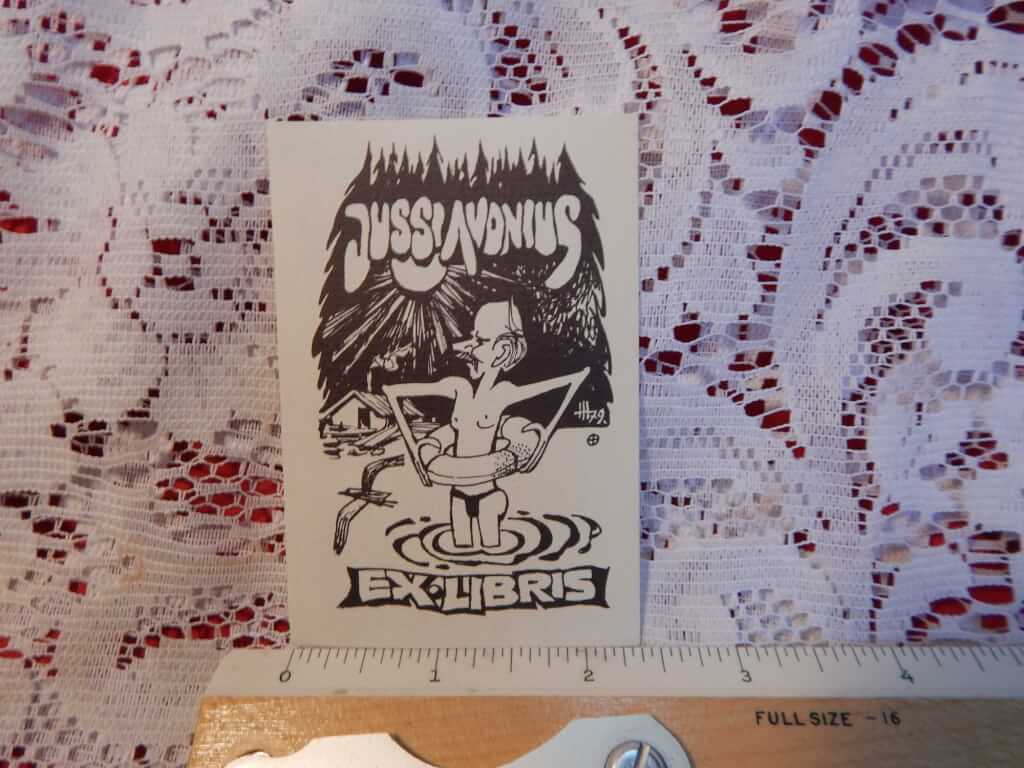 Ex Libris Jussi Avonius, by Hugo Hiibus purchased from a collection in Italy, "Hugo Hiibus | estonia" written on back in pencil Humourous man in knee deep water wearing an lifebuoy/life preserver. Hugo Hiibus (born in 1929) is a popular Estonian cartoonist and personality. He studied at the Estonian State Institute of the Arts, graduating in graphic art. From 1955-1957 he worked in the newspaper People's Voice, and in 1957-1959 in the journal Pikker as an artistic editor. In the years 1972-1984 he worked in the editorial office of the Kodumaa newspaper. He was a member of the ENSV Art Foundation (1961). His first cartoon appeared at the Institute in 1950. Hiibus has been an active exlibris and poster artist and a bookmaker. The cartoons of Hugo Hiibus have been published in almost all editions published in Estonia. Hiibas is both a member of the Estonian Artists' Union (1960) and a Journalist Association (1958). He is also a member of the Board of the Estonian Humor Union.
Ex Libris Jussi Avonius, by Hugo Hiibus purchased from a collection in Italy, "Hugo Hiibus | estonia" written on back in pencil Humourous man in knee deep water wearing an lifebuoy/life preserver. Hugo Hiibus (born in 1929) is a popular Estonian cartoonist and personality. He studied at the Estonian State Institute of the Arts, graduating in graphic art. From 1955-1957 he worked in the newspaper People's Voice, and in 1957-1959 in the journal Pikker as an artistic editor. In the years 1972-1984 he worked in the editorial office of the Kodumaa newspaper. He was a member of the ENSV Art Foundation (1961). His first cartoon appeared at the Institute in 1950. Hiibus has been an active exlibris and poster artist and a bookmaker. The cartoons of Hugo Hiibus have been published in almost all editions published in Estonia. Hiibas is both a member of the Estonian Artists' Union (1960) and a Journalist Association (1958). He is also a member of the Board of the Estonian Humor Union. -
Out of stock

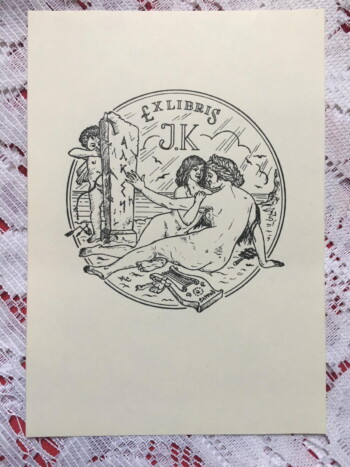 Ex Libris J.K 3.5 x 5", unknown origin, purchased from a collection in Italy naked women, a lyre labeled "Sappho", cupid behind pillar. Artist name written on back in pencil ("cangoo"?).
Ex Libris J.K 3.5 x 5", unknown origin, purchased from a collection in Italy naked women, a lyre labeled "Sappho", cupid behind pillar. Artist name written on back in pencil ("cangoo"?). -
Out of stock
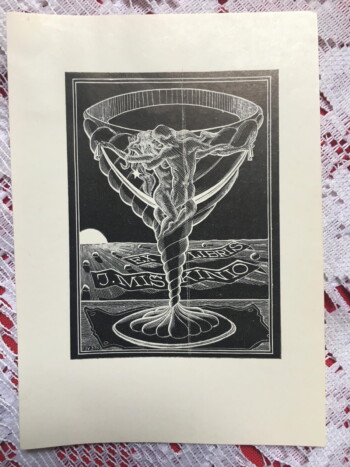 Ex libris J. Mikino 3 x 4", black ink on paper two lovers intertwined as a wine glass
Ex libris J. Mikino 3 x 4", black ink on paper two lovers intertwined as a wine glass -
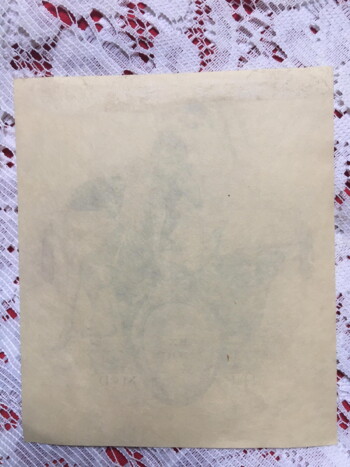
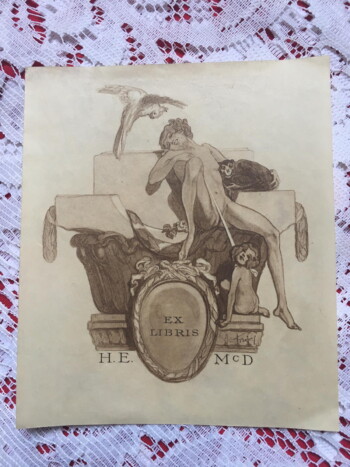 Ex Libris H.E. McD, by Franz von Bayros 4 x 4.5" brown/black ink, previously pasted as evident by top part of back naked girl, animals, and child, presumably Ex libris for Horace E. McDonald Franz von Bayros (1866 – 1924) was an Austrian commercial artist, illustrator, and painter, now he is best known for his erotic work. He belonged to the Decadent movement in art, often utilizing erotic themes and phantasmagoric imagery. At the age 17, Bayros passed the entrance exam for the Vienna Academy with Eduard von Engerth. Bayros mixed in elegant society and soon belonged to the circle of friends of Johann Straub, whose step daughter Alice he married on 1896. The next year, Bayros moved to Munich. In 1904, Bayros gave his first exhibition in Munich, which was a great success. From 1904 until 1908, Bayros traveled to Paris and Italy for his studies. Typically, for an artist dealing with such imagery, von Bayros produced work under several pseudonyms, most notably Choisy Le Conin, and was hounded by authorities for much of his life for his “indecent” art often very imaginative, and including such taboo subjects as sadomasochism and bestiality. He became equally well-known for his masterly drawn figures of elegant modestly nude and non-nude women.
Ex Libris H.E. McD, by Franz von Bayros 4 x 4.5" brown/black ink, previously pasted as evident by top part of back naked girl, animals, and child, presumably Ex libris for Horace E. McDonald Franz von Bayros (1866 – 1924) was an Austrian commercial artist, illustrator, and painter, now he is best known for his erotic work. He belonged to the Decadent movement in art, often utilizing erotic themes and phantasmagoric imagery. At the age 17, Bayros passed the entrance exam for the Vienna Academy with Eduard von Engerth. Bayros mixed in elegant society and soon belonged to the circle of friends of Johann Straub, whose step daughter Alice he married on 1896. The next year, Bayros moved to Munich. In 1904, Bayros gave his first exhibition in Munich, which was a great success. From 1904 until 1908, Bayros traveled to Paris and Italy for his studies. Typically, for an artist dealing with such imagery, von Bayros produced work under several pseudonyms, most notably Choisy Le Conin, and was hounded by authorities for much of his life for his “indecent” art often very imaginative, and including such taboo subjects as sadomasochism and bestiality. He became equally well-known for his masterly drawn figures of elegant modestly nude and non-nude women. -
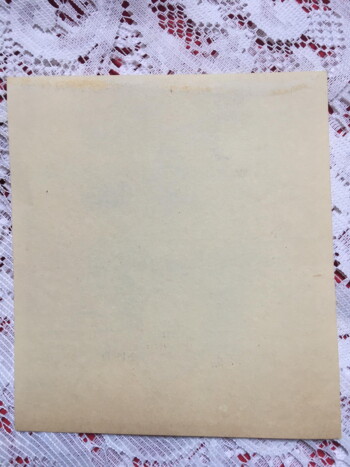
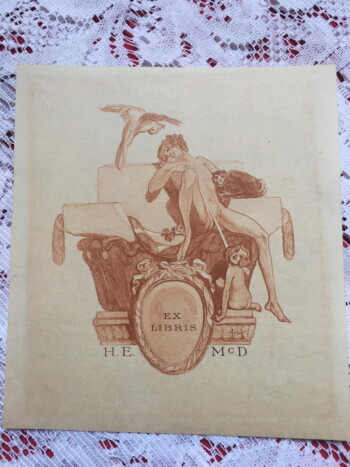 Ex Libris H.E. McD, by Franz von Bayros 4 x 4.5" red ink, previously pasted as evident by top part of back naked girl, animals, and child, presumably Ex libris for Horace E. McDonald Franz von Bayros (1866 – 1924) was an Austrian commercial artist, illustrator, and painter, now he is best known for his erotic work. He belonged to the Decadent movement in art, often utilizing erotic themes and phantasmagoric imagery. At the age 17, Bayros passed the entrance exam for the Vienna Academy with Eduard von Engerth. Bayros mixed in elegant society and soon belonged to the circle of friends of Johann Straub, whose step daughter Alice he married on 1896. The next year, Bayros moved to Munich. In 1904, Bayros gave his first exhibition in Munich, which was a great success. From 1904 until 1908, Bayros traveled to Paris and Italy for his studies. Typically, for an artist dealing with such imagery, von Bayros produced work under several pseudonyms, most notably Choisy Le Conin, and was hounded by authorities for much of his life for his “indecent” art often very imaginative, and including such taboo subjects as sadomasochism and bestiality. He became equally well-known for his masterly drawn figures of elegant modestly nude and non-nude women.
Ex Libris H.E. McD, by Franz von Bayros 4 x 4.5" red ink, previously pasted as evident by top part of back naked girl, animals, and child, presumably Ex libris for Horace E. McDonald Franz von Bayros (1866 – 1924) was an Austrian commercial artist, illustrator, and painter, now he is best known for his erotic work. He belonged to the Decadent movement in art, often utilizing erotic themes and phantasmagoric imagery. At the age 17, Bayros passed the entrance exam for the Vienna Academy with Eduard von Engerth. Bayros mixed in elegant society and soon belonged to the circle of friends of Johann Straub, whose step daughter Alice he married on 1896. The next year, Bayros moved to Munich. In 1904, Bayros gave his first exhibition in Munich, which was a great success. From 1904 until 1908, Bayros traveled to Paris and Italy for his studies. Typically, for an artist dealing with such imagery, von Bayros produced work under several pseudonyms, most notably Choisy Le Conin, and was hounded by authorities for much of his life for his “indecent” art often very imaginative, and including such taboo subjects as sadomasochism and bestiality. He became equally well-known for his masterly drawn figures of elegant modestly nude and non-nude women. -
Out of stock
 Ex Libris Giuseppe Cauti, by Franco Rognoni purchased from a collection in Italy. Naked woman being admired by men in top hats. Franco Rognoni (1913-1999) was an Italian artist and illustrator
Ex Libris Giuseppe Cauti, by Franco Rognoni purchased from a collection in Italy. Naked woman being admired by men in top hats. Franco Rognoni (1913-1999) was an Italian artist and illustrator












